This week for Flora and Fauna Friday we have our most diverse family of winter songbirds, the New World Sparrows of family Passerellidae.
Here in South Carolina there are about twenty-two species of New World Sparrows that one could reasonably expect to find somewhere in the state in a given year. However, we can whittle that down to about eleven species which one can readily find on Edisto Island. Sparrows as a whole are medium to small-sized songbirds with rather heavy triangular bills who feed primarily on seeds. They most often have cryptic, streaky plumages of browns, tans, grays, blacks, and whites. Their calls are generally short, sharp, and harsh and their songs high-pitched and clear. Most of our Sparrows our skittish and spend their lives in deep, brushy cover and thus are usually difficult to see. They are most plentiful and diverse in the winter months and there are almost always several individuals in any good habitat. I won’t go into all eleven common Lowcountry species today, which is a shame because there are a lot of interesting and rare sparrows one might run into out here with rather esoteric and nuanced field marks. (These confusing sparrow species are affectionately referred to as “LBJs”, little brown jobs, in the birding world.) Despite my desire for a skosh of brevity on this post, I will at least briefly cover our five most common and unique species of New World sparrow: Song Sparrow (Melospiza melodia), Chipping Sparrow (Spizella passerina), White-throated Sparrow (Zonotrichia albicollis), Seaside Sparrow (Ammodramus maritimus), and Eastern Towhee (Pipilo erythrophthalmus).
The Song Sparrow is what I would call our standard Sparrow. It’s about dead-center in the size range with fairly typical calls, songs, and habits. Its appearance is non-descript, highly varied, and well camouflaged but with discernable field marks. It’s also a generalist and very common, so it can be found in a wide range of habitats intermixed with other sparrow species. Thus, it’s a good standard by which to compare all our other sparrow species. Song Sparrows can be found in almost any grassy or brushy habitat and have a preference for ditches, wetland margins, and other edge habitats. Their plumage is primarily comprised of warm brown streaks on a gray back and white breast. It has a pale eyebrow, heavy flank streaks, and a prominent blob of brown smack in the center of its chest. The Song Sparrow’s most common call is short, loud, and a bit hoarse. It’s described less as a typical sparrow “chip” and more of a “chimp”. If you have a good ear, this call is more than enough to identify a Song Sparrow.
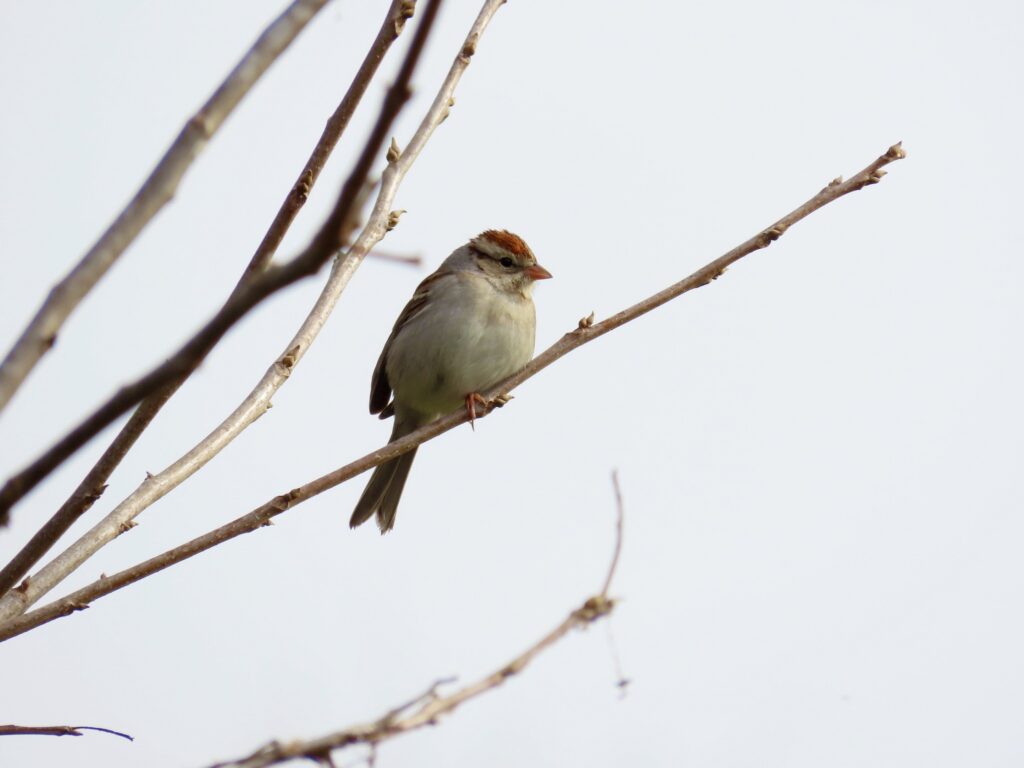
The Chipping Sparrow is our most numerous sparrow in suburban habitats and is also quite common in open pine savannas. They prefer sparse grassy areas and bare ground. They usually move in flocks of a dozen or more birds. They are one of our smallest sparrows and their plumage stands out for its simplicity. On top they have a rusty cap, prominent pale eyebrow, a dark eye-stripe, and a brindled back of black and warm-brown. Below, they are a uniform aluminum-gray. Chipping Sparrows are regular feeder birds and often saturate yard feeders all winter. Their call is a quiet and very high-pitched “chip” and their song a rapid-fire trill of high-pitched monotone notes.

The White-throated Sparrow is by far our most common woodland sparrow. They can be found in likely every upland brush pile, thicket, field edge, and clear-cut on the Island. They prefer to stay in deep cover whenever possible and can be difficult to get a good look at, but you can easily hear them chipping and scratching leaves from beneath. When you do lay eyes on one, they’re quite easy to identify. White-throated Sparrows are on the large side for a sparrow and sport some distinct facial markings: a snow-white throat, bright-white eyebrows, a dark cap with a pale line through it, and yolk-yellow patches just in front of the eyes. They also have an unmarked, pale-gray underside and a warm-brown back. Their song is flute-like and distinct and their calls high-pitched, often with an anxious or frantic intonation.
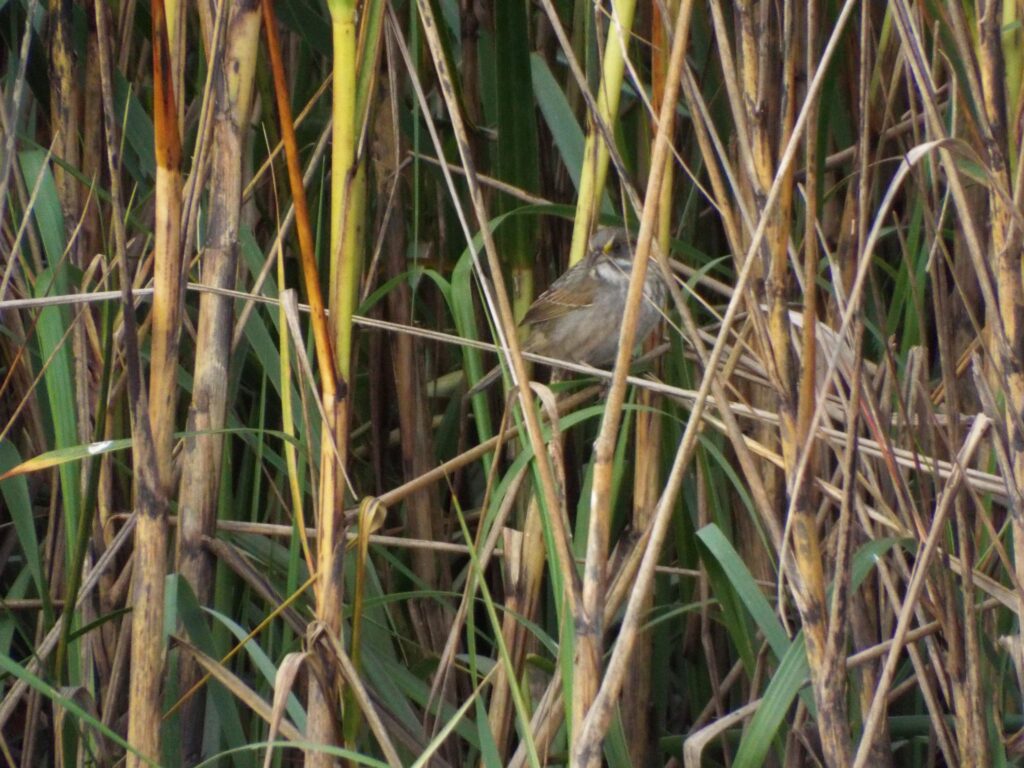
The Seaside Sparrow is notable for a few reasons. One, it’s one of our few resident species of sparrow that can be found here year-round and, two, it’s specially adapted for life in the salt marsh. The Seaside Sparrow can be found all throughout the salt marshes of Edisto Island and the Lowcountry, most often surrounding hammock islands, causeways, and upland margins. It feeds beneath the marsh grass and retreats to the high marsh on high tides or to hammock islands and marsh fringes during king-tides and storm surges. These birds are common but very skittish and difficult to see unless flushed at a high tide. In the winter their numbers are bolstered by migratory subspecies who come to snowbird alongside our resident Macgillivray’s subspecies. The Macgillivray’s Seaside Sparrow is a large sparrow with a notably short, ragged tail. Their plumage is distinctly a muddy dark gray with faint accents of neutral-browns and blacks. This is contrasted with a white throat and lemon-yellow patches in the eyebrows. Their songs and calls are somewhat non-descript and often difficult to hear in the field over the roar of the sea breeze, the rumble of boat motors, and the caterwauling of blackbirds and grackles.
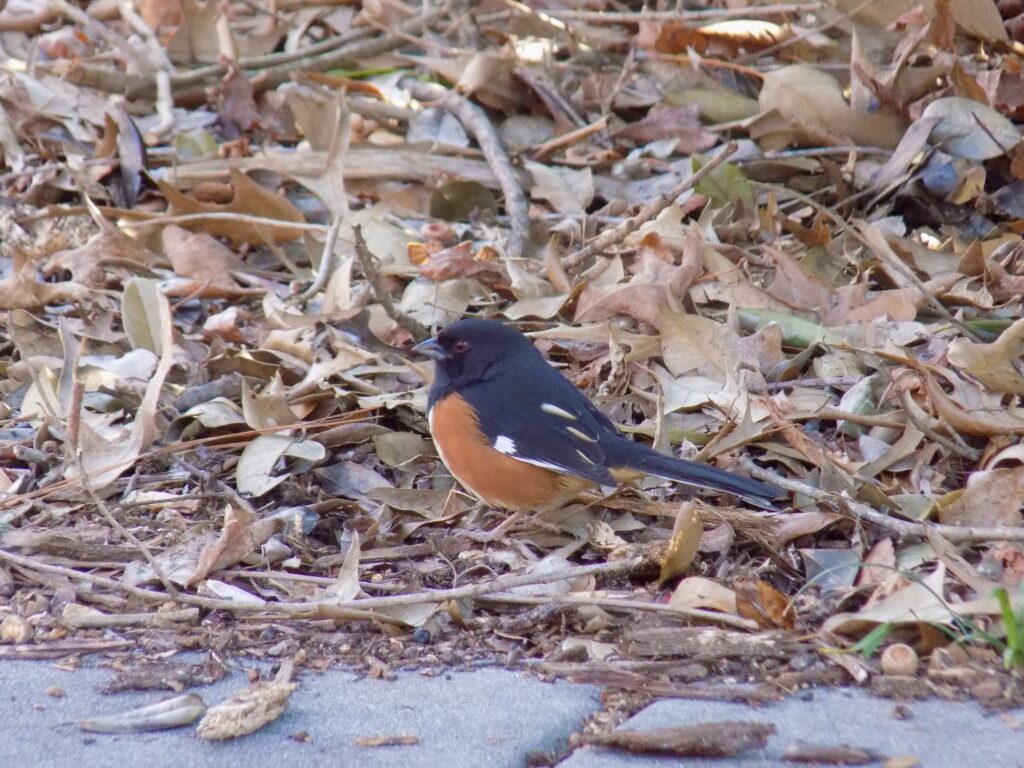
The Eastern Towhee is our most standout sparrow in many regards. It’s our largest sparrow with a striking appearance, distinct calls and songs, and it’s a year-round resident of South Carolina. The Eastern Towhee can be found in a wide range of brushy habitats but has a preference for tall thickets and bushes that create a canopy of cover. They’re scratch feeders who root around for food beneath the leaf litter. Their appearance is unmistakable. Males sport an ink-black back, head, and breast and females the same but a mocha-brown. Their flanks are a solid rust-red and their belly a pure-white. White accents can also be spotted at the wrist of the wing and on the outside tail feathers. Most have a deep, blood-red eye but some coastal populations belong to a subspecies with a sharp, yellow eye. The song of the Eastern Towhee is an easily recognized “Drink-your-Tea” with the “tea” rolling into a trill. Their most common call is a namesake slurred “tow-hee”.
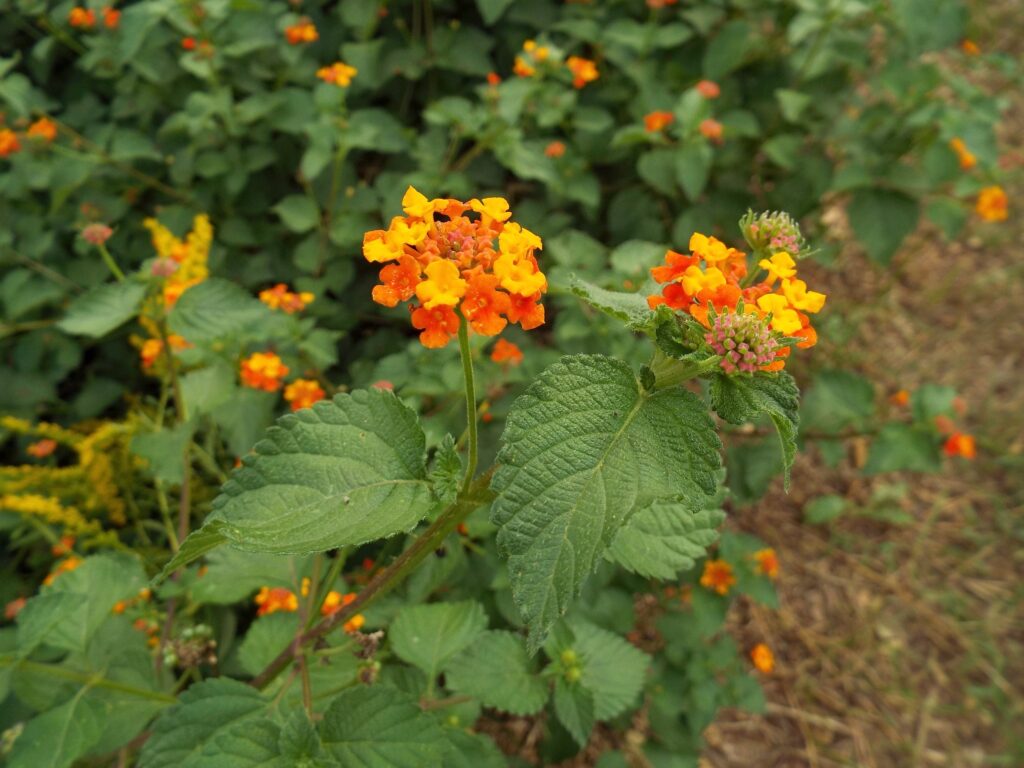
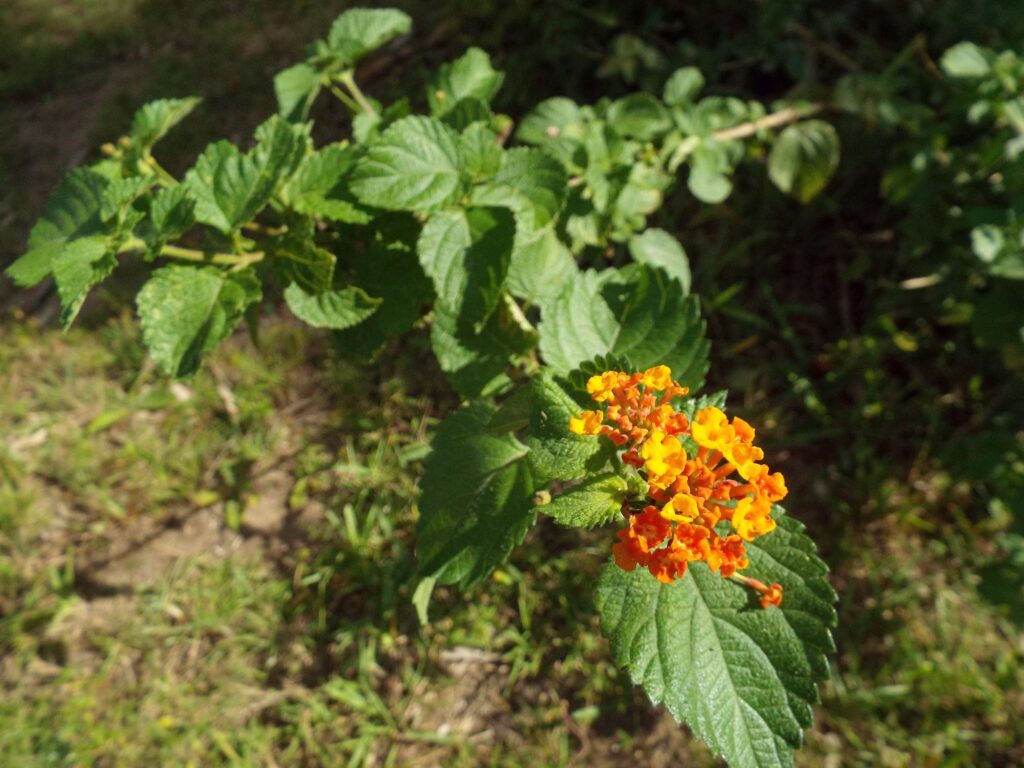
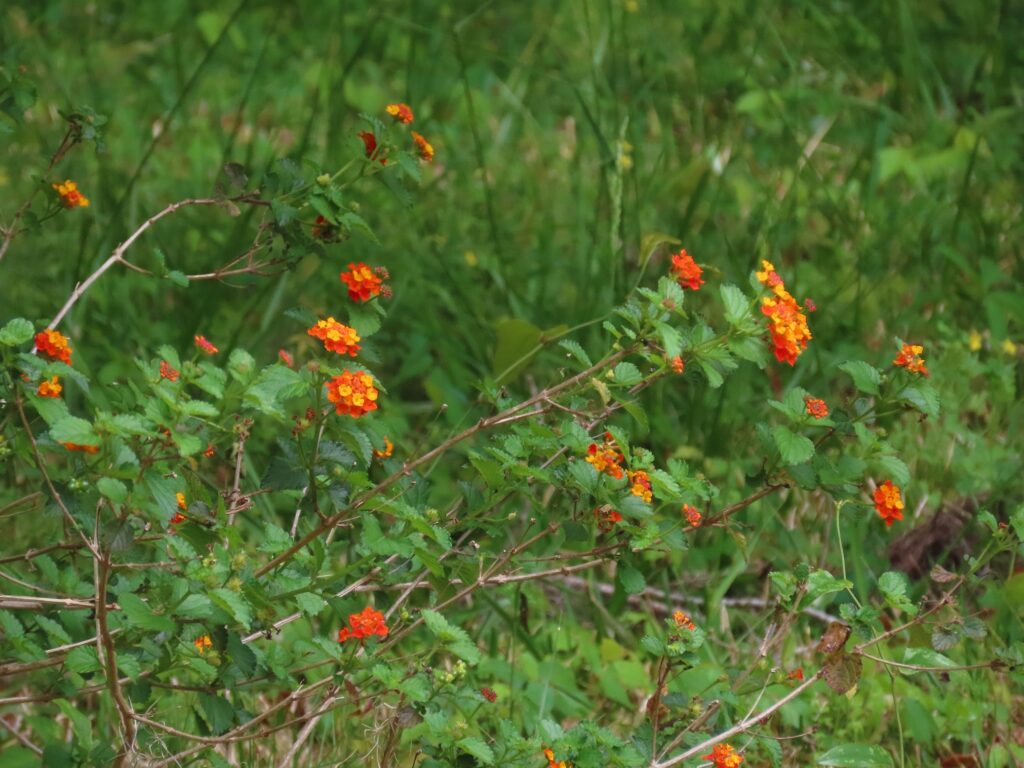
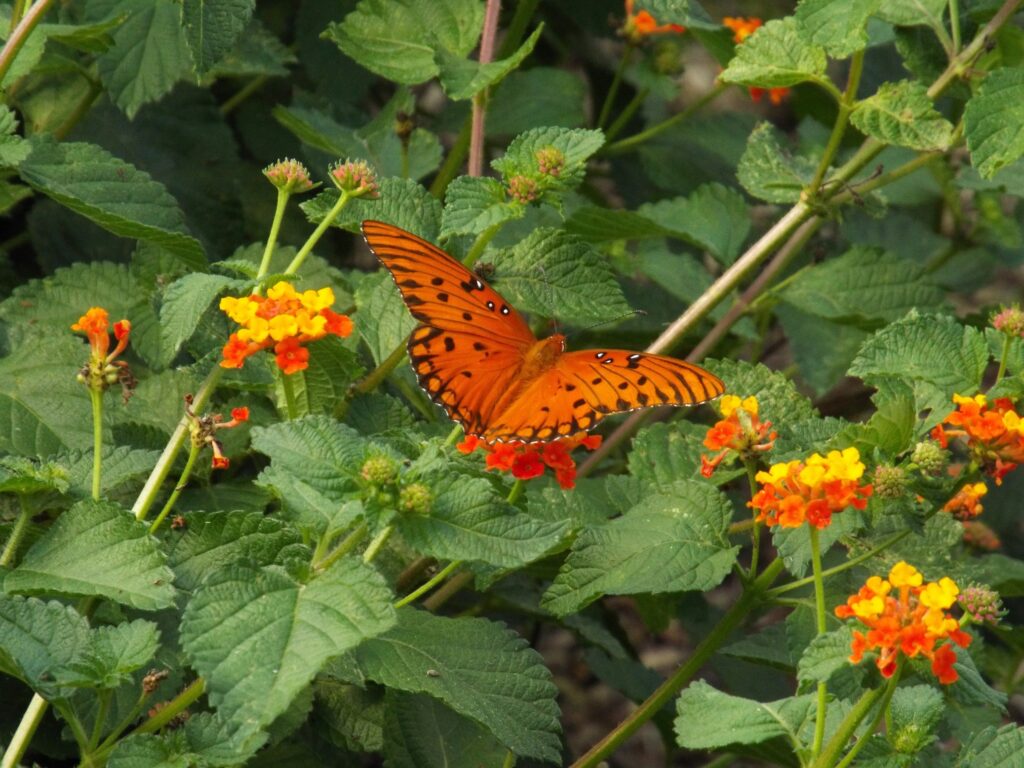
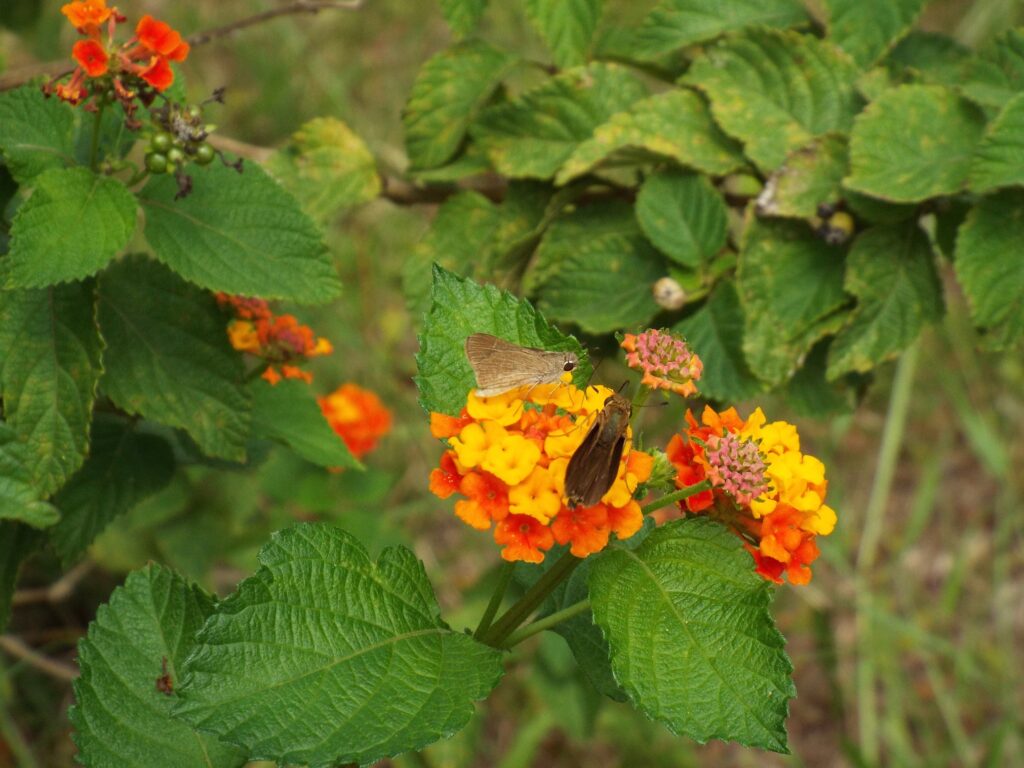
This week for Flora and Fauna Friday we have a popular flowering shrub with a two-faced existence, Common Lantana (Lantana camara).
Lantana is a genus of tropical, flowering shrubs in the Verbena family (Verbenaceae), which are native to the American tropics. Common Lantana, the species we’re focusing on today, which I’m just going to refer to as “Lantana”, is native to Central America and coastal South America. It’s not native to the United States but is naturalized to the Lowcountry. Common Lantana is a woody shrub with a round, dome-like growth habit. It’s very hardy and will tolerate drought, poor soil nutrition, and some salt intrusion. The bark of Lantana is flat and textured like sandpaper and colored a green-tinted tan. Stems can either be smooth or armed with prickles and irritating hairs. The leaves of Lantana are emerald green and spade-shaped with sunken veins and fine hairs. Lantana is a common ornamental here in the Southeast and comes in a wide array of varieties, hybrids, and cultivars. These cultivars differ primarily in their flower color but also in their size and vigor. Some cultivars can be quite large, reaching head height while others grow only knee high. Being a tropical plant, Lantana is not very cold hardy and will die back to its main trunk after a hard frost but will sometimes persist throughout our mild Sea Island winters. The flowers of Lantana are its most impressive feature. The flowers of different cultivars range in color from the vibrant gold and blood-orange of the more wild plants to the more contrasting lemon-yellow and hot-pink of some older varieties, to more modern white, yellow, and red cultivars. Apart from their ornamental value, Lantana is also a tremendous nectar plant for butterflies. Lantana will bloom from mid-spring clear until first frost and is a strongly preferred nectar plant by large and medium-sized butterflies. It’s also visited by hummingbirds and other nectar-seeking pollinators. The fruit of Lantana is a cluster of small, metallic blue-black berries. However, there’s another side to Lantana we don’t see often here on Edisto.
Common Lantana is an invasive species. It causes substantial economic and ecological damage in more tropical states, like Florida and Texas, where it robs nutrients from orchards, poisons livestock, chokes out native plants, and takes over grasslands. It has spread throughout the tropics of the world and causes significant ecological and agricultural damage in Africa, India, and Australia. However, here on Edisto Island and in the Lowcountry we are on edge of its naturalized range in the United States and our mild winters with consistent freezes keep Lantana from spreading rapidly and forming thickets in the state, except for open areas on our barrier islands and other edge cases. In this limited capacity, it does displace native Barrier Island species but at the same time it also has a somewhat balancing benefit to native wildlife. On the mainland it rarely causes issues in our Lowcountry ecosystems.
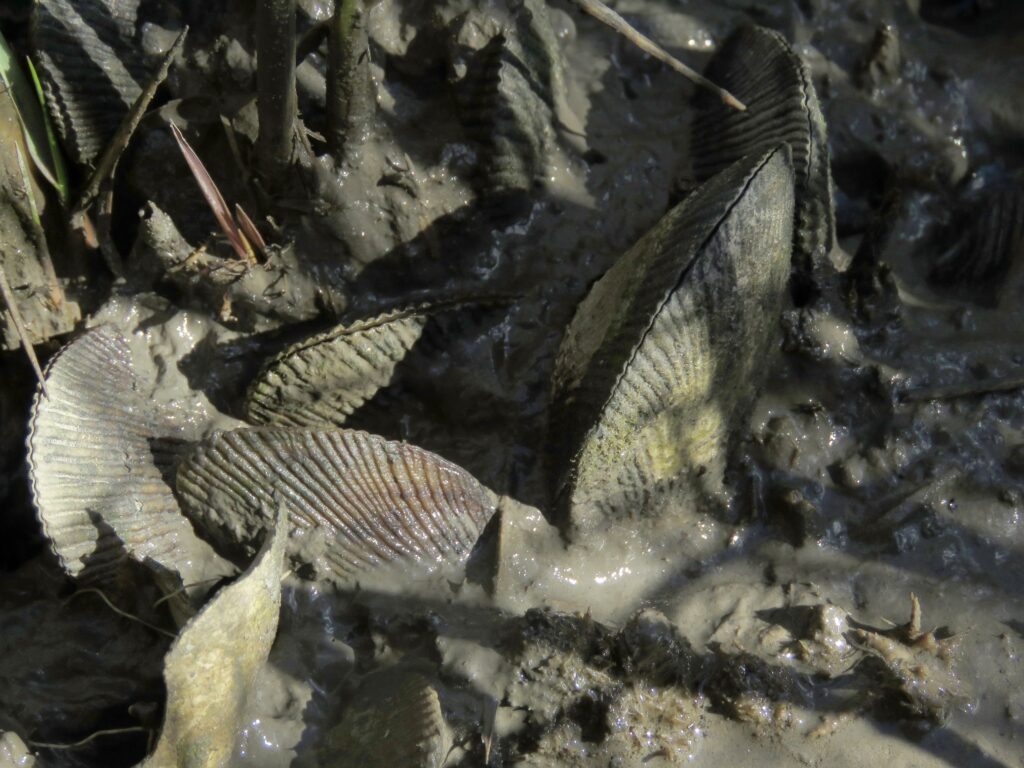
This week for Flora and Fauna Friday it’s our other mud-loving, tidal bivalve, the Atlantic Ribbed Mussel (Geukensia demissa).
Atlantic Ribbed Mussels live throughout our tidal estuaries on Edisto Island. They range in size up to four inches in length and have a thin-walled, sandal-shaped shell that’s a dark-green-brown and striped with fine, longitudinal ribs. Ribbed Mussels inhabit the low saltmarsh, attaching themselves as larvae to base of Smooth Cordgrass stalks. Overtime, many coalesce and grow into small clusters and, as they grow larger, they can bury themselves partially in the pluff-mud. Unlike Oysters and Barnacles, Atlantic Ribbed Mussels don’t permanently join their shells to the structure they attach to. Instead, these Mussels grow flexible fibers from the rear of their shell that can glue it to grass, wood, shell, or rock. If they become dislodged, they can reattach themselves to a new surface. Mussels are filter feeders, just like Oysters, and play an important role in filtering run-off, sequestering pollutants, and stabilizing sediment in our saltmarshes. However, Ribbed Mussels don’t get the recognition they deserve due to their invisibility, as it’s hard to notice a brown mollusk half buried in mud, submerged in saltwater, underneath a great expanse of grass. Also they don’t get much press because they’re not a culinary delicacy. Atlantic Ribbed Mussels are edible but hard to collect and not always safe to eat. They’re generally risky to eat in the modern world due to their ability to sequester chemical pollutants filtering through the saltmarsh. Also, even in pristine waters, it’s recommended to harvest them only at hide-tide, given that they can concentrate waste and environmental toxins inside their watertight shell during low-tide. Given all those caveats, I think we’re better off leaving the Mussels be and enjoying the other bounties of the sea. They’ve got an important job to do.
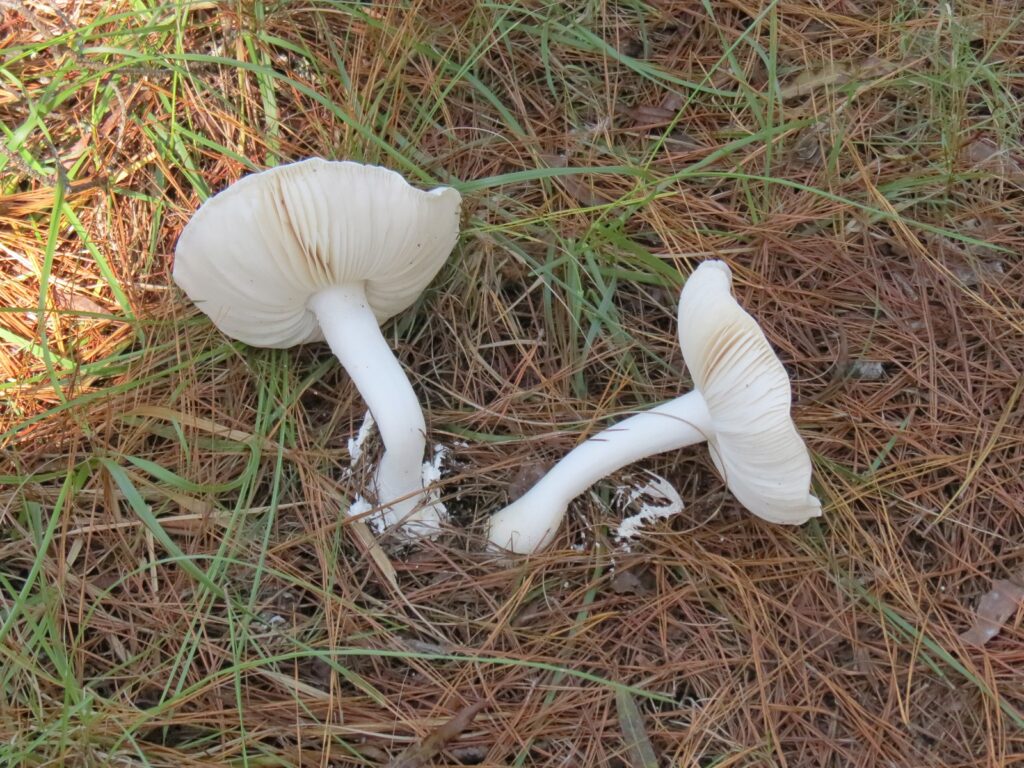

This week for Flora and Fauna Friday we have a genus of common woodland mushrooms with a dark side, the Amanitas.
Amanitas are one of the prototypical fungi we conjure up in our heads when someone says the word “mushroom”. It’s a diverse genus with over a hundred species found in North America. I’m far from a fungus fanatic, so I’m mostly going to stay at a general genus level today. Amanitas’ fruiting bodies, what we lay folk call mushrooms, are agaric in shape. Agaric mushrooms have a prominent and distinctly separate cap with gills held up by a stalk, AKA a toadstool. The size, shape, texture, and color of Amanita mushrooms varies greatly. Many have caps that are white or are a pale-beige but others can be a vibrant red or yellow or conversely a muted brown, gray, or peach. Their texture can be scaly, warty, ribbed, or smooth. Yet in general, the Amanita cap tends to be broad and nearly flat and the stalk is usually lightly-colored, tall, and narrow but not delicate. The stalks also commonly have a skirt under the cap, called an annulus, which is the remains of the membrane that protected the gills during emergence. Amanita mushrooms emerge throughout the year, depending on local habitat conditions and the phenology of different species, but they can most commonly be seen in fall and early winter.
The members of the Amanita genus are all ectomycorrhizal, meaning they join into mutualistic relationships with plants, predominantly trees, by forming a sheath around the plant’s roots underground. The fungus provides the plant with extra nutrients it scoured from the soil and the tree helps feed the fungus in exchange for the salvage work. Due to how common Amanitas are and the significance of mycorrhizal relationships in forest ecology, this genus plays a critical role in keeping our forests healthy. Many species of wildlife also feed on Amanitas and other mushrooms, including squirrels, deer, mice, box turtles, feral hogs, and black bear.
Some species of Amanita are edible for humans as well. However, many Amanita species are far from edible and the genus contains several of the deadliest fungi known to science. The Eastern North American Destroying Angel (Amanita bisporigera) is the most toxic mushroom native to the United States and found in forests throughout South Carolina. Its mushrooms are a smooth, uniform, colorless white. The Death Cap (Amanita phalloides) is native to Europe but has established throughout the United States through the transplanting of tree rootstocks. It is responsible for the majority of all fatal mushroom poisonings globally. The Death Cap mushroom is relatively large in size with a smooth, brass colored cap. Eating either of these two Amanita species causes liver failure. There are other toxic Amanita species as well. Many of the edible species look very similar to the toxic ones, so it is strongly recommended, by practically everyone, that if you have an interest in foraging for edible mushrooms, that all Amanitas be avoided unless you are absolutely, 100% certain of your identification.
This week for Flora and Fauna Friday we’re serenaded by a trio of tongue-twisted songbirds, the Mimics of family Mimidae.
Here in South Carolina we have three species of Mimic, the Northern Mockingbird (Mimus polyglottos), the Brown Thrasher (Toxostoma rufum), and the Gray Catbird (Dumetella carolinensis). The trio are common in the Lowcountry and can be found across Edisto Island all year-round. All three are on the larger side for songbirds, subsist off a diet of primarily invertebrates and fruits, often move and feed on the ground, and can mimic the calls of other birds. However, each has its own seasonality, habitat preference, personality, and vocal repertoire.
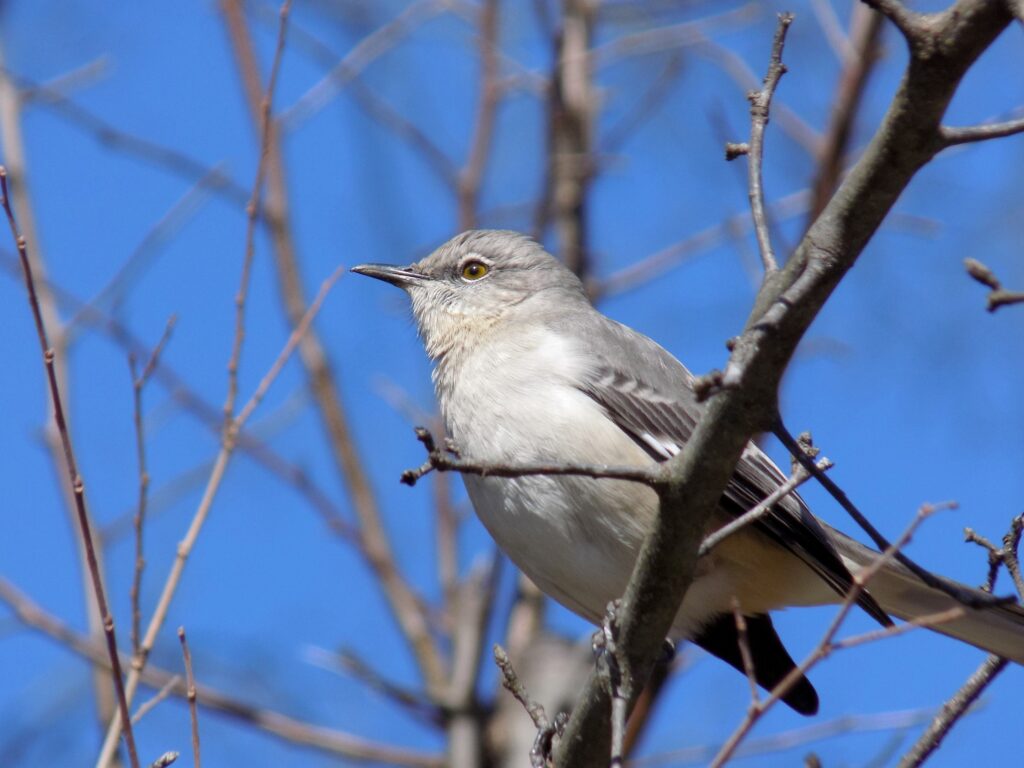
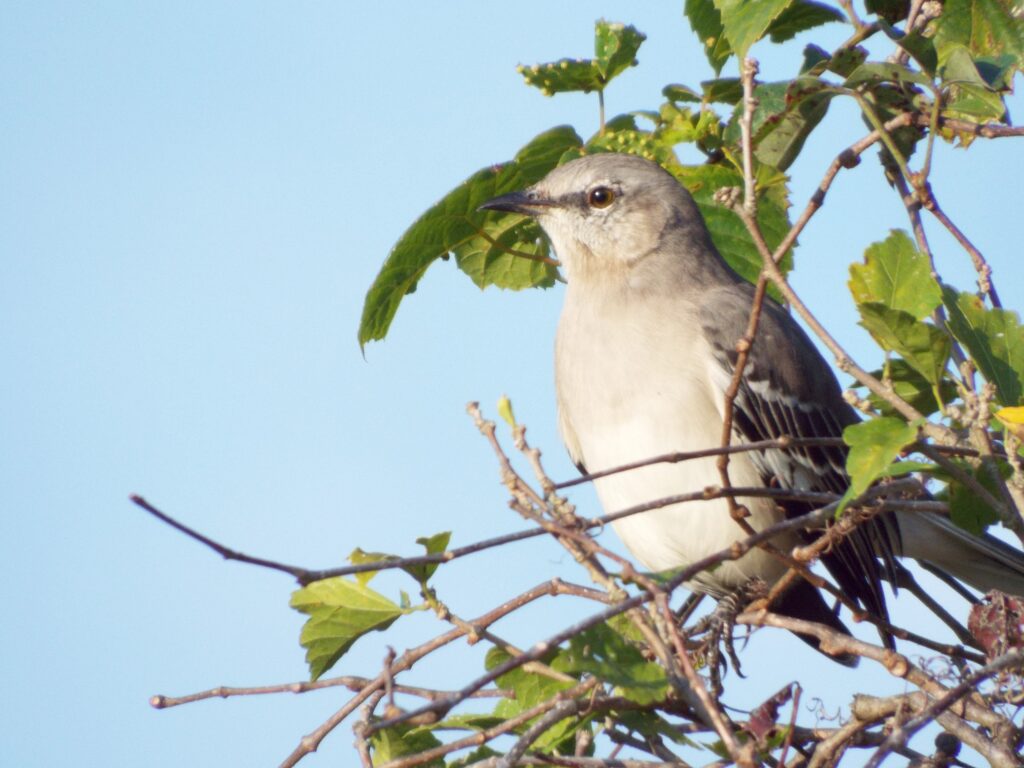
The Northern Mockingbird is by far our most easily seen mimic. They are non-migratory and territorial. Their plumage is a subtle selection of silvery-white, aluminum-gray, and charcoal-black with a brass-yellow eye. The Mockingbird prefers open, cleared habitat and is an accomplished generalist. They’ve taken well to farmland, clear-cuts, suburbs, and urban parks where we keep the grass low and ringed with shrubs, just how they like it. They can often be spotted running along the ground catching bugs or perched atop a palmetto, street light, roof eave, tree limb, or anywhere that’s ten to twenty feet up. Males are particularly territorial and spend much of their time singing away their own custom mixtape of remixed bird songs sampled from the neighborhood or screeching and fighting with other birds. Mockingbirds are our most adept at mimicry and can flawlessly imitate the calls of many species. However, they generally don’t mimic the entire call and repeat the same phrase three or more times in a row before switching subjects. The call of the Mockingbird is a sharp, harsh sound like someone sucking their teeth. Mockingbirds are also especially feisty when it comes to threats and are religious about their harassment of hawks, owls, snakes, and house cats that intrude on their turf.

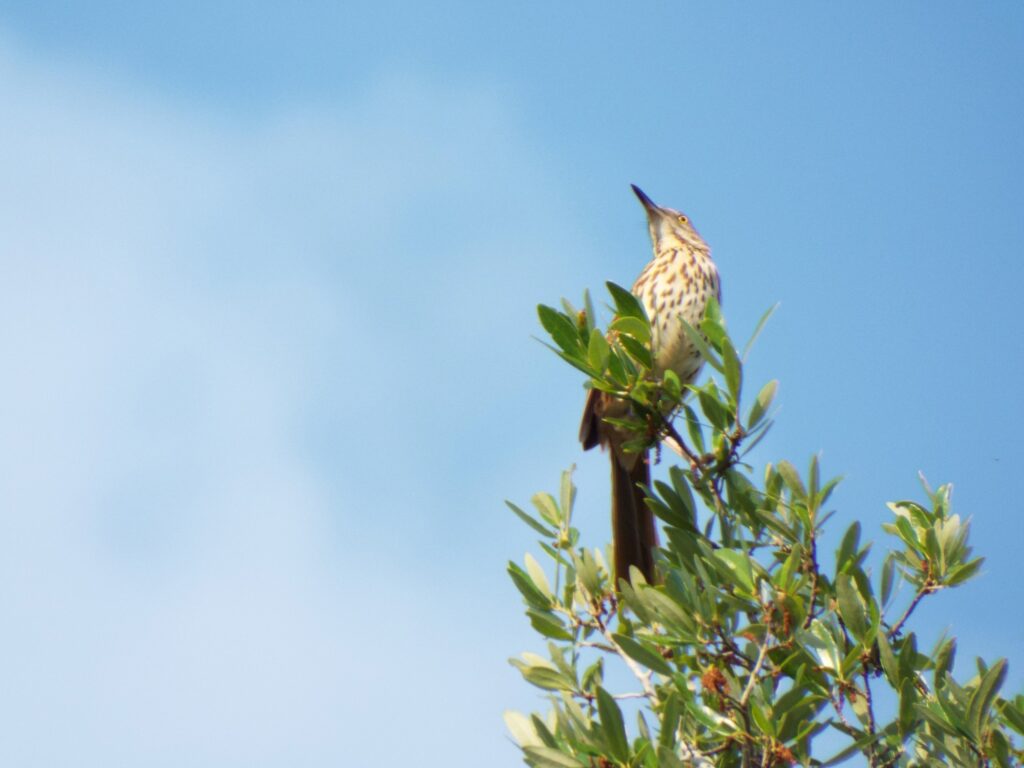
The Brown Thrasher is our largest bodied Mimic. They’re about as common as the Mockingbird in rural areas but their numbers increase in winter as some Thrashers migrate south. The Brown Thrasher is a warm rusty-brown up top contrasted by an eggshell-white breast seasoned by walnut-brown spots and a piercing yolk-yellow eye. They prefer brushy, forested habitats and are much harder to spot in the wild because of it. Brown Thrashers spend much of their time foraging in the leaf litter under dense brush and thickets, particularly Azaleas in residential settings. They’re most easily spotted scratching along the ground or singing way up high in the tree canopy, some thirty to forty foot off the ground. The Brown Thrasher is a decent mimic but their renditions tend to be a bit raspy, cut-short, and low-fidelity, and are usually repeated just one to two times before changing. The call of our Thrasher is that same suck-tooth sound like the Mockingbird but a touch shorter and raspier.
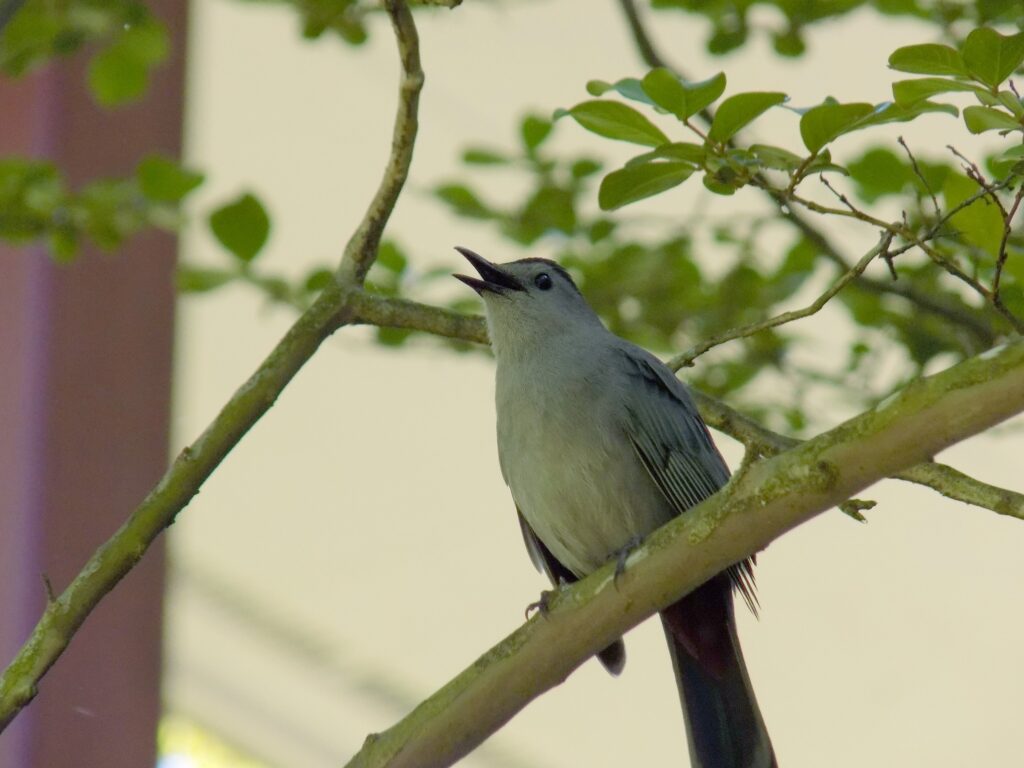
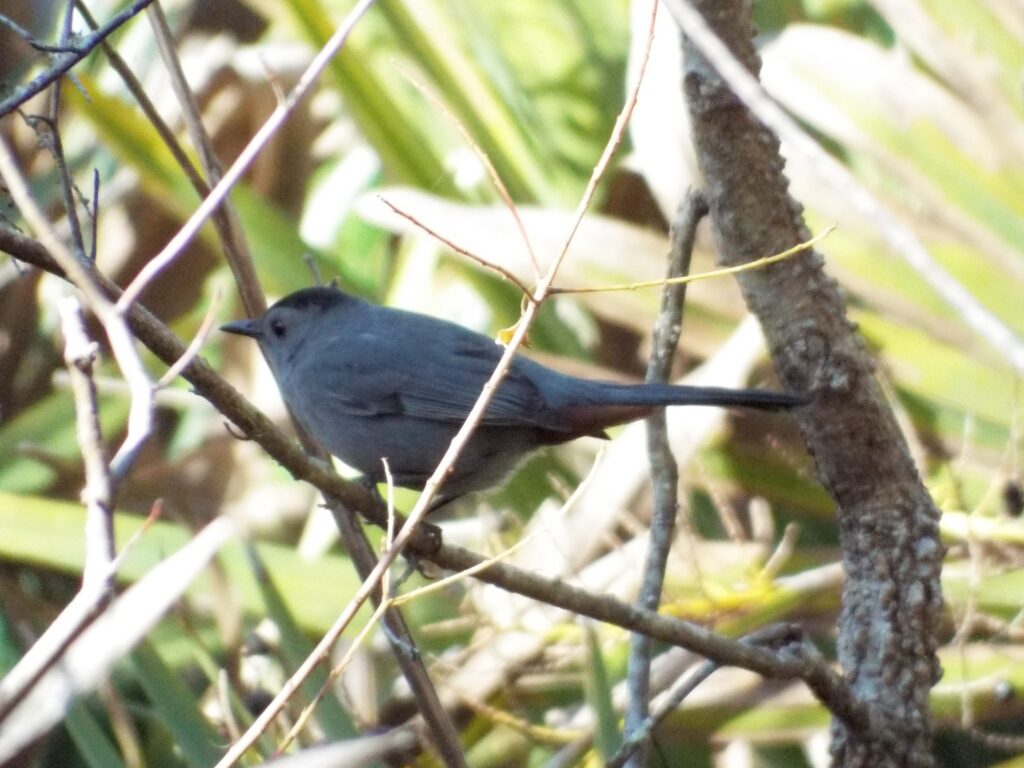
The Gray Catbird is the smallest of the three and the most seasonal. In summer, they are our scarcest Mimic but during winter and over migration they are overwhelmingly our most common. The Gray Catbird is a bluish to phosphate-gray across much of its body with a charcoal-black cap and tail-tip, walnut-brown under-tail, and a nearly black eye. The Gray Catbird is found in dense, wet, brushy habitats like the fringes of saltmarsh, freshwater marshes, field ditches, windrows, thickets, clear-cuts, and brush piles. Catbirds stay low to the ground and rarely leave cover. They’re curious but shy, often moving out to the edges of shrubs to investigate but disappearing back out of sight after a few seconds. Gray Catbirds don’t so much mimic as take inspiration from the world around them. They don’t usually repeat phrases and those phrases and notes are only sometimes reminiscent of other species. The call of the Catbird is a unique and unmistakable begging “meow” of a cat, albeit a cat that sounds a little hoarse.
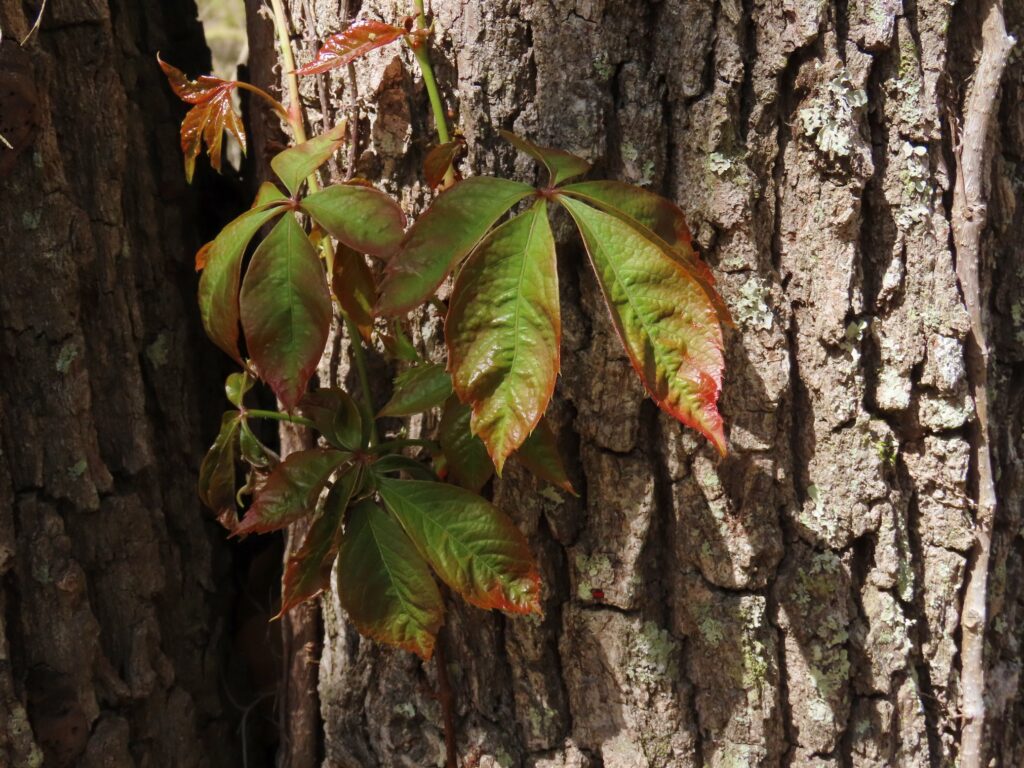
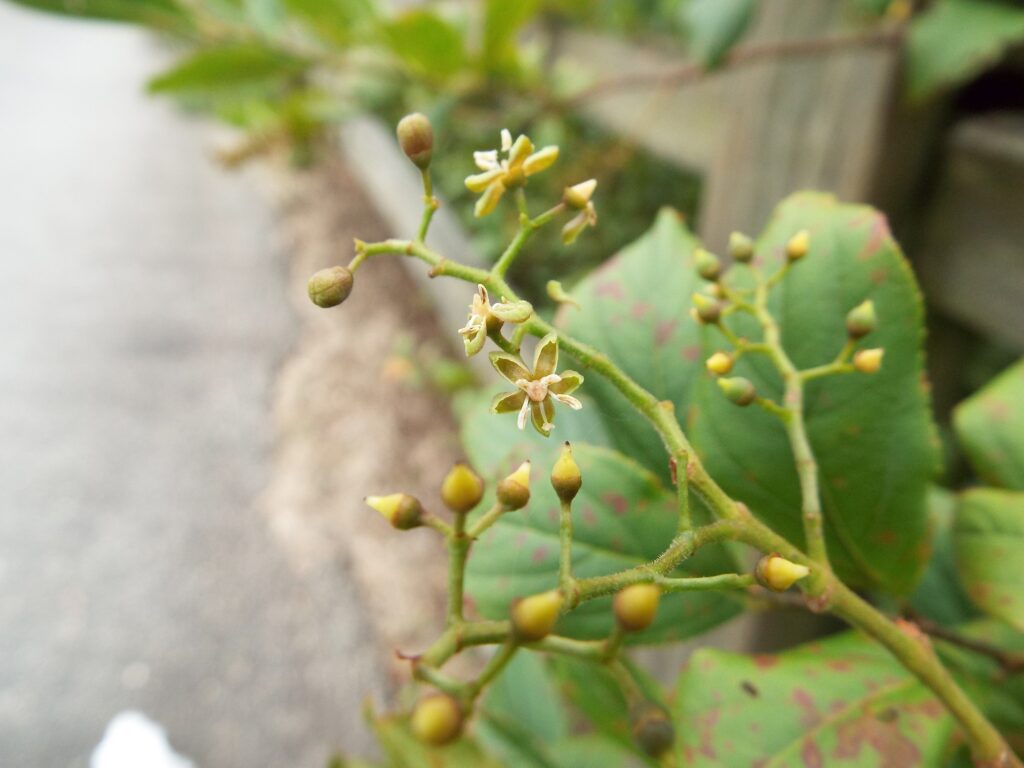
This week for Flora and Fauna Friday it’s another one of our tree-climbing vines and one with standout fall foliage, Virginia Creeper (Parthenocissus quinquefolia).
Virginia Creeper is a member of the Grape family and a common vine throughout South Carolina. It will grow in most any soil and tolerates both full sun and heavy shade. This vine is most easily identified by its leaves, which are separated into five pointed leaflets branching out from a central point. The stem of Virginia creeper is relatively thin with a coarse bark of grayish-brown and occasionally has thick rootlets emerging from it. Virginia Creeper is often confused with Poison-Ivy, especially in winter, but Creeper’s un-hairy stem will let you tell the two apart. Virginia Creeper blooms in late April with clusters of delicate, inconspicuous green flowers that mature into small, deep blue berries. These flowers are well-visited by pollinators and the berries are enjoyed by birds, who then carry its seeds to distant trees and shrubs.
Virginia Creeper can grow either as a groundcover, when there’s nothing around to climb, or more commonly as a vine. One of the more impressive characteristics of Virginia Creeper is its ability to climb. Unlike other vines that climb with wrapping tendrils or burrowing rootlets, Virginia Creeper uses adhesive pads at the tips of its tendrils in addition to their grappling twist. This lets the plant get a solid grip on practically anything, regardless of its texture. Due to this trait, Virginia Creeper is especially good at growing along the sprawling limbs of Live Oaks, the arrow straight trunks of Pines, and also on houses, metal buildings, vehicles, and other slick-sided human structures. Here in the Lowcountry, where fall starts in December and winter is sometimes a suggestion, Virginia Creeper is one of the first plants to change color, and it does so with gusto! In early autumn the leaves of Virginia Creeper turn a pure and vibrant crimson-red. Here on the evergreen Live Oak laden Sea Islands, you can stand in a field or on the edge of the marsh in fall and easily pick out every tree strung with a Virginia Creeper vine as far as the eye can see in any direction!
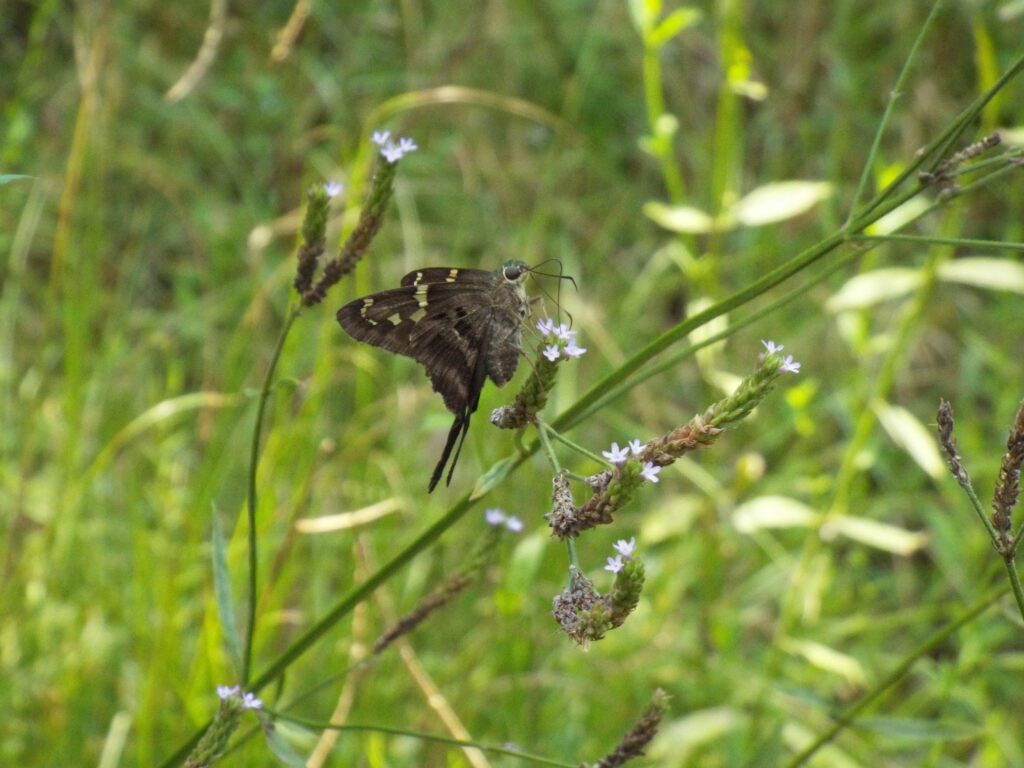
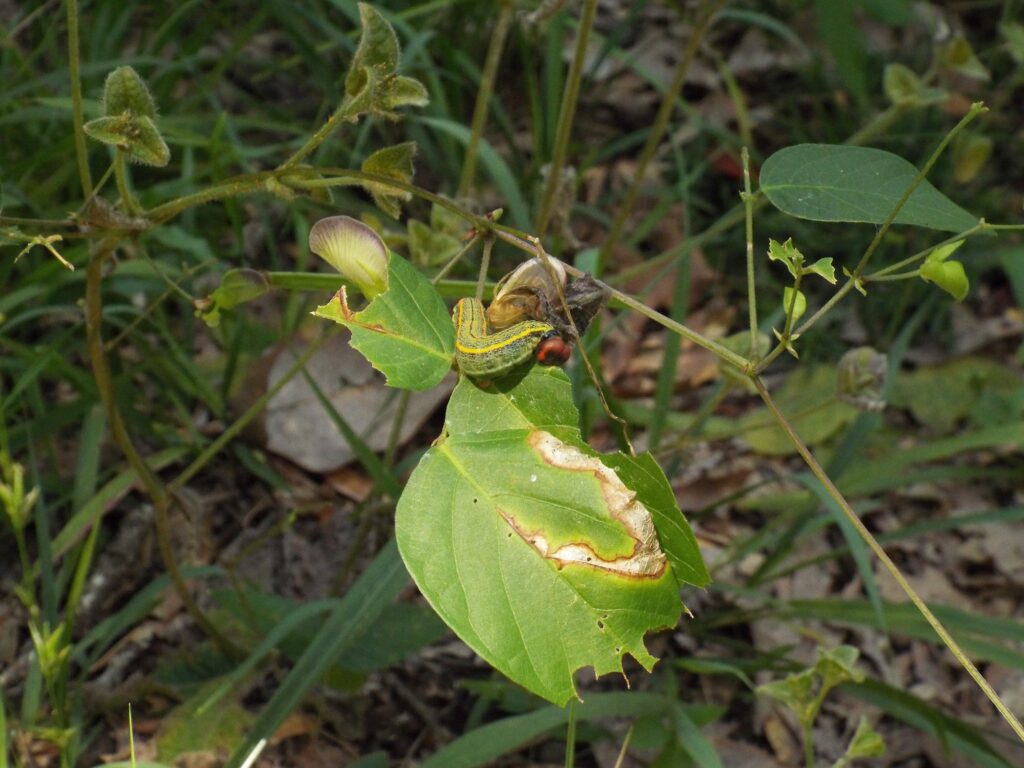


This week we have a short tale about a butterfly with long tails, the Long-tailed Skipper (Urbanus proteus).
The Long-tailed Skipper is a medium-sized butterfly, but large for a Skipper, which is the family of small-winged, fast-flying butterflies to which it belongs. This butterfly holds its triangular wings outward at a forty-five degree angle from its body. Those wings are colored a neutral grayish-brown below with ebony bands across the hindwing and ivory spots near the tip of the forewing. This hindwing trails downward into a long tail hanging out beyond the end of its abdomen, which became this species’ namesake. On the upper side an unexpected blast of brass and iridescent turquoise saturates the body and inner wings of the Long-tailed Skipper. Towards the edges of the wings a warmly-toned brown emerges and those translucent ivory spots from below show through. The Long-tailed Skipper sports the most easily seen blue of all our native butterflies, as most hide their brilliant blues behind closed wings.
The Long-tailed Skipper is commonly found anywhere there is nectar but is particularly fond of brushy woodland edges, pine savannas, and vegetable gardens. The reason being is that its caterpillars host on many species of legumes, most commonly vining species. Larval host plants include wild plants like the aptly named Butterfly Pea (Clitoria mariana), our American Wisteria (Wisteria frutescens), and several species of Beggar’s-Ticks (Desmodium spp.) as well as many agricultural crops such as the common Garden Bean (Phaseolus vulgaris) and Cowpea (Vigna unguiculata). Because of their affinity for all things bean, they’ve also earned the moniker of Bean Leafroller. This name comes from the defensive strategy employed by their caterpillars, in which they chew out the ends of a section of leaf and then fold it over on top of themselves to hide from predators. As they get larger, they eventually fold over entire leaves like a taco and glue the edges together with silk. Their caterpillar is a mottled green with a prominent yellow stripe down each flank and a black head with red cheeks. In more tropical climates, they can become a significant agricultural pest.
The Long-tailed Skipper is a very common species here on Edisto Island from late summer until the end of the year but their abundance increases dramatically the later in the year it gets. This is because the Long-tailed skipper is one of our many tropical migrant butterflies. As their populations swell in Florida, they gradually, and then rapidly, push north up the coast in search of new habitat, eventually saturating the state.
Our 2022 Oyster Roast was a rousing success! Thank you to everyone who made it out to support EIOLT, to Calvert Huffines and all our amazing sponsors who helped make it a reality, to Jamie Westendorff and Ella & Ollies for providing the delicious food and oysters, and of course a big thank you to Mark & Tucker Crawford for hosting us at Sand Creek Farm once again!
Check out the below photo gallery from the Oyster Roast:
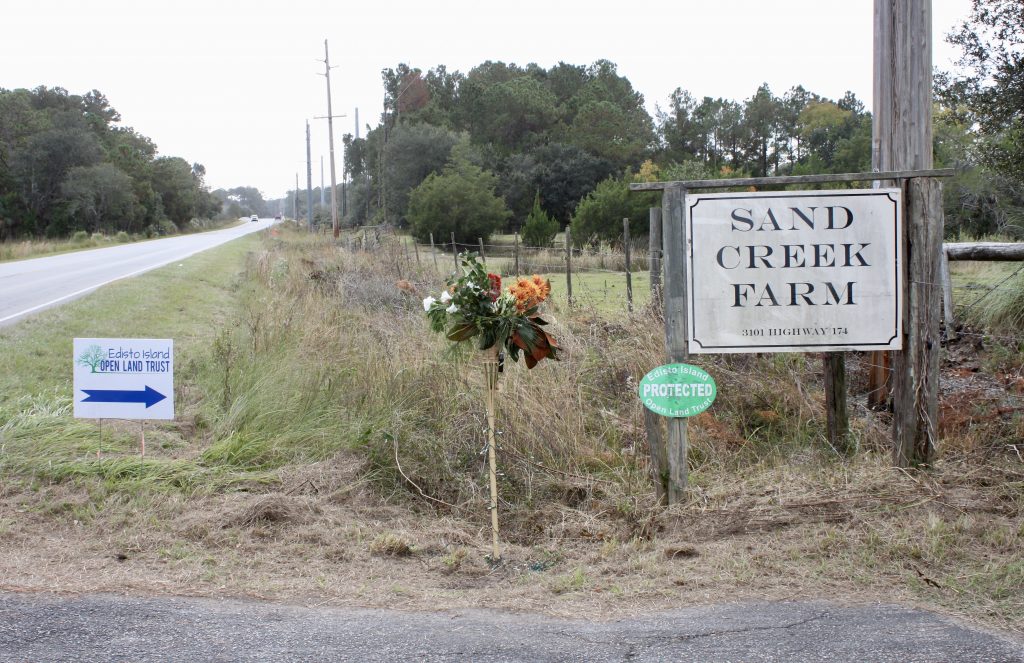
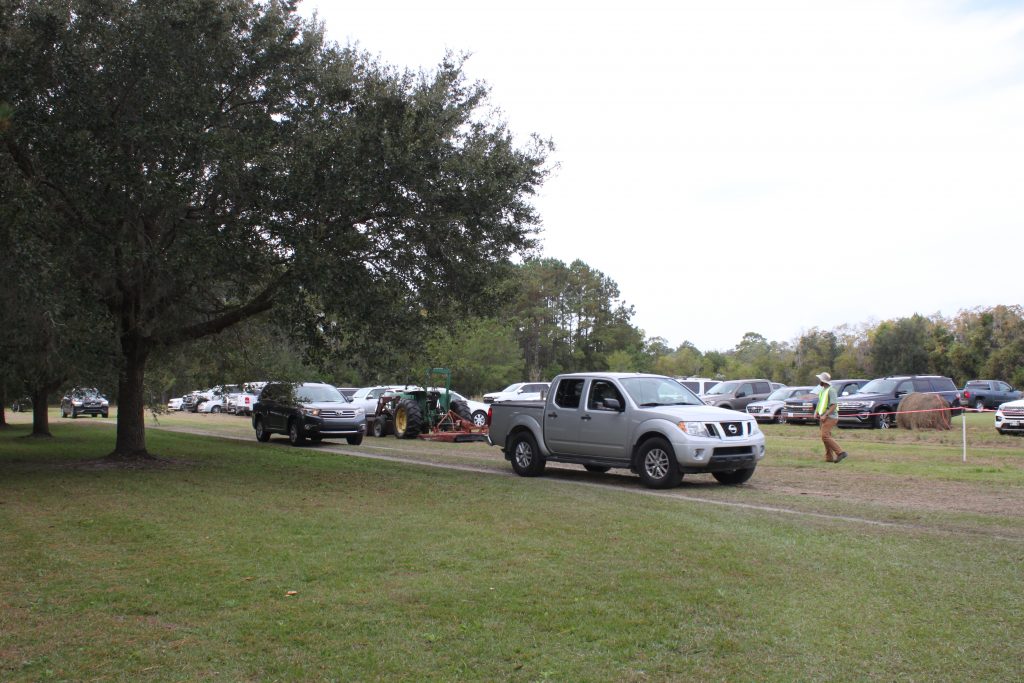
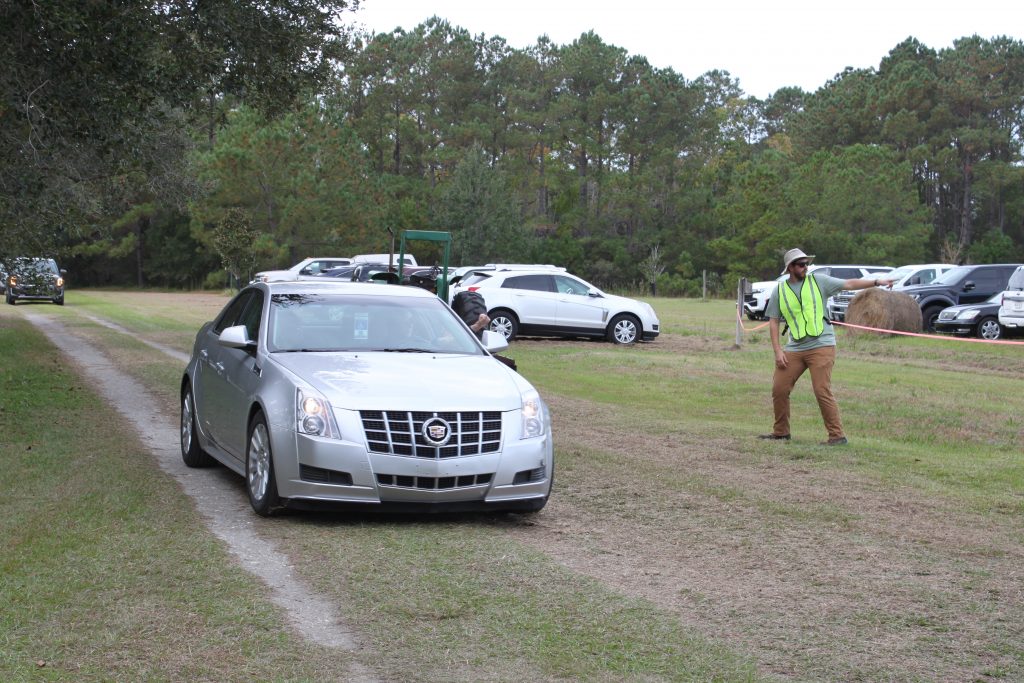

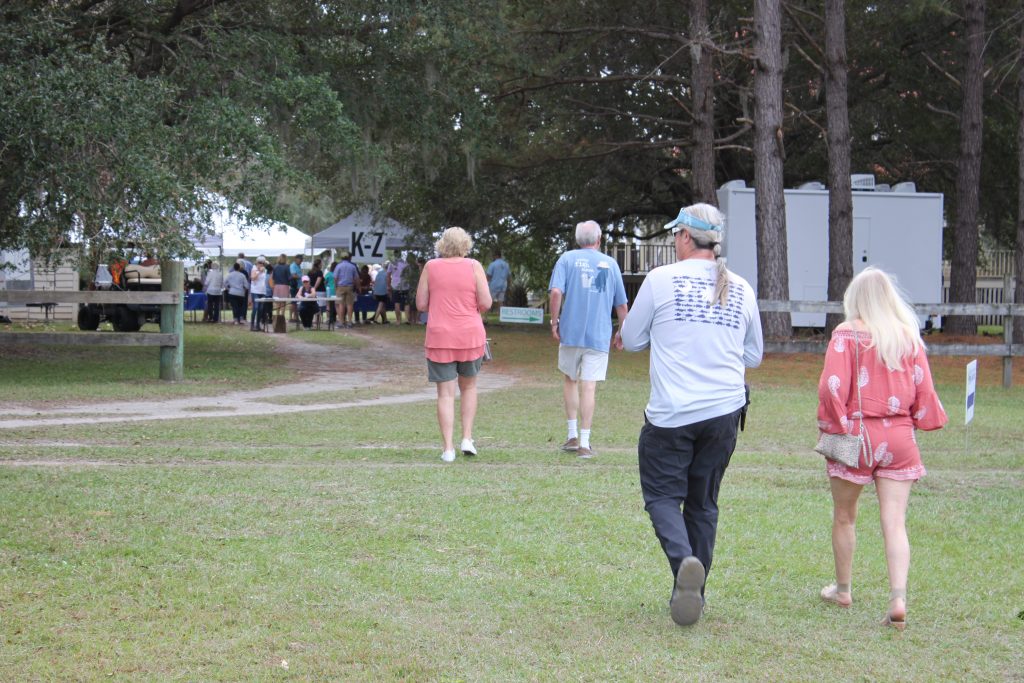
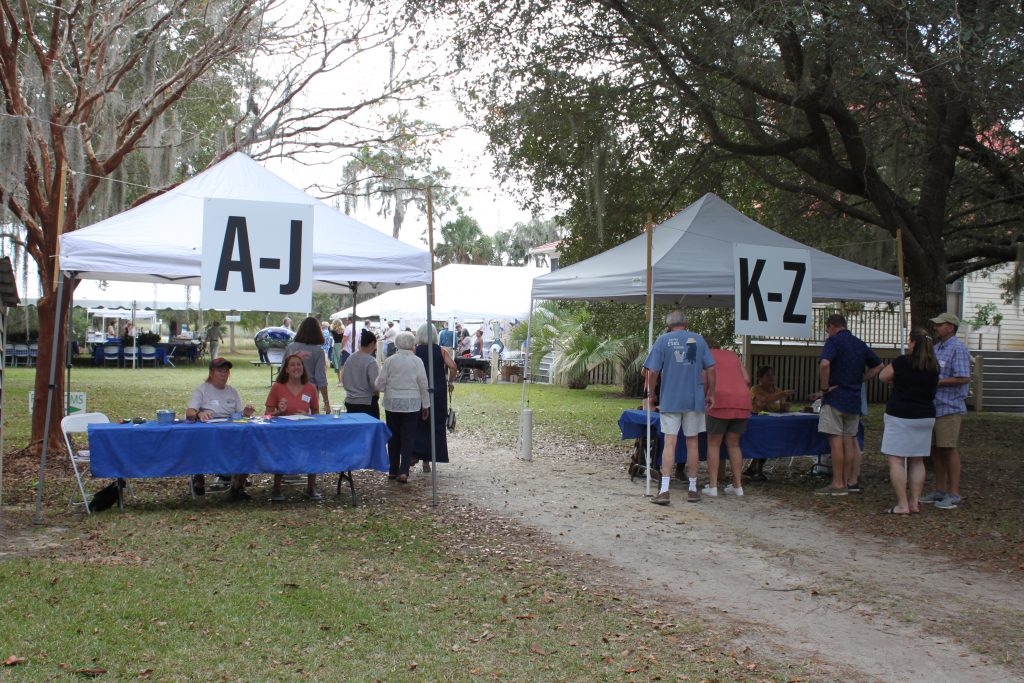


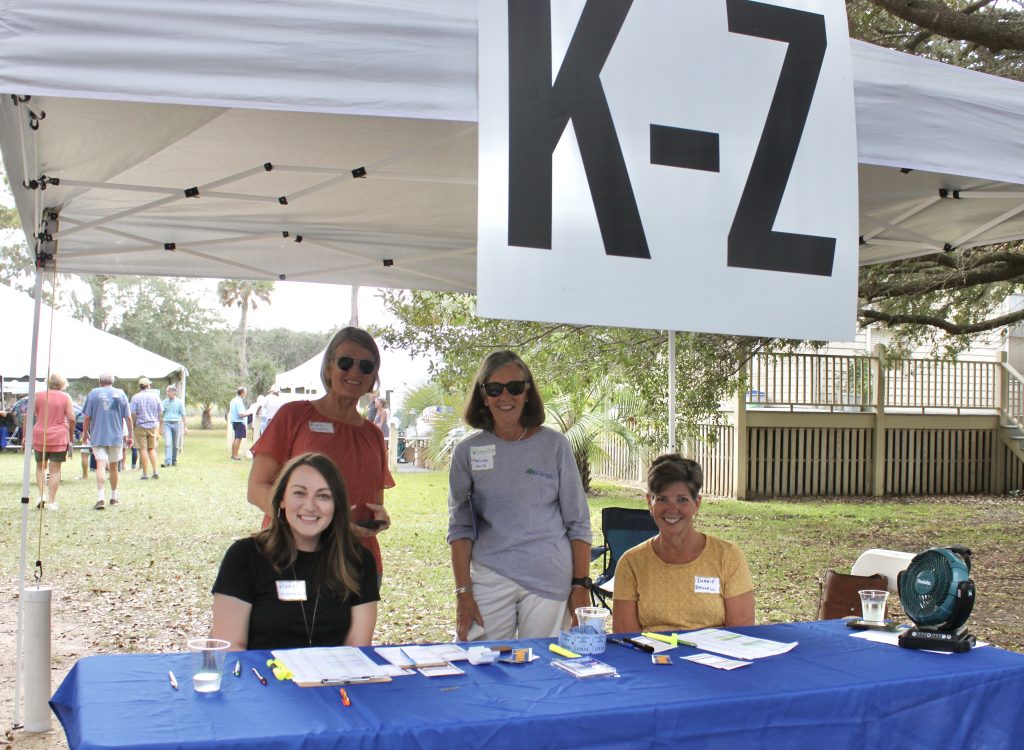


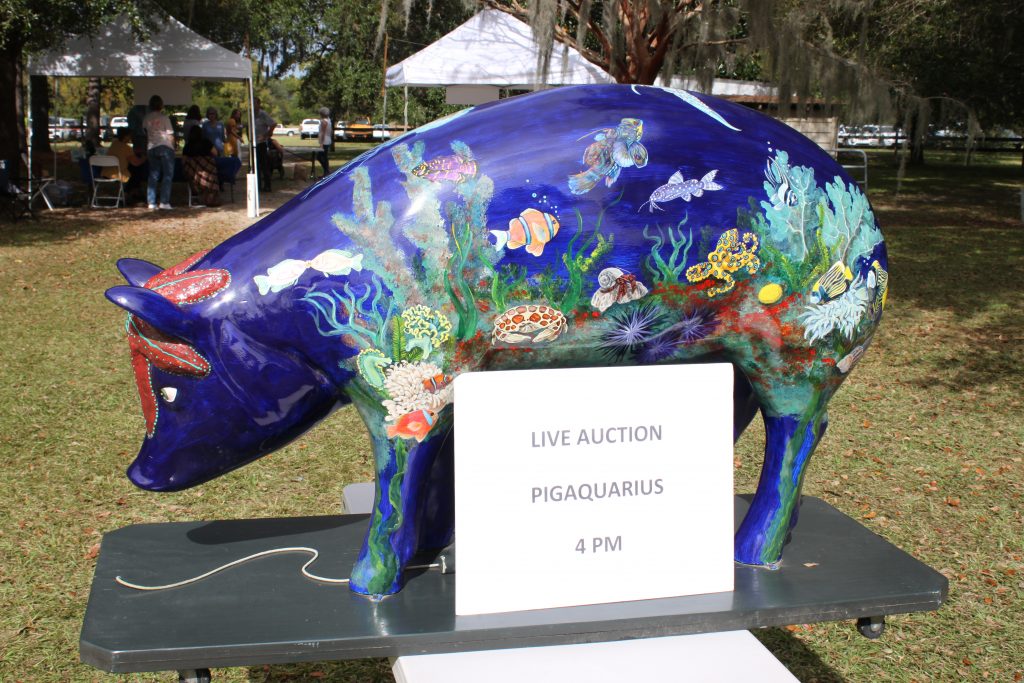


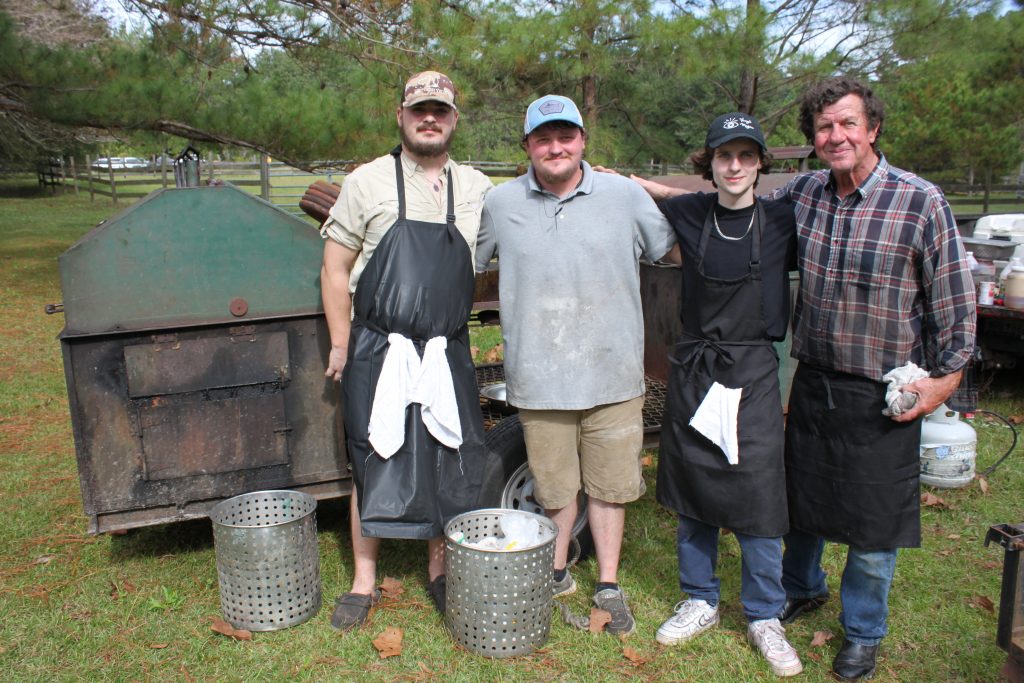

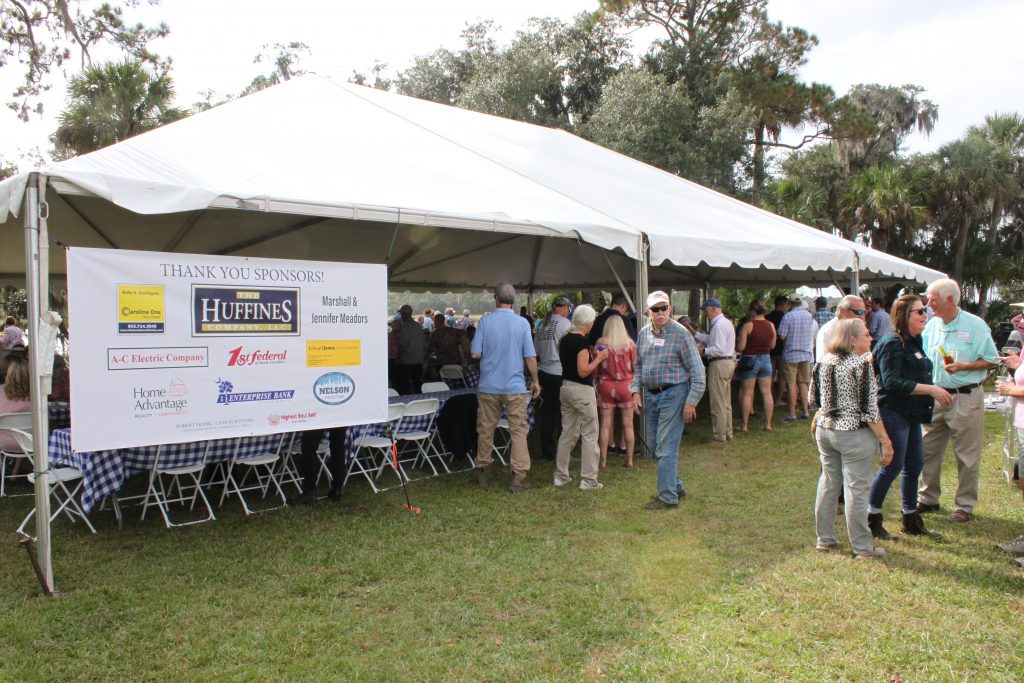

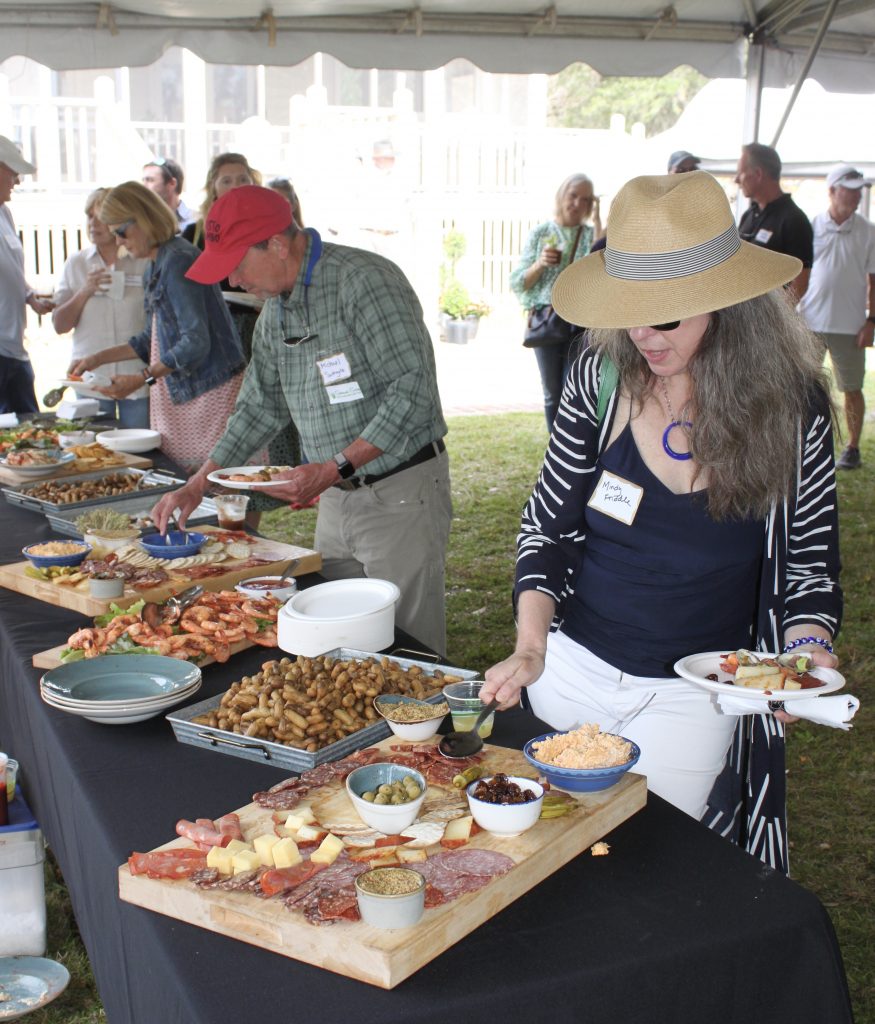
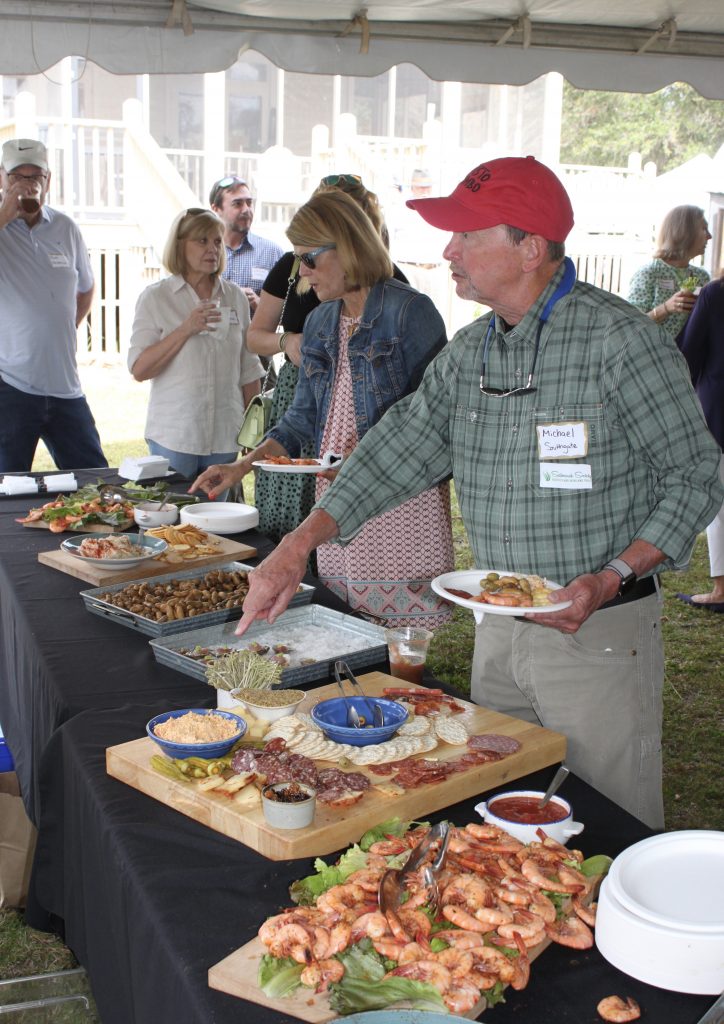
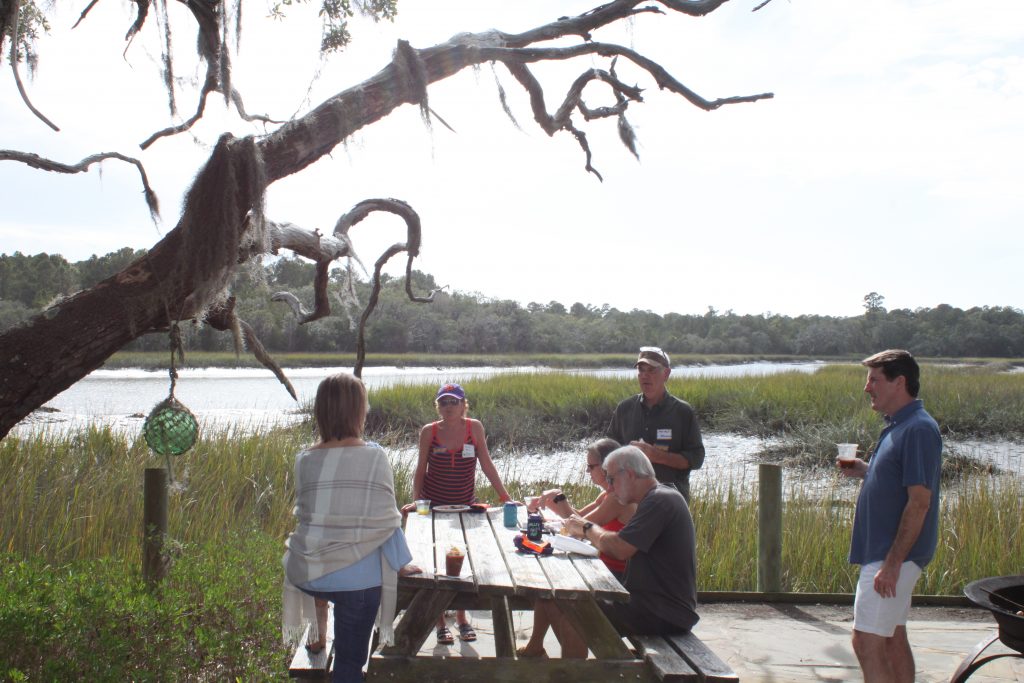



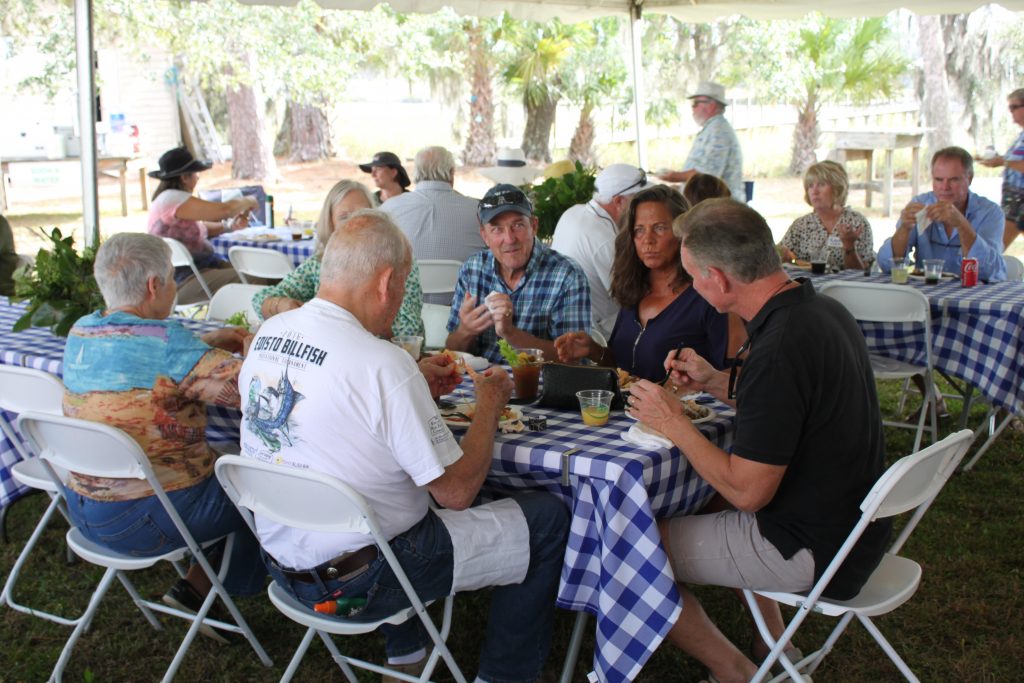
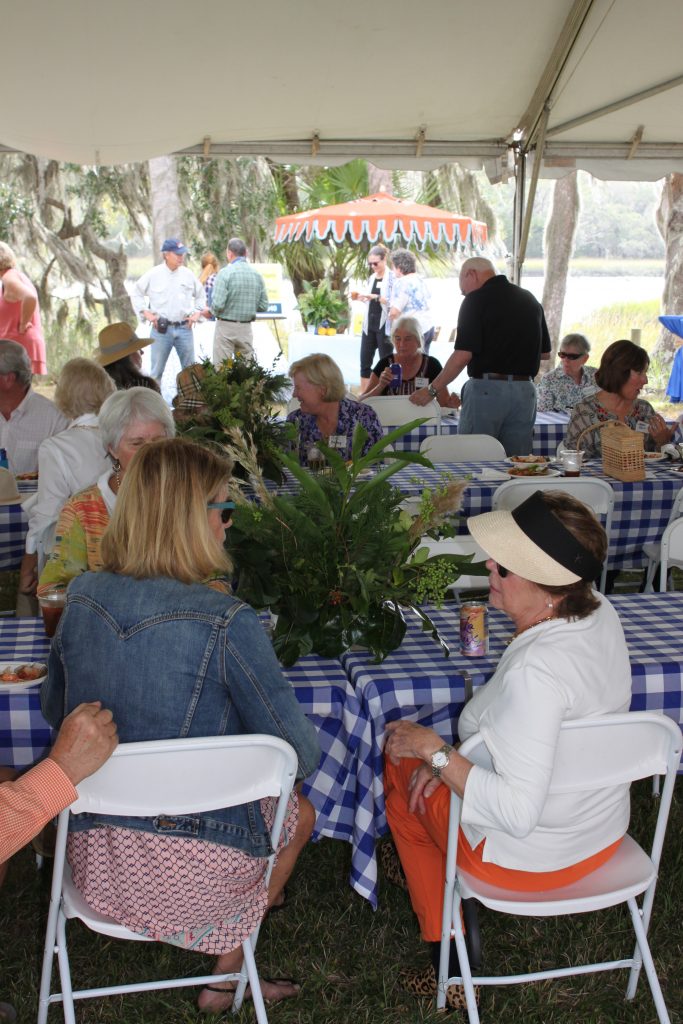
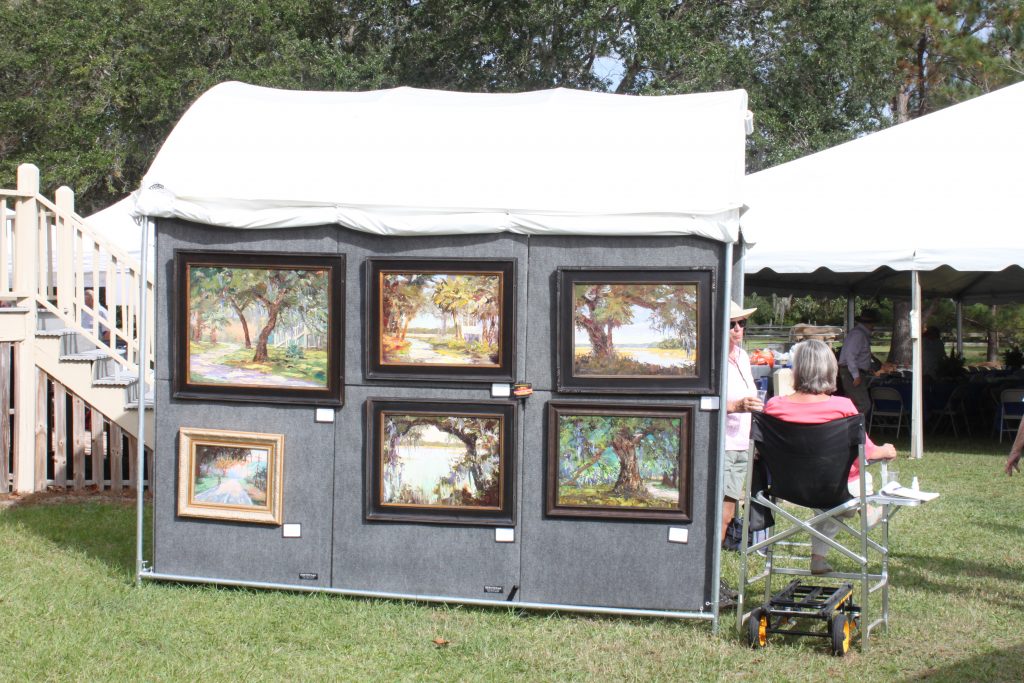
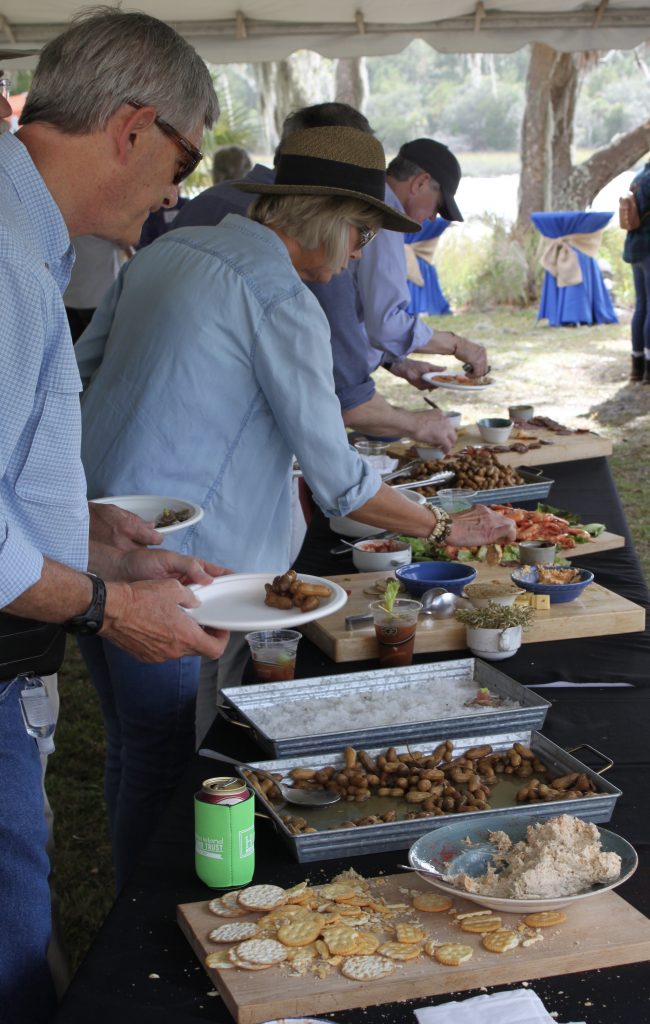
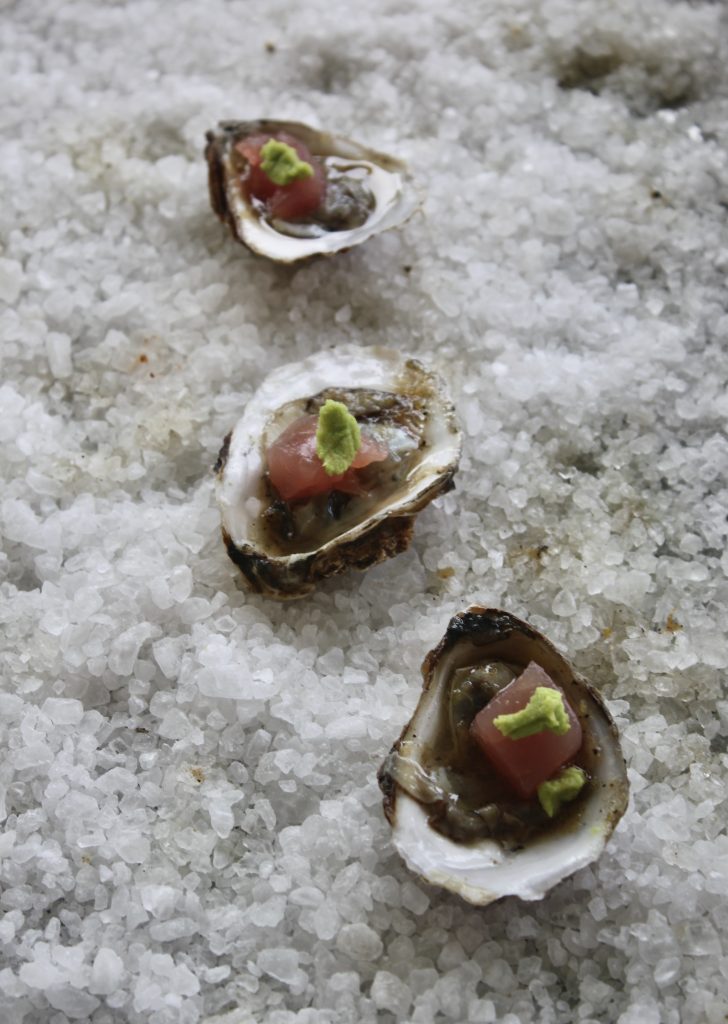


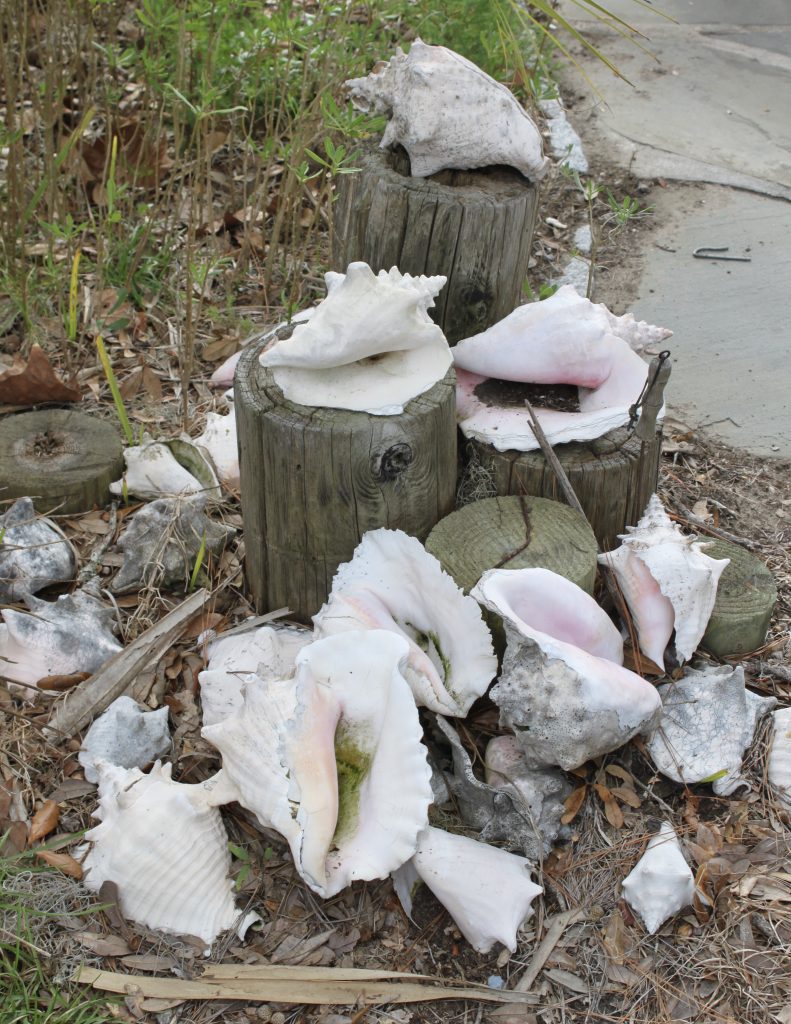

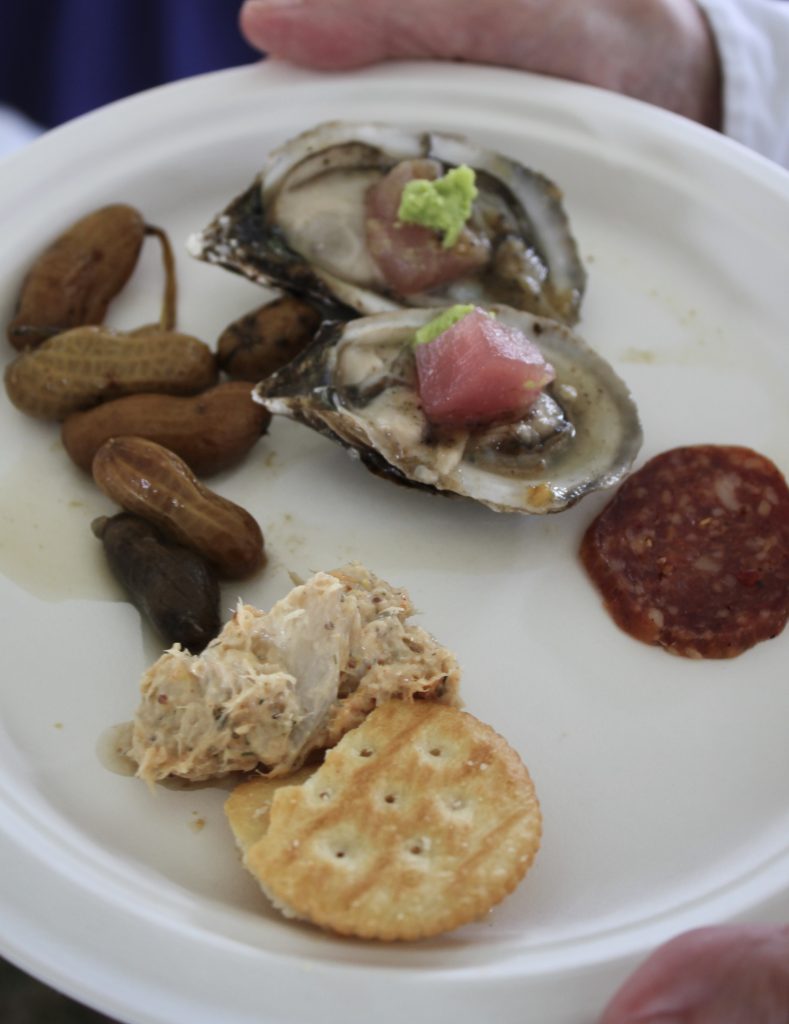
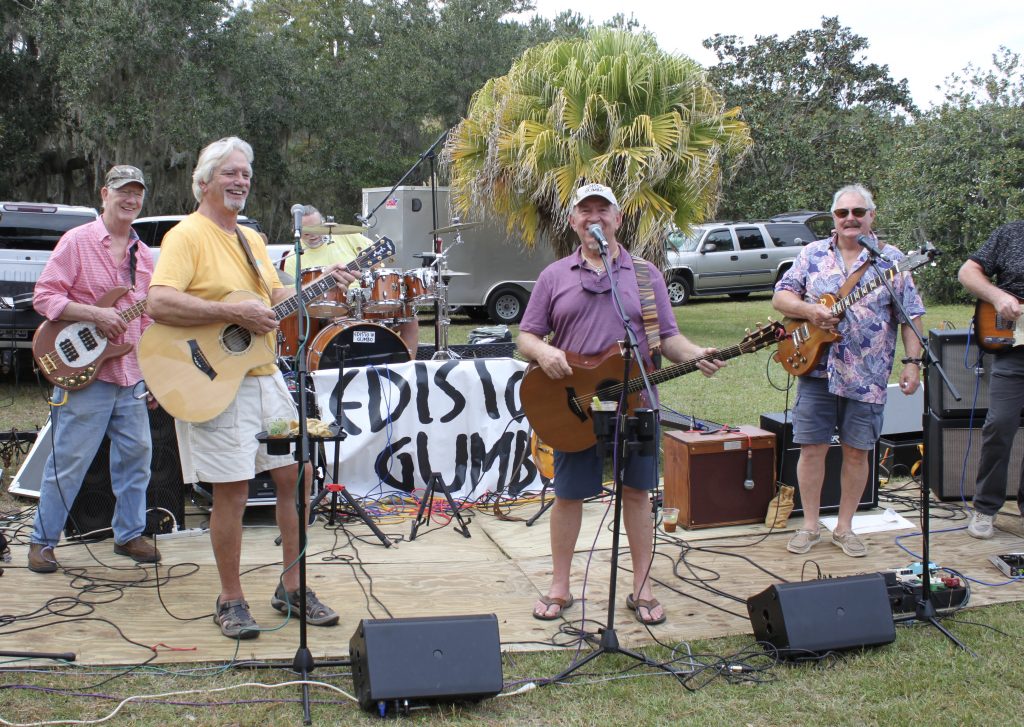

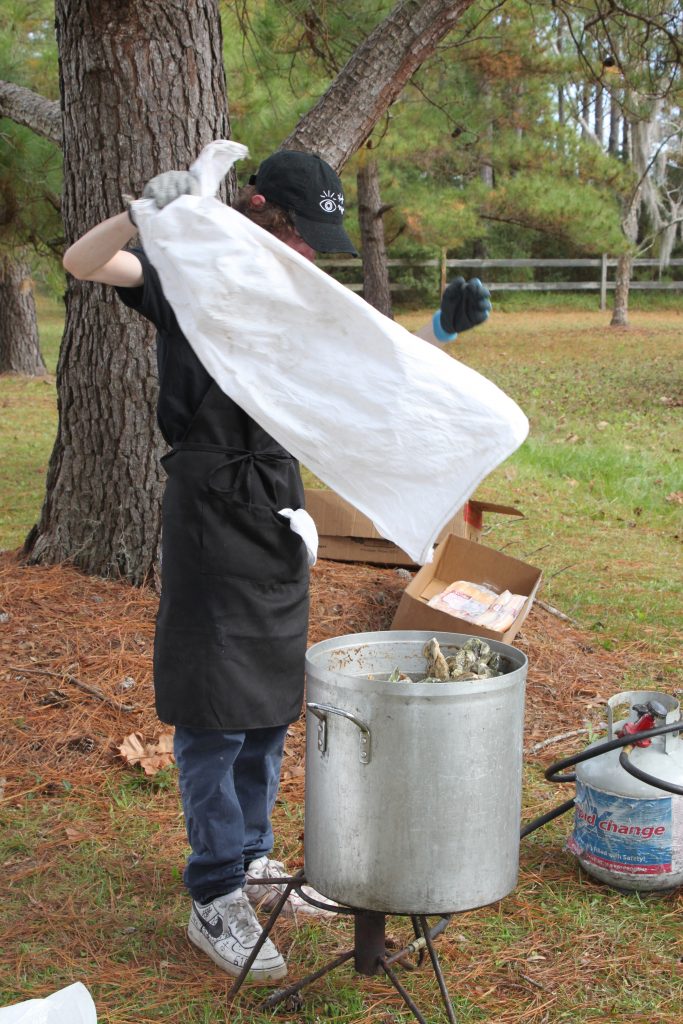
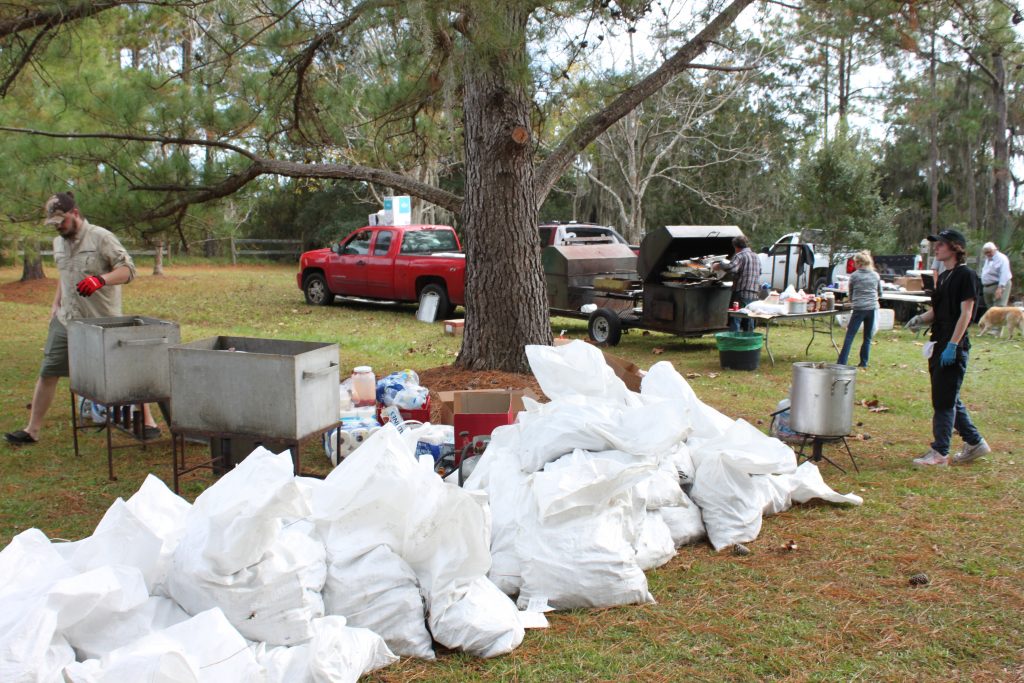
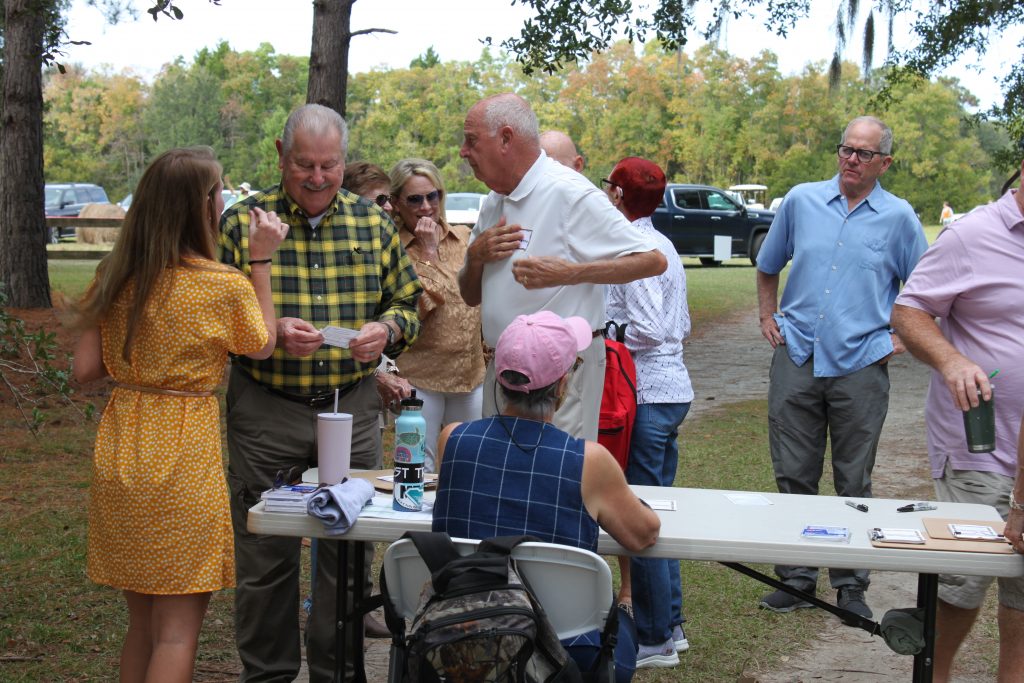

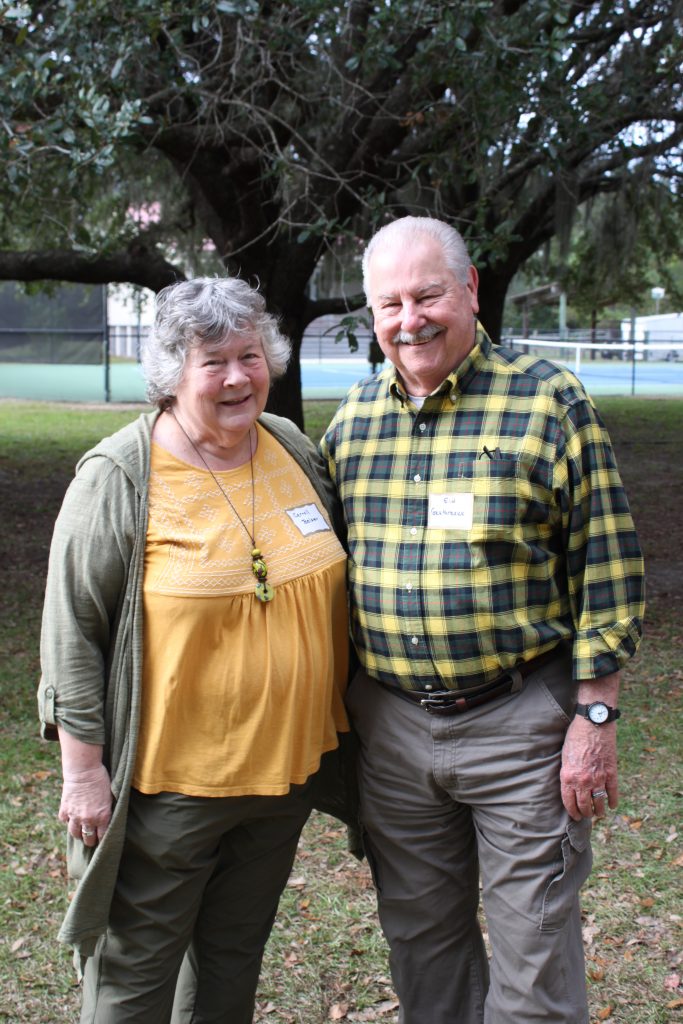
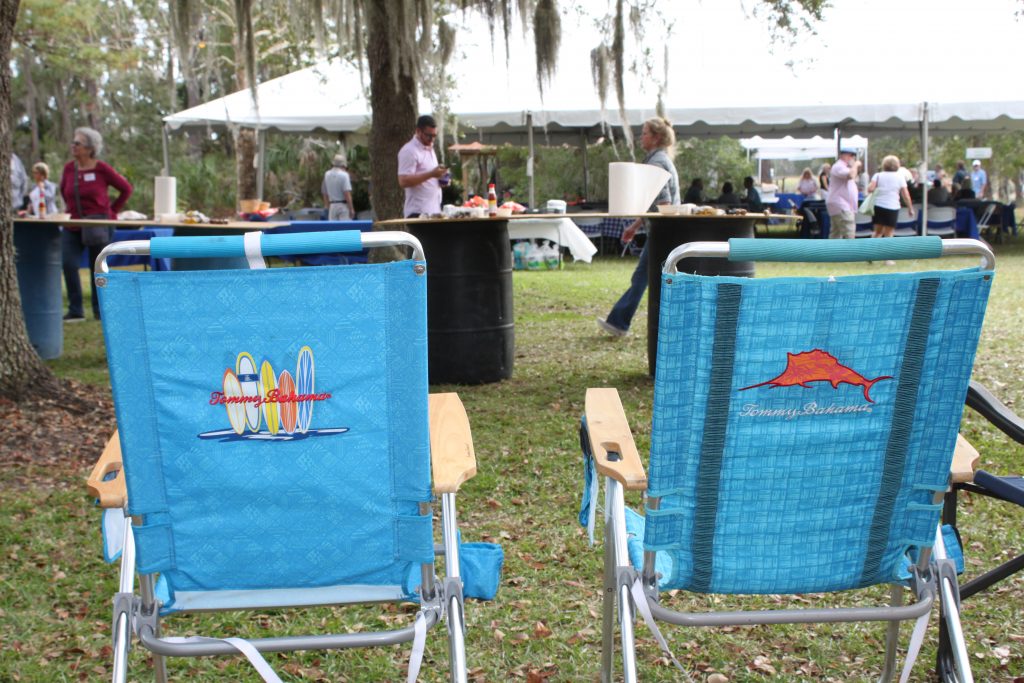

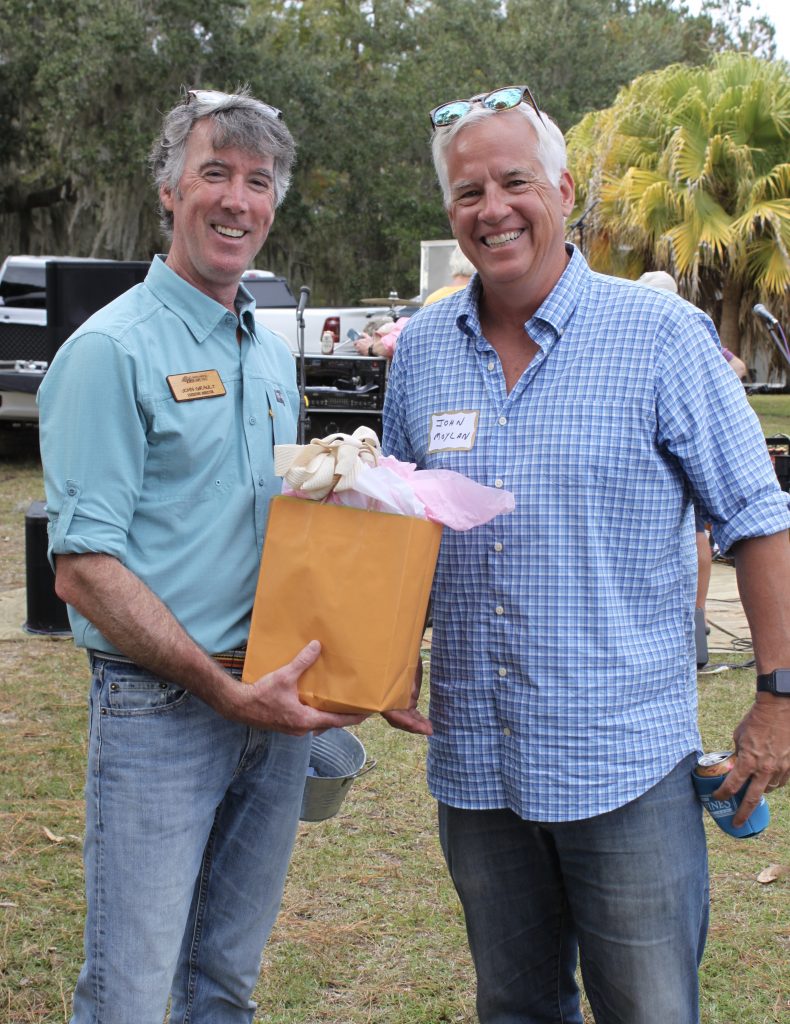

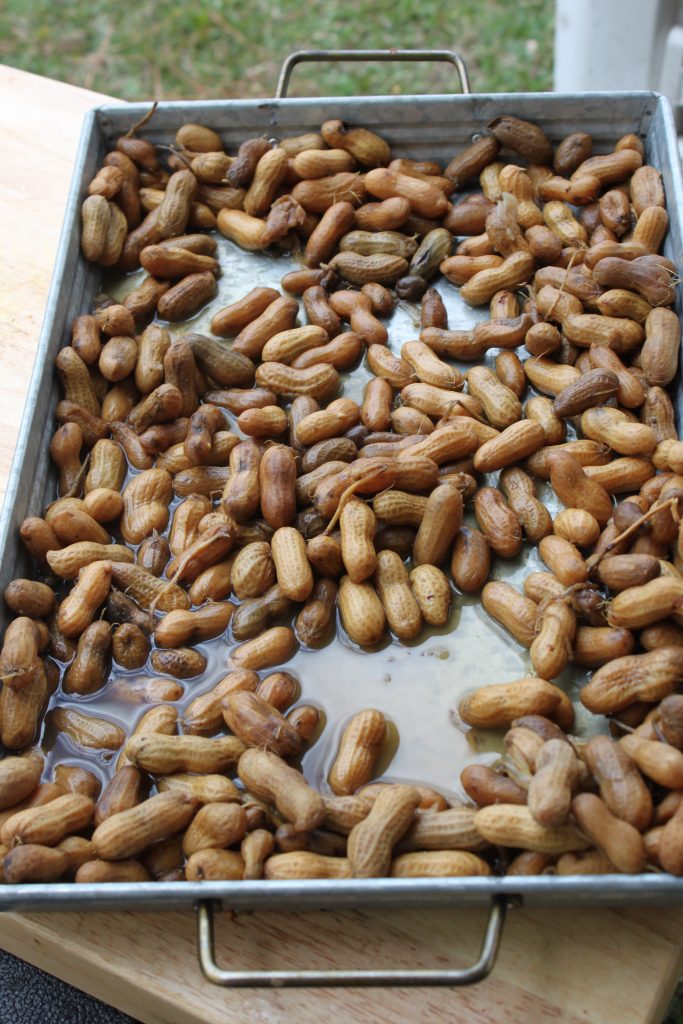
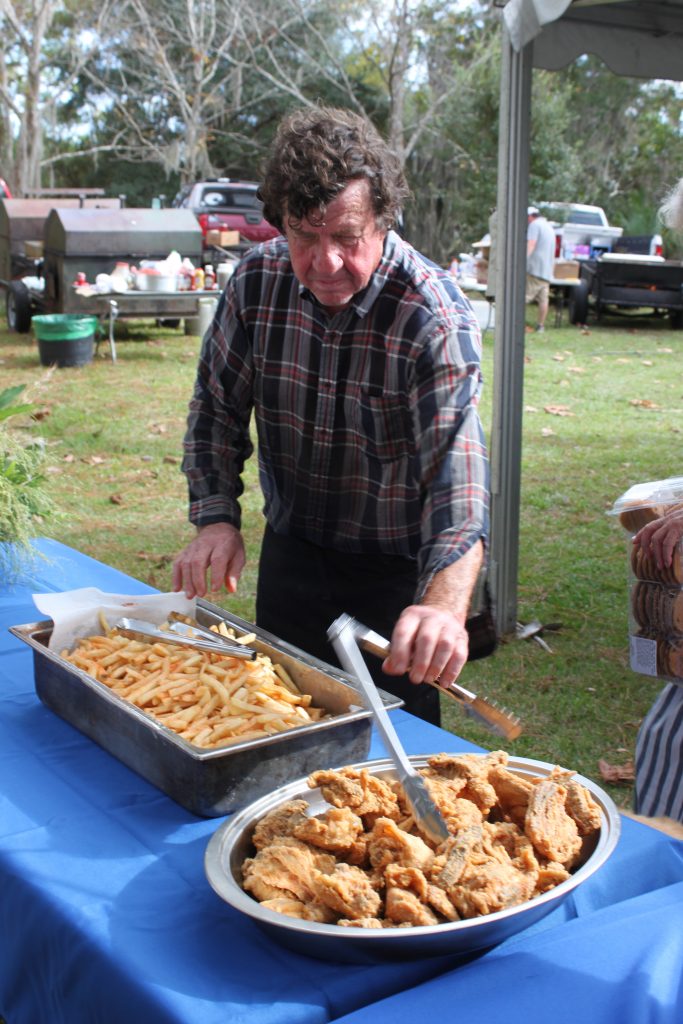

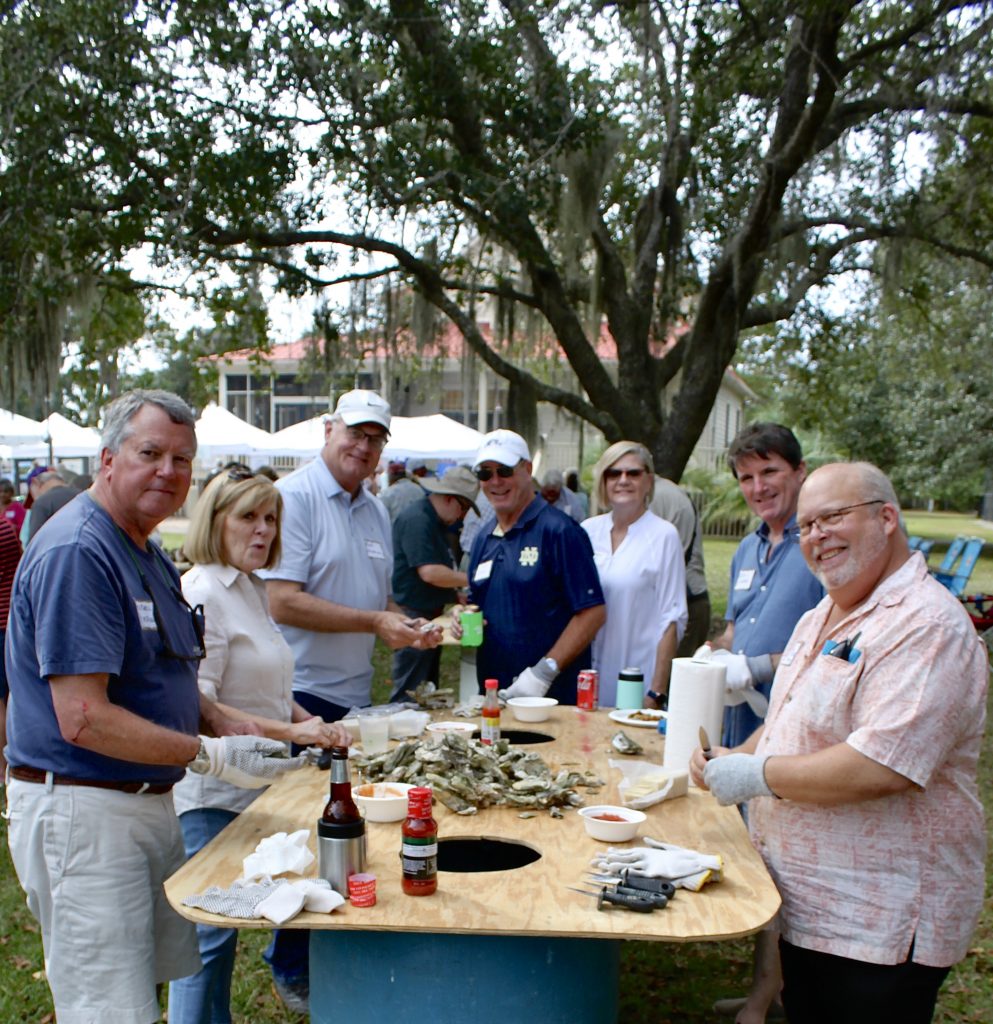
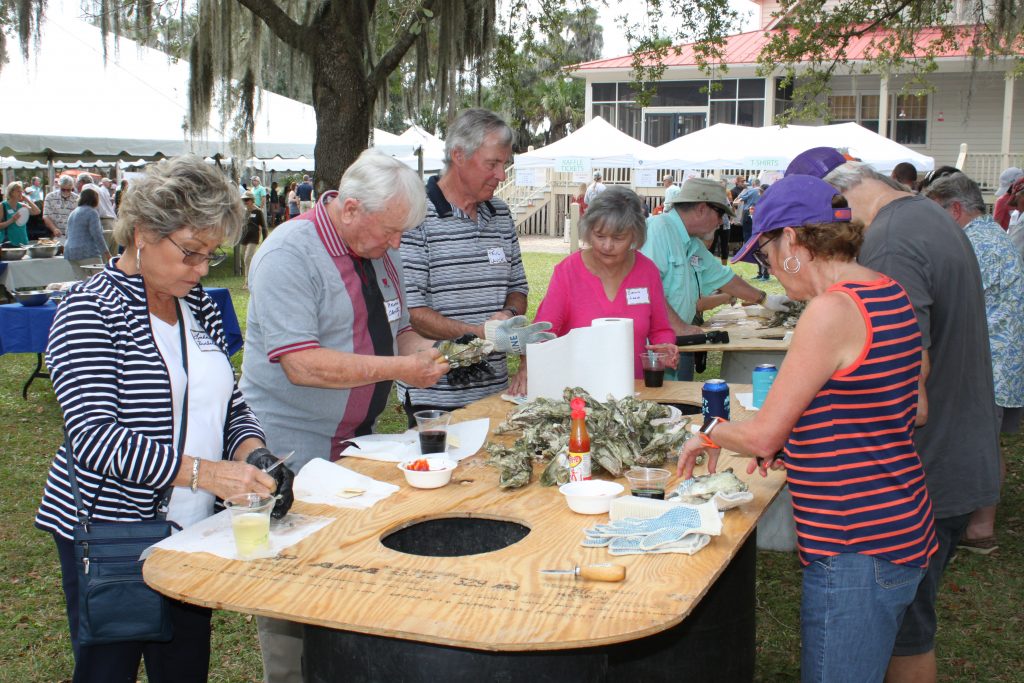
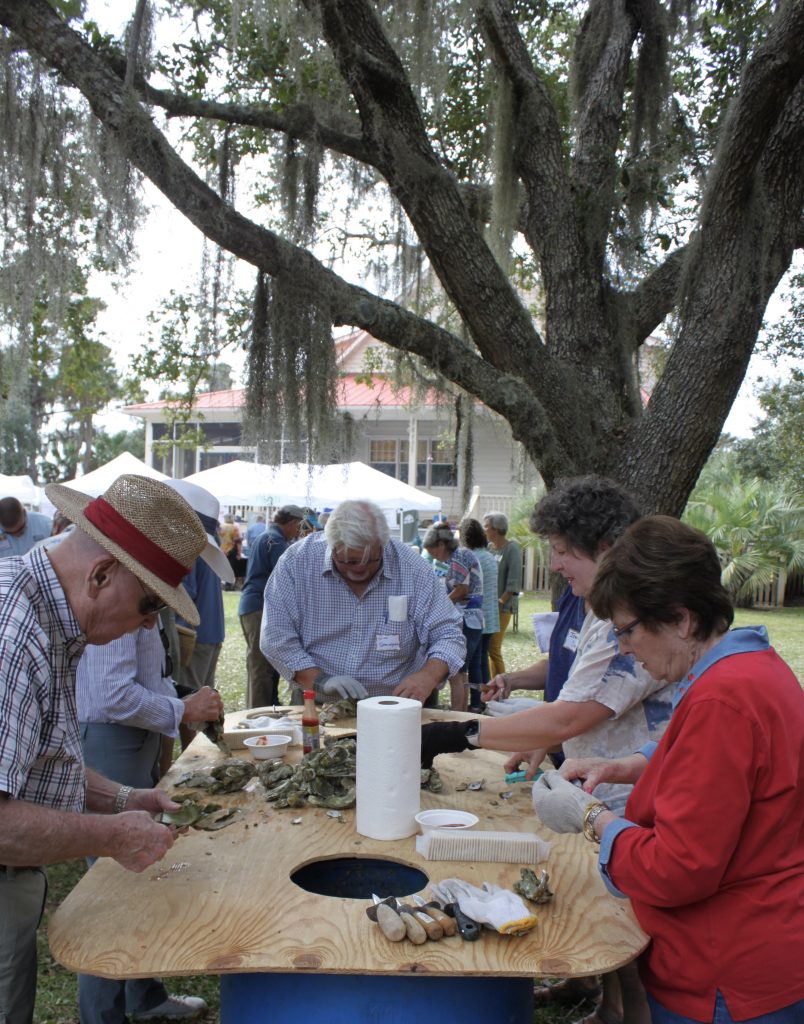

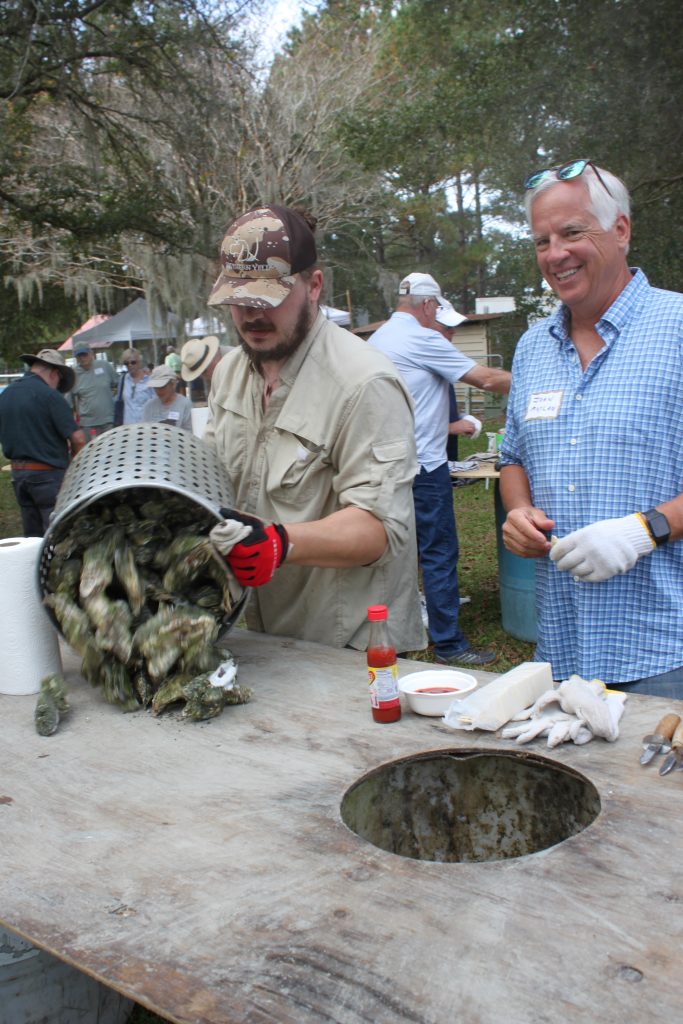
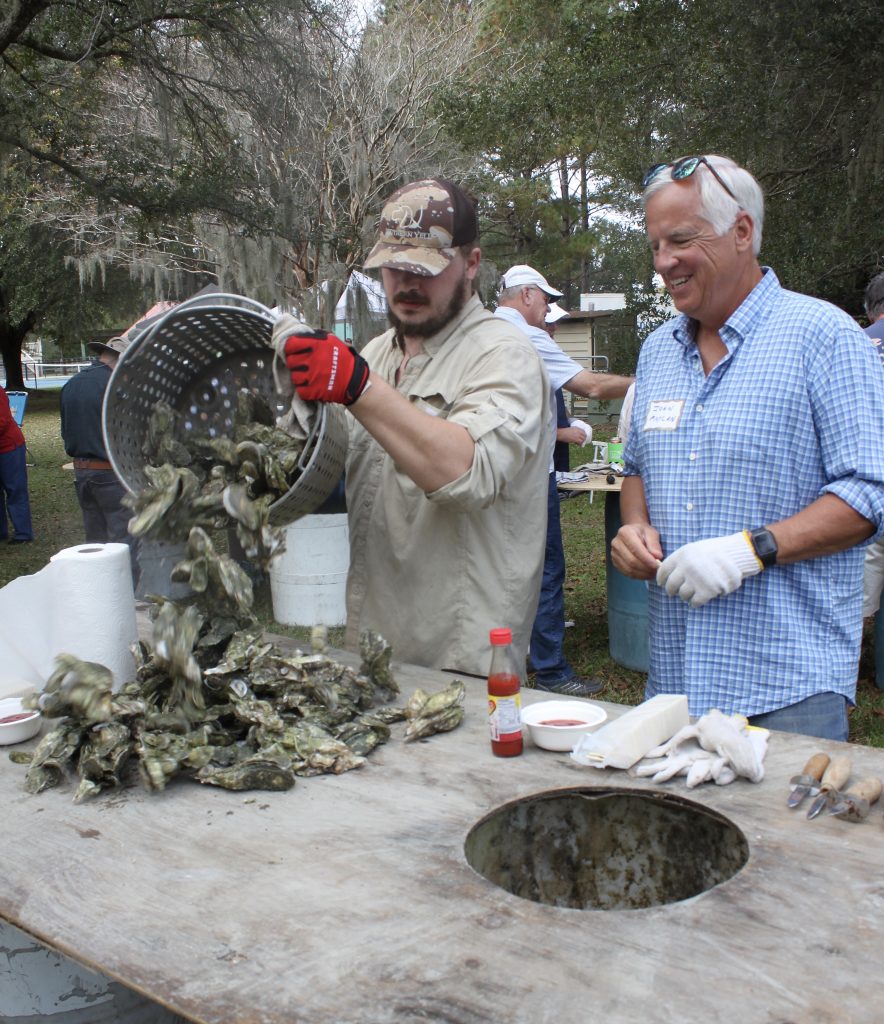


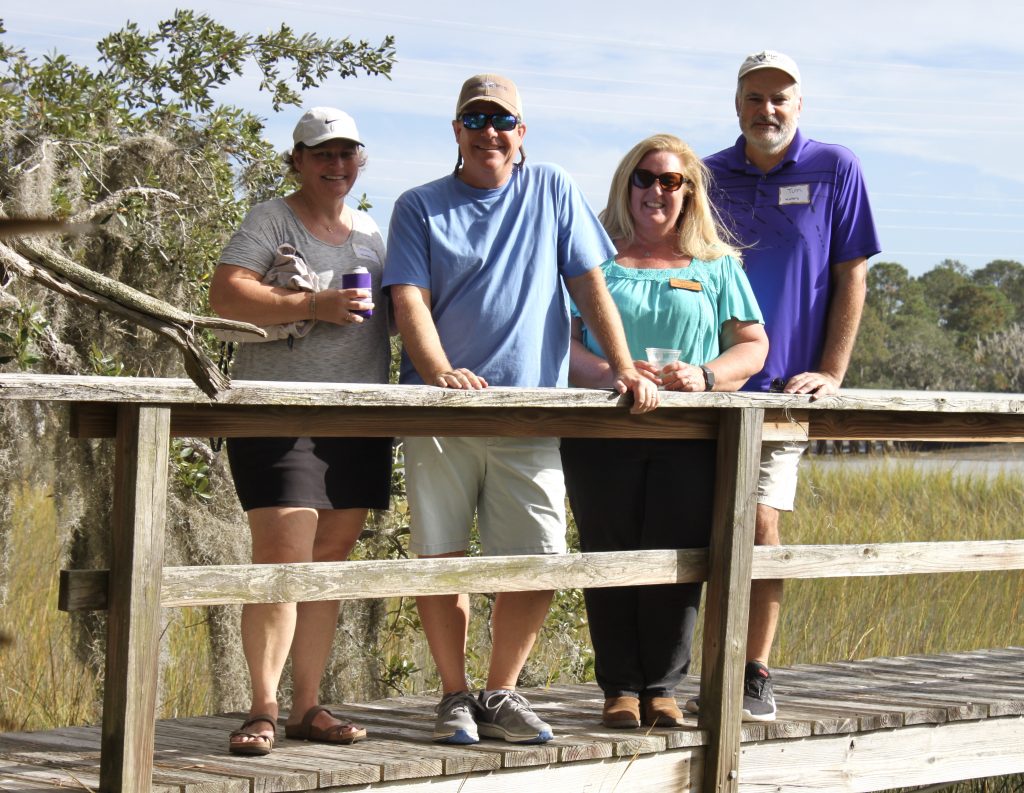

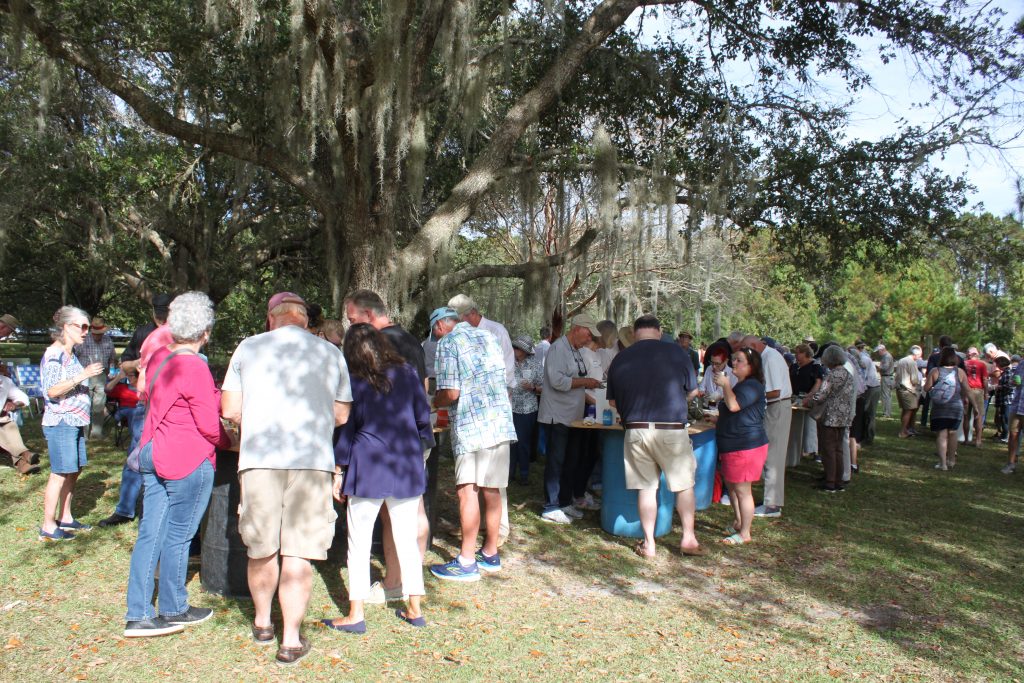
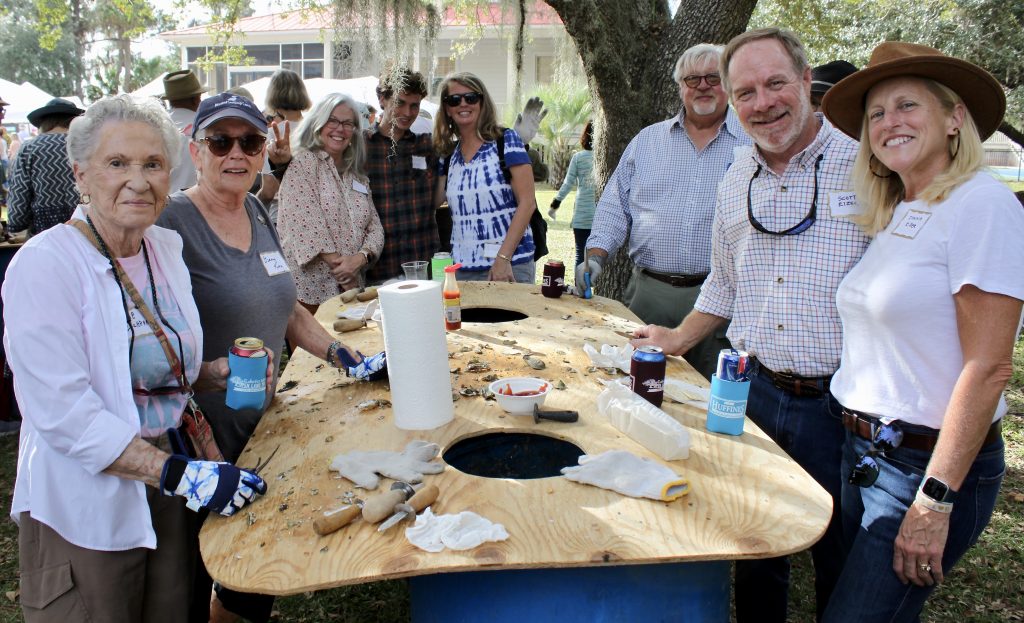

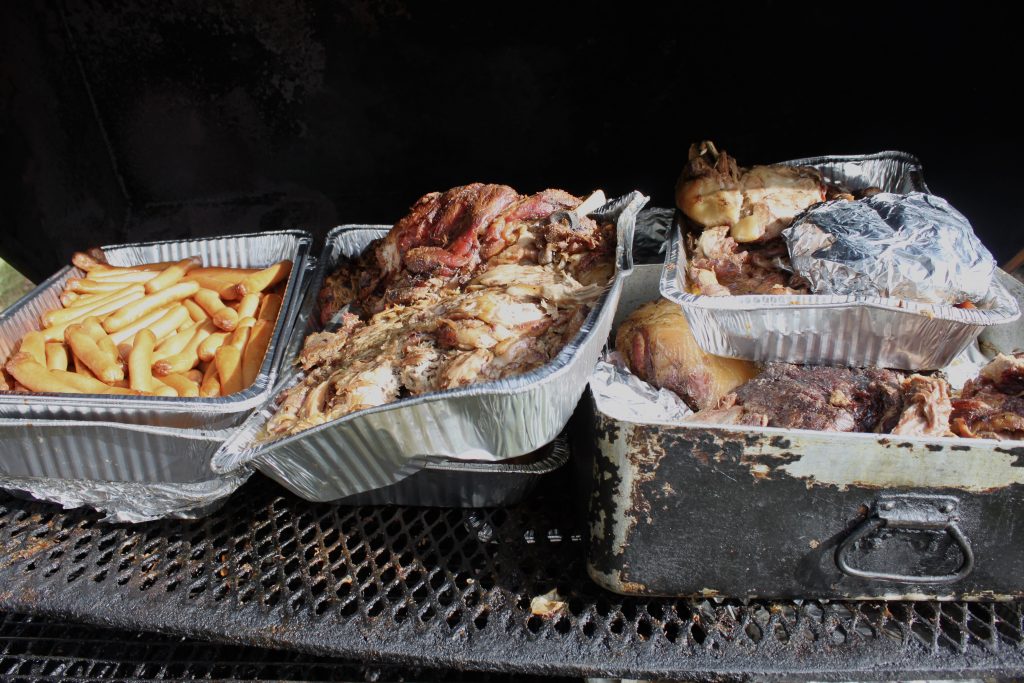
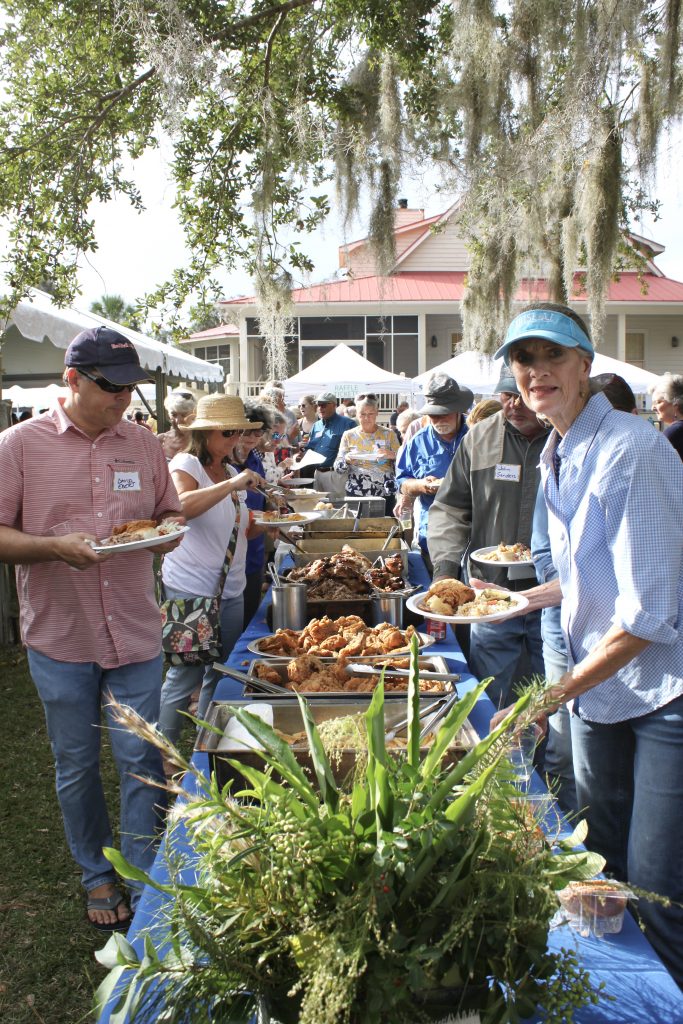


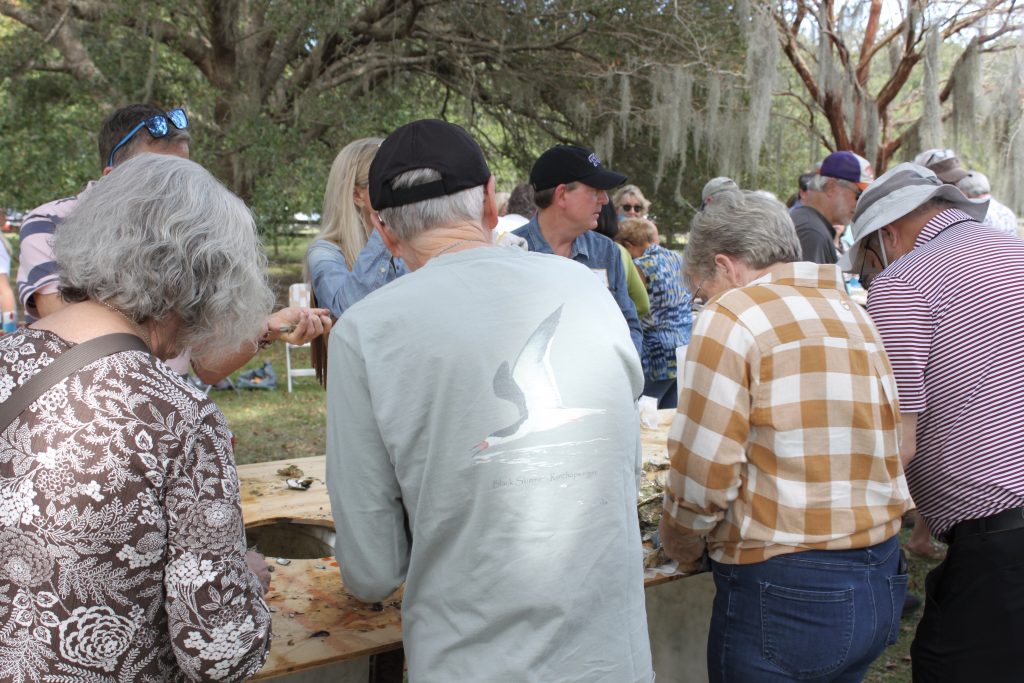

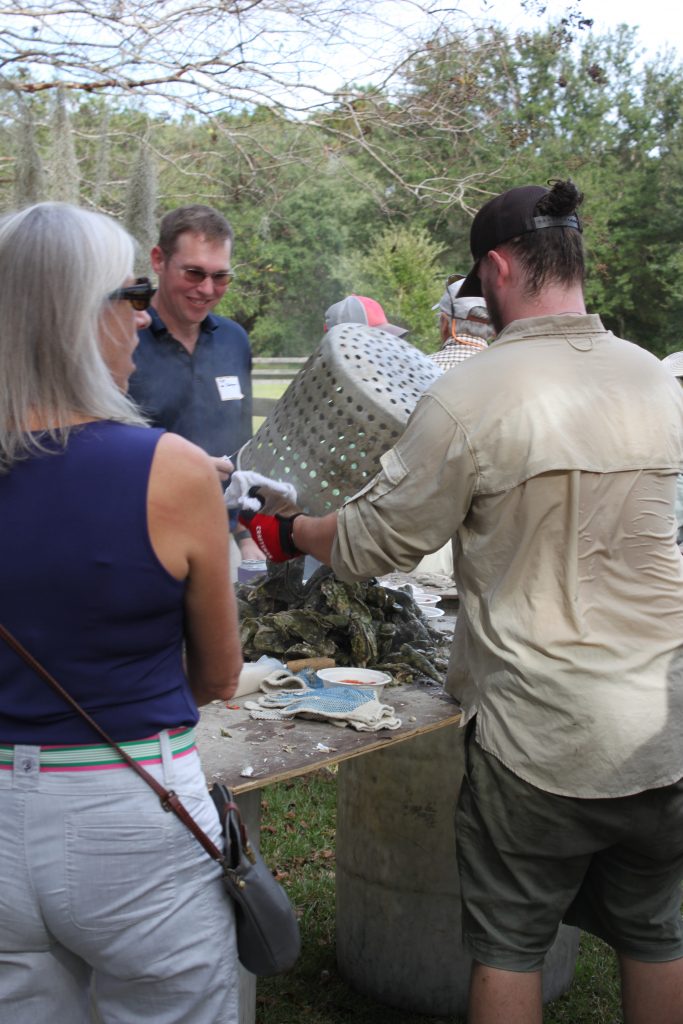




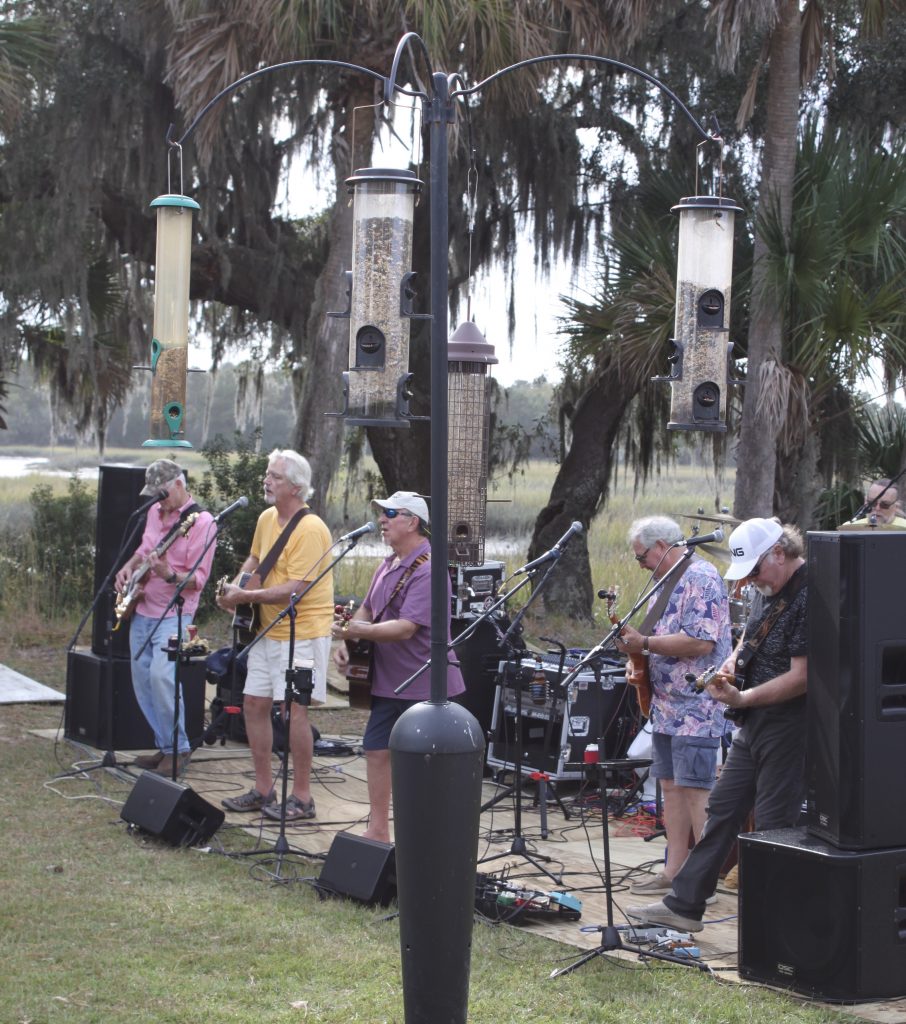
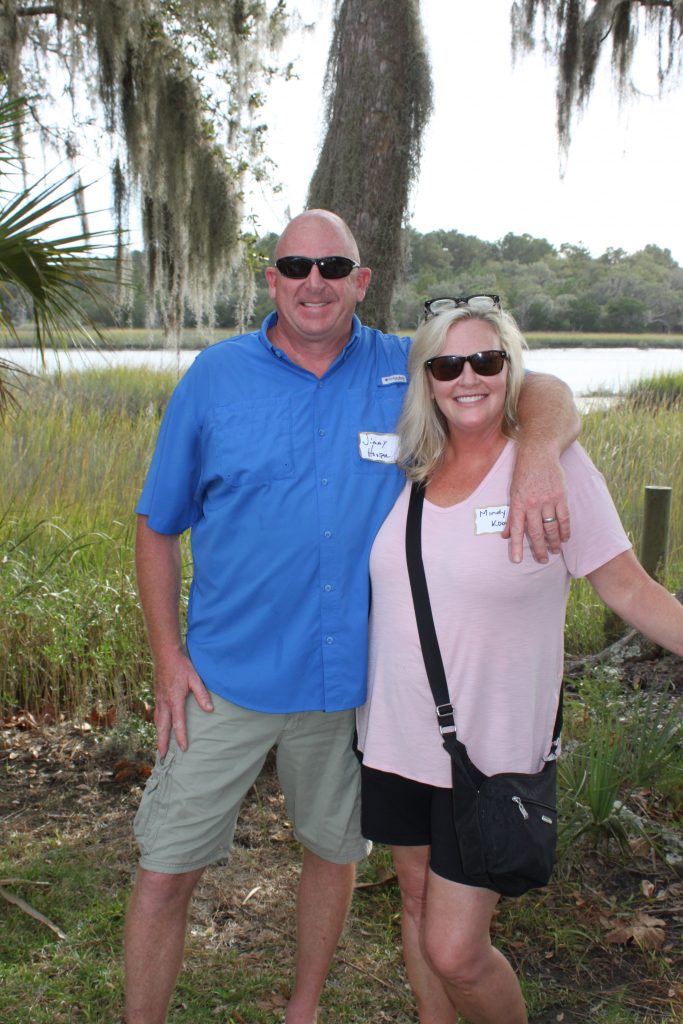

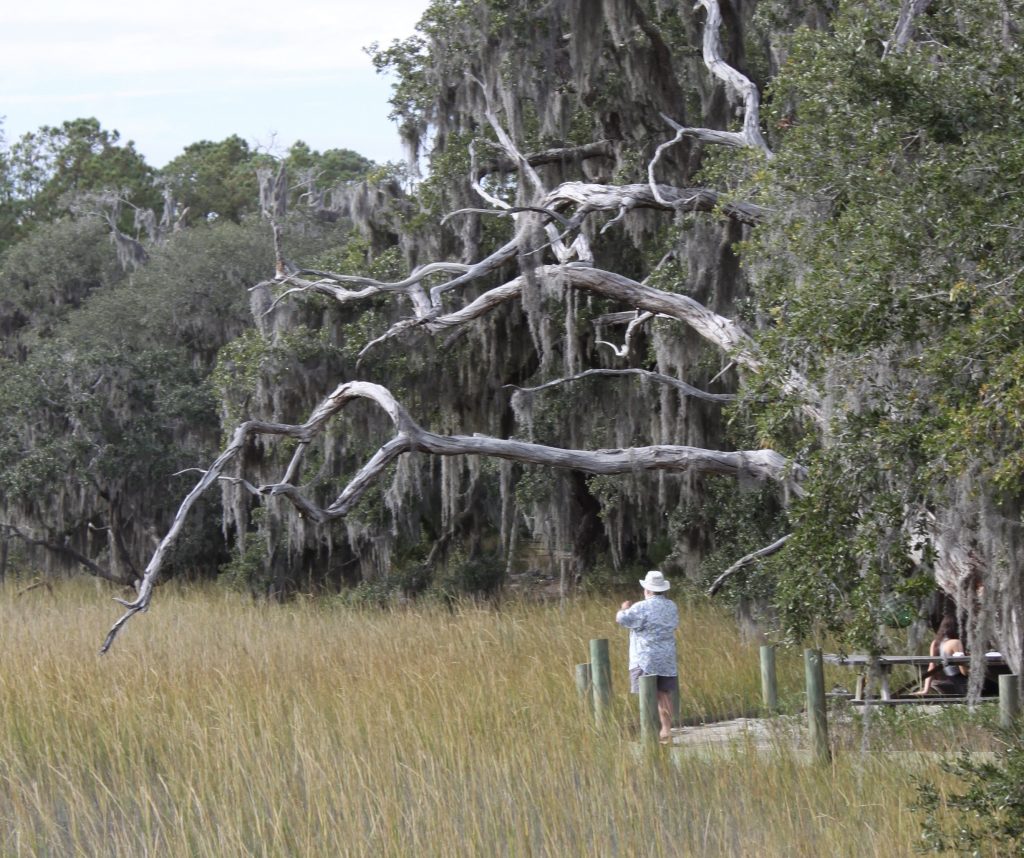
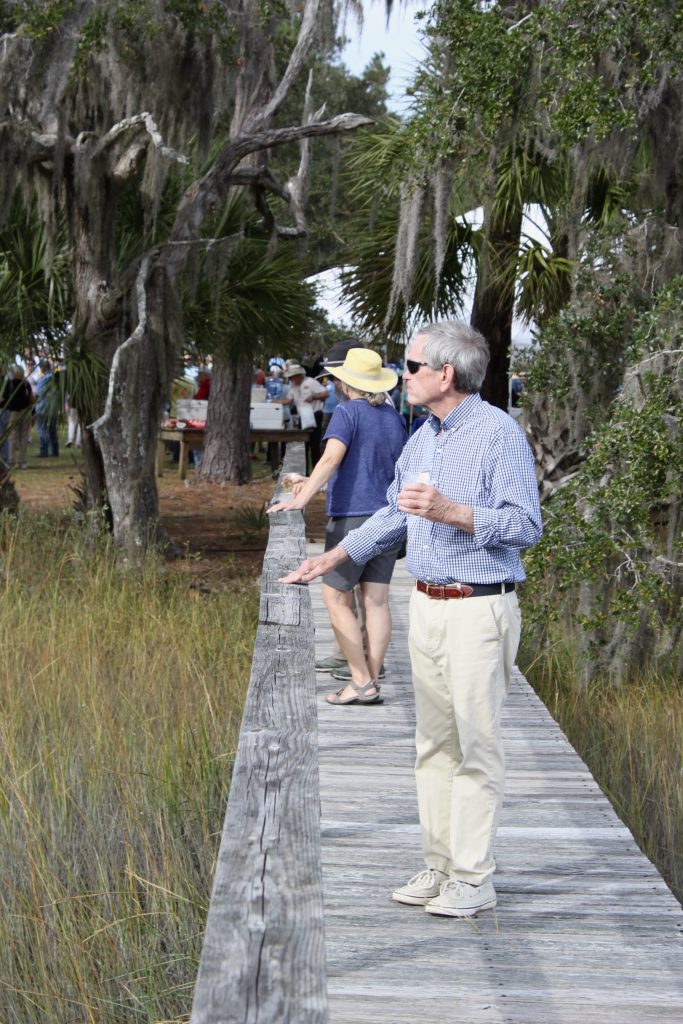




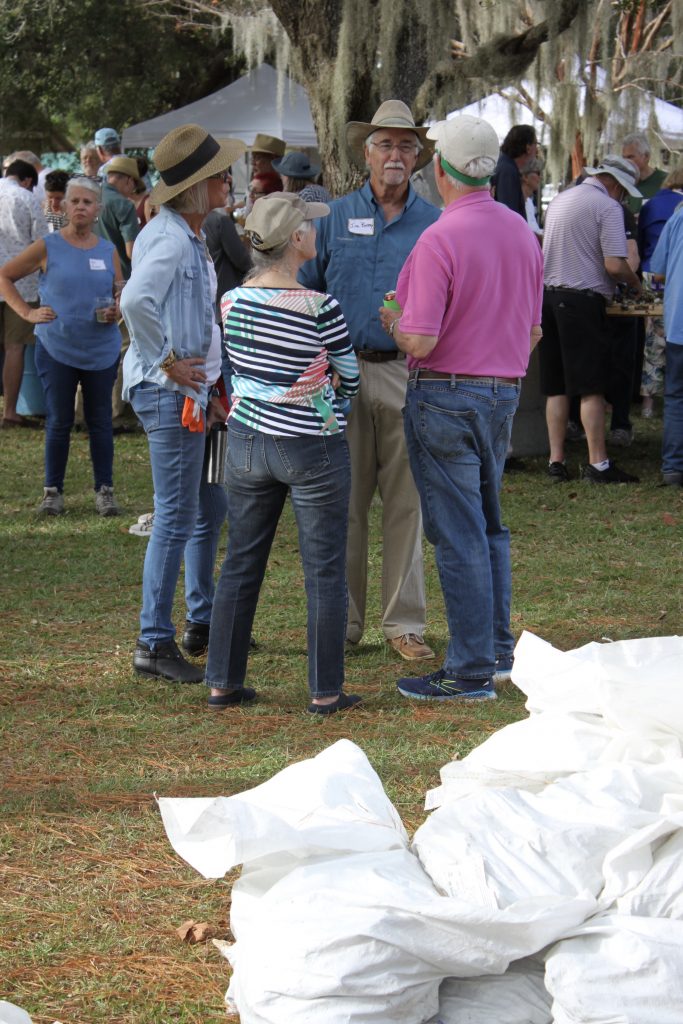
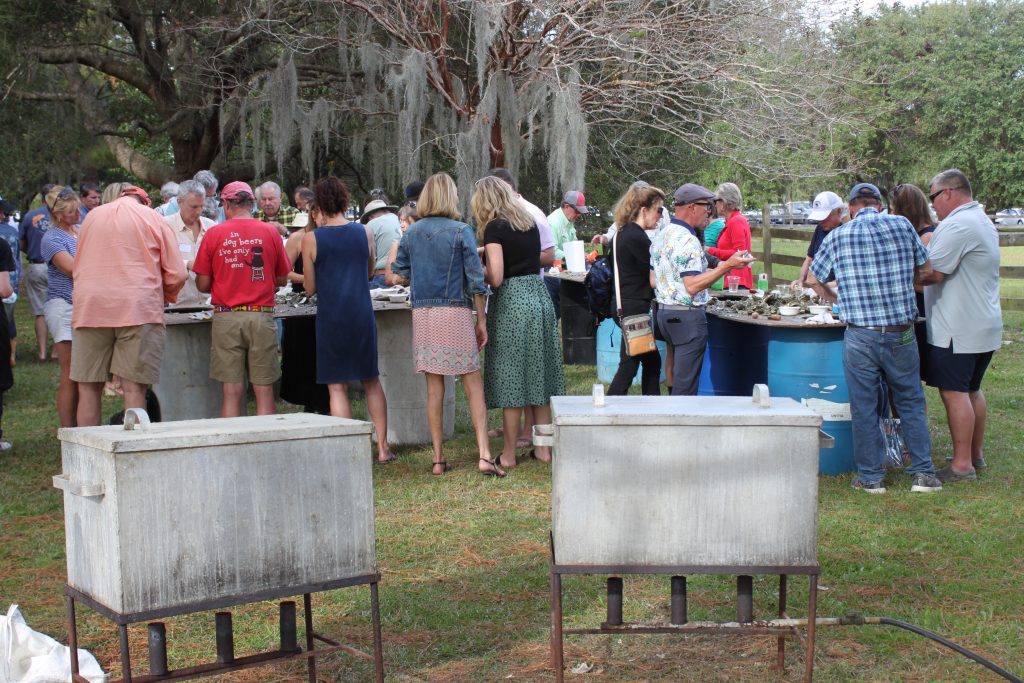
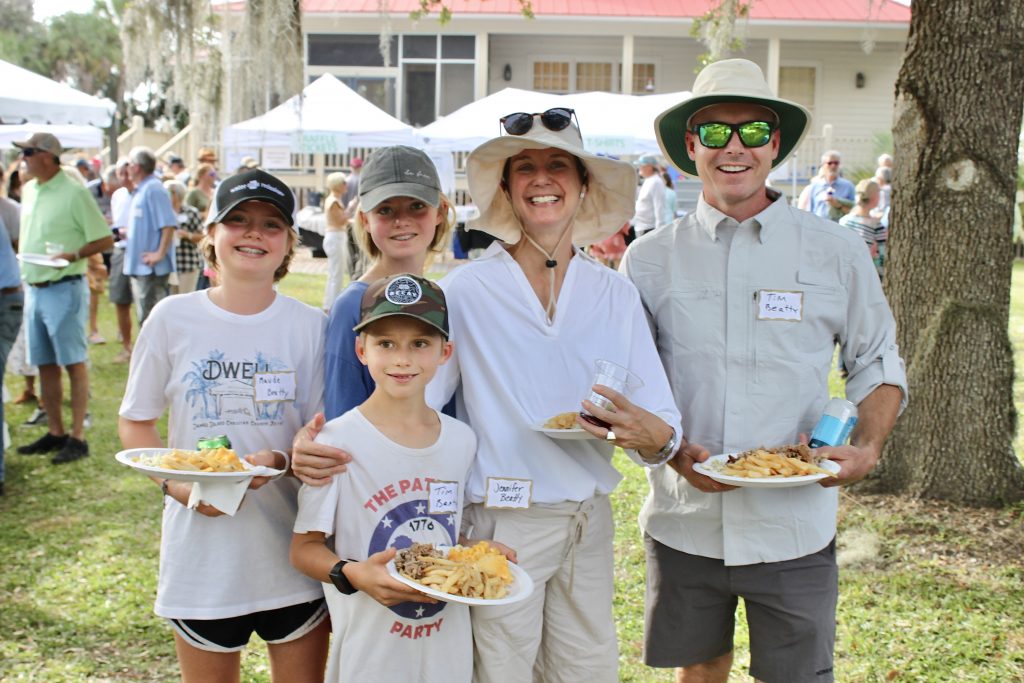
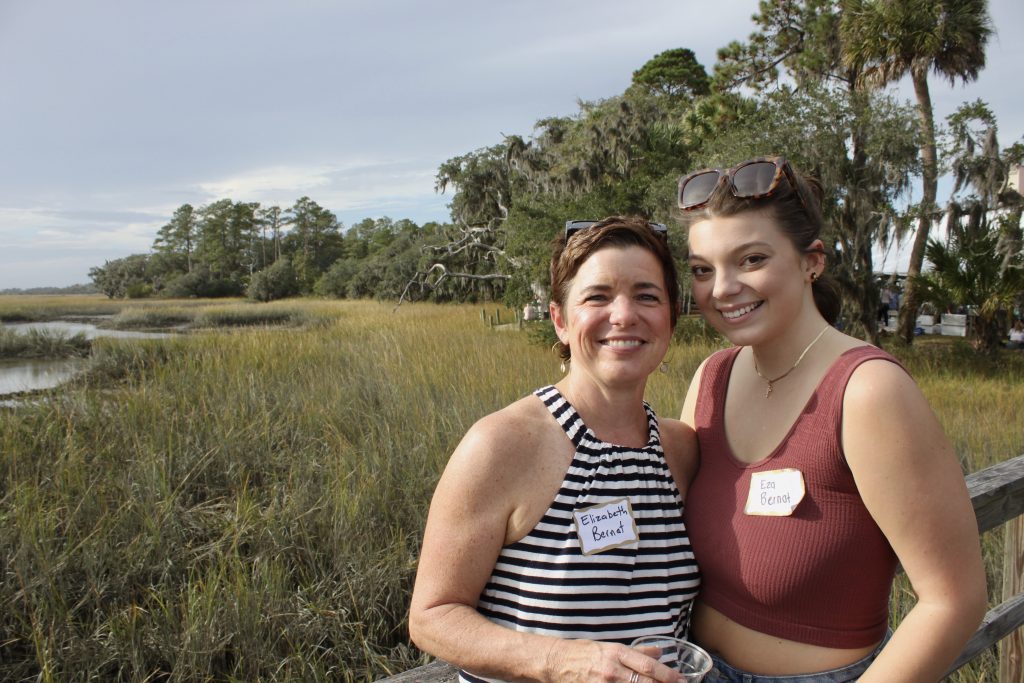

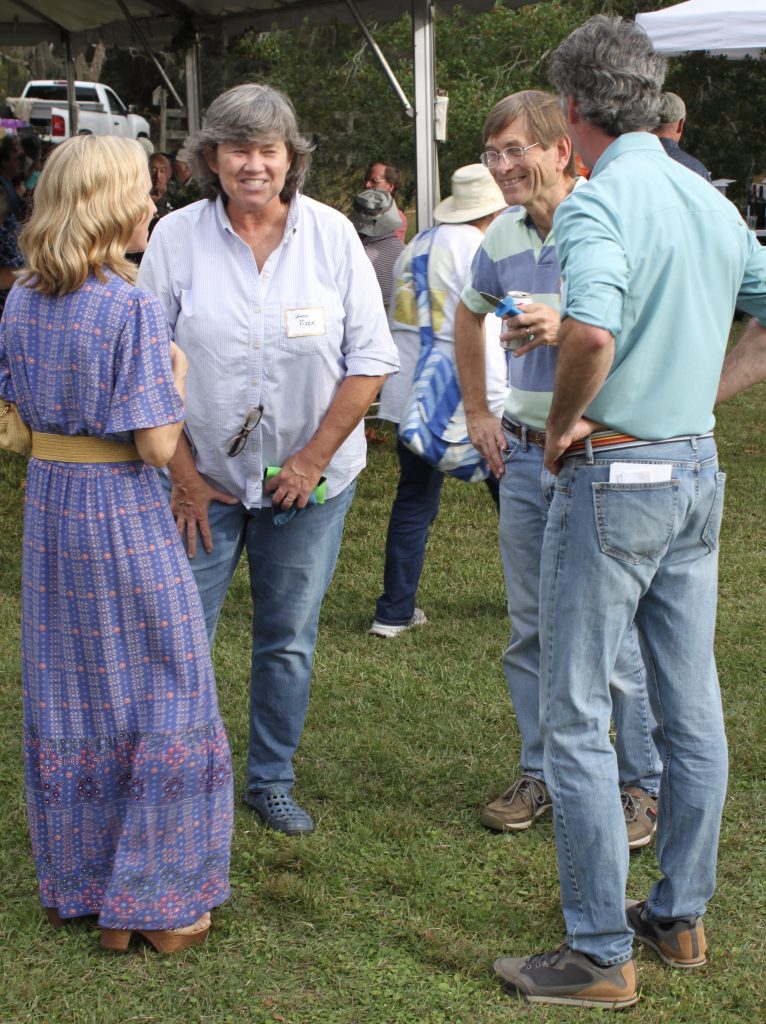
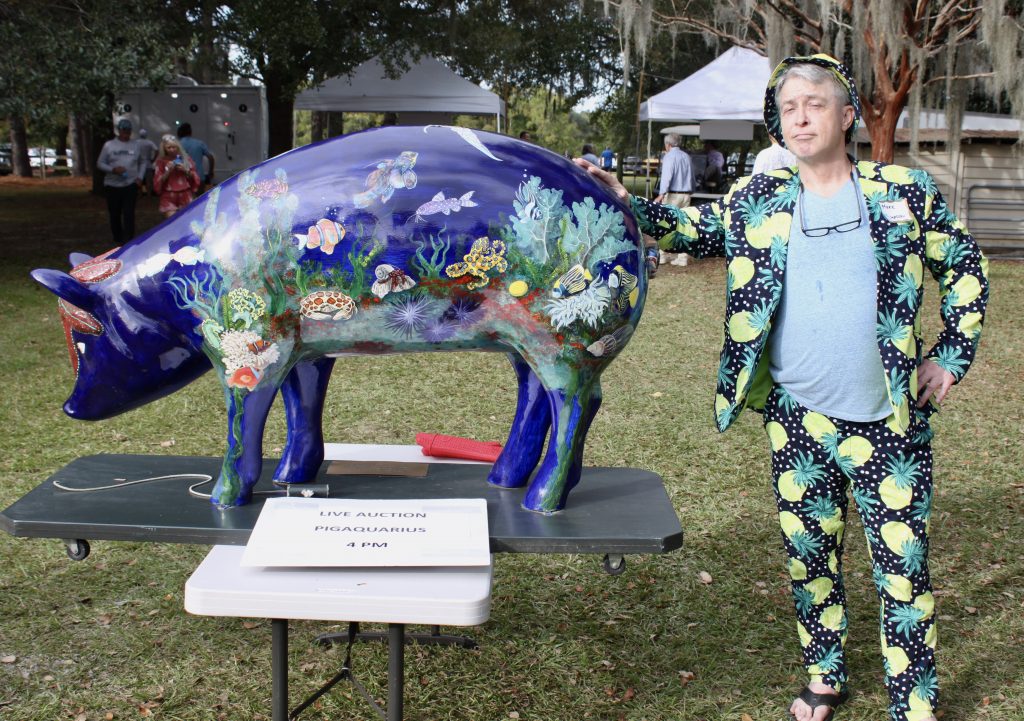
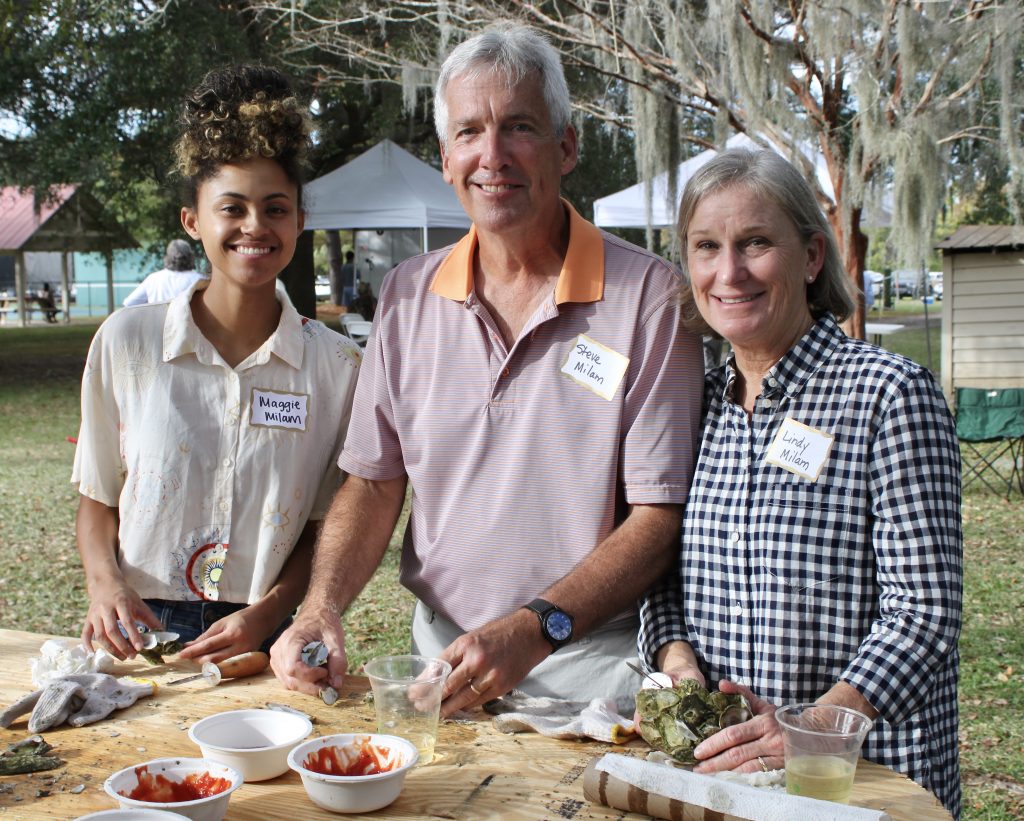
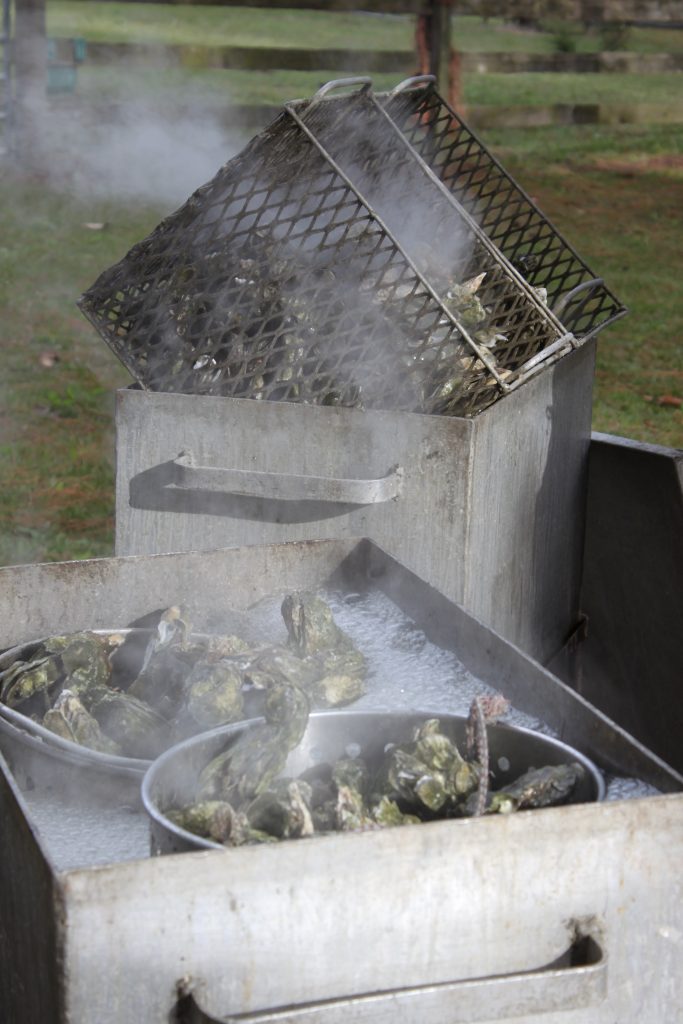


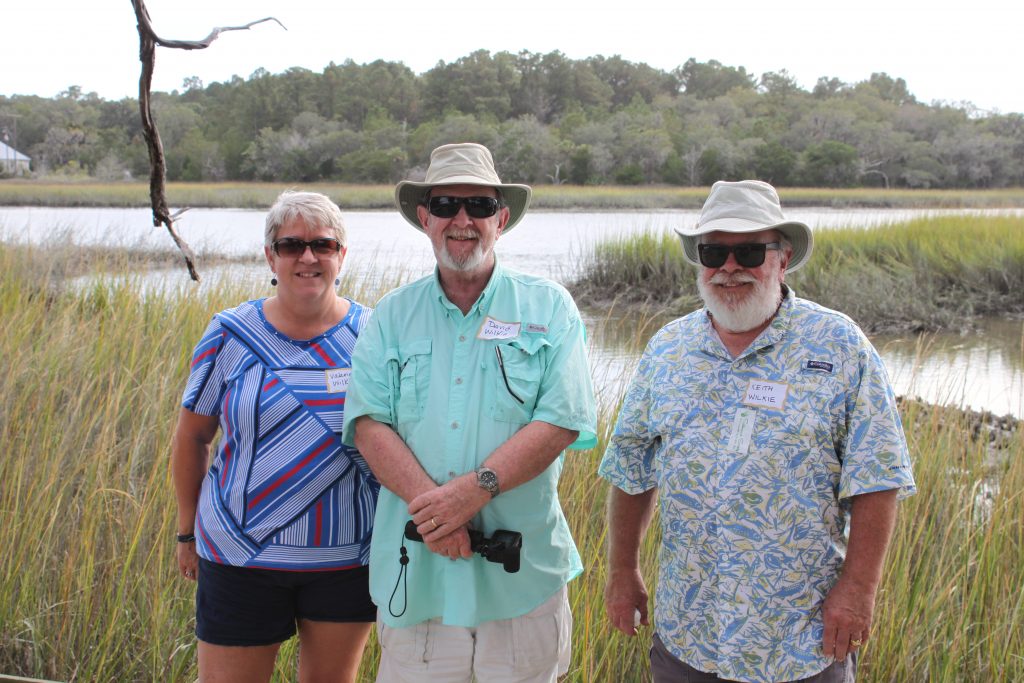
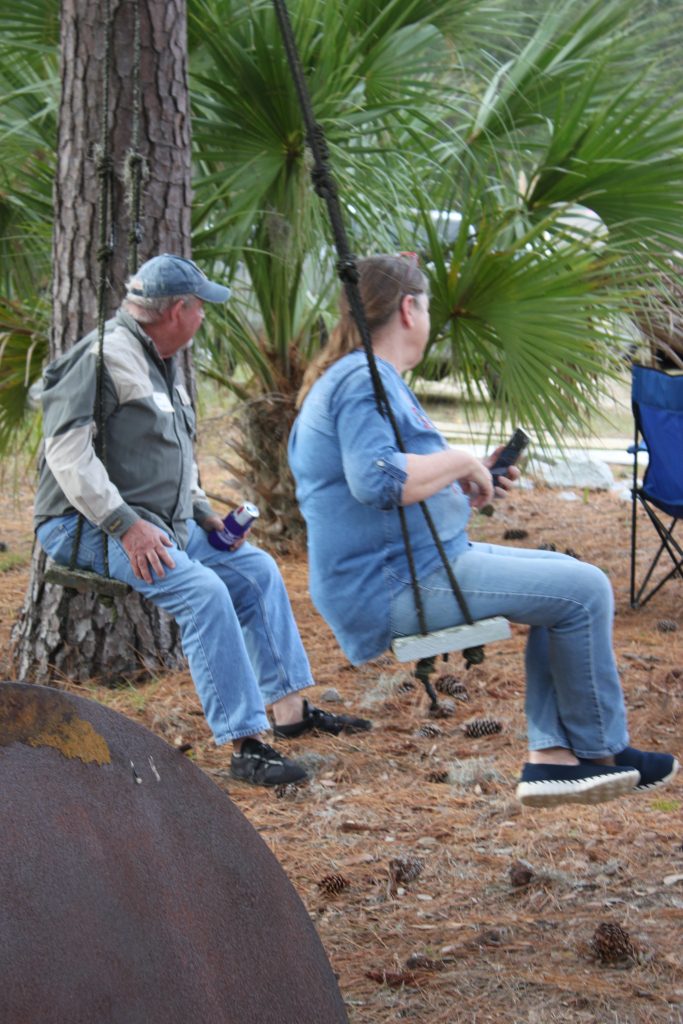
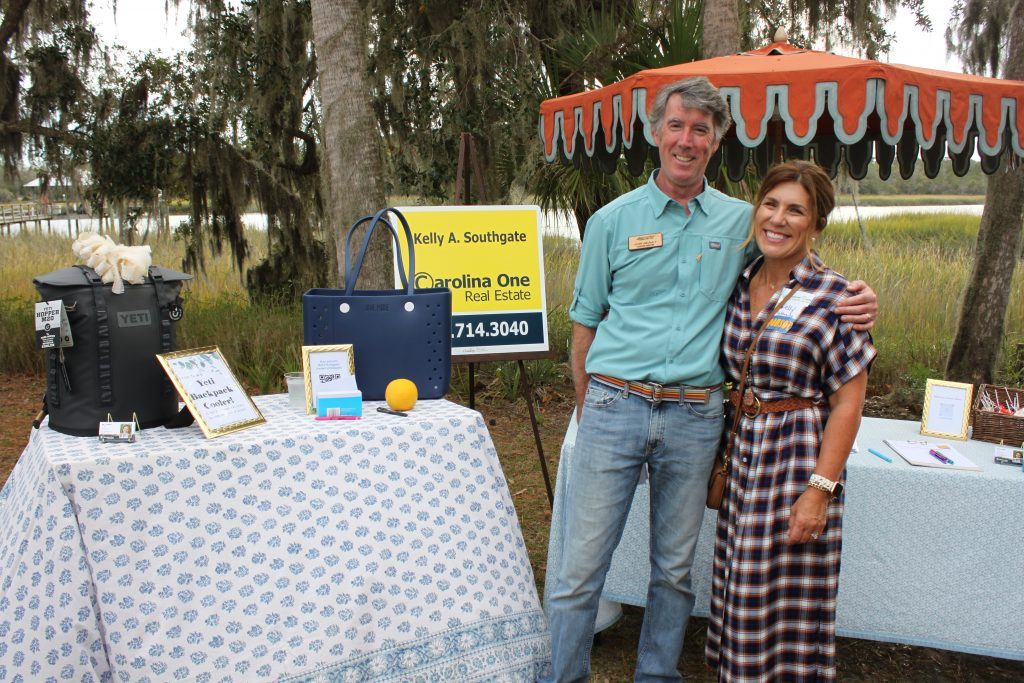


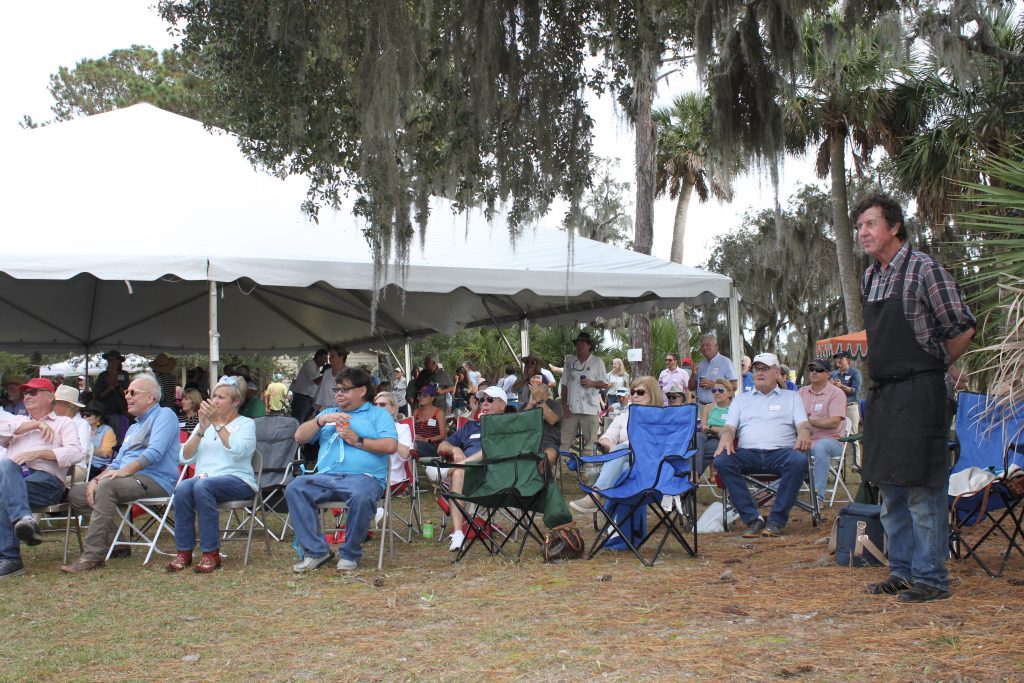
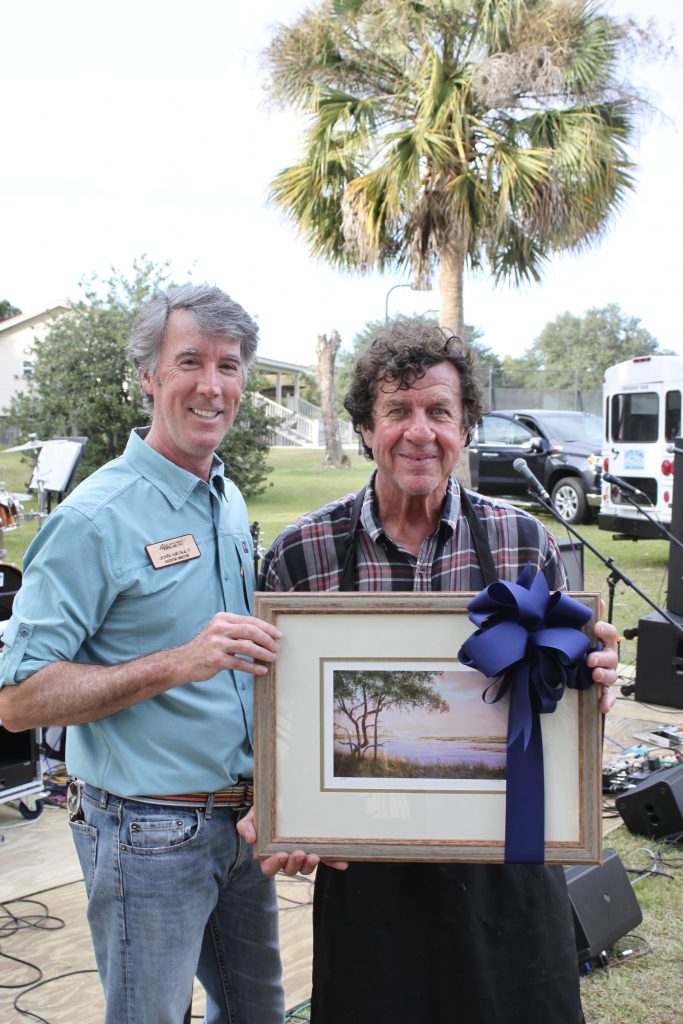

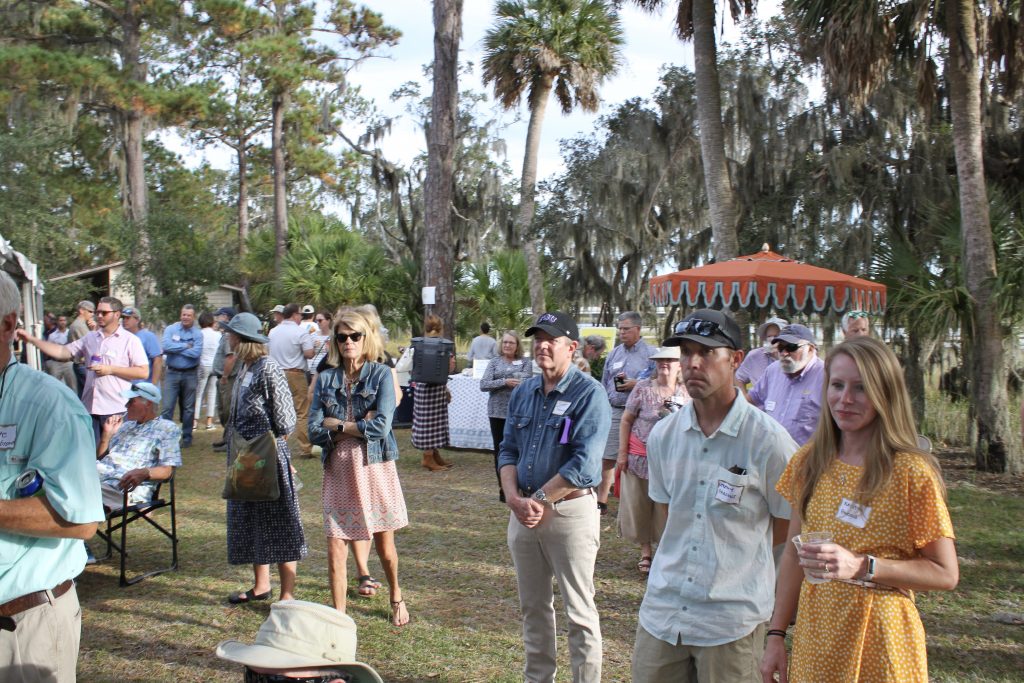

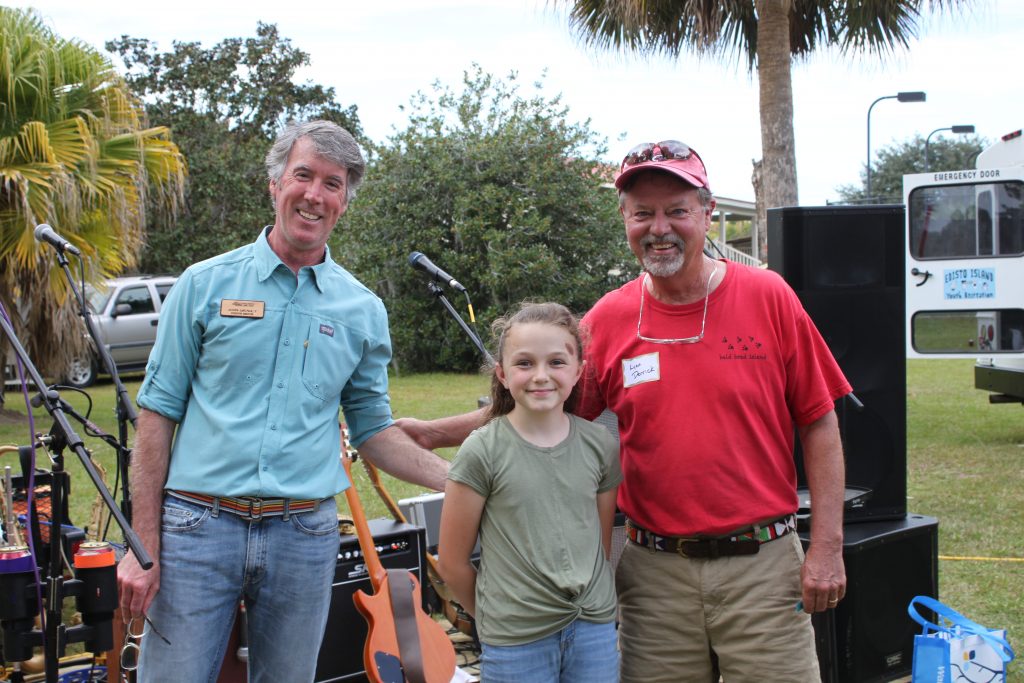
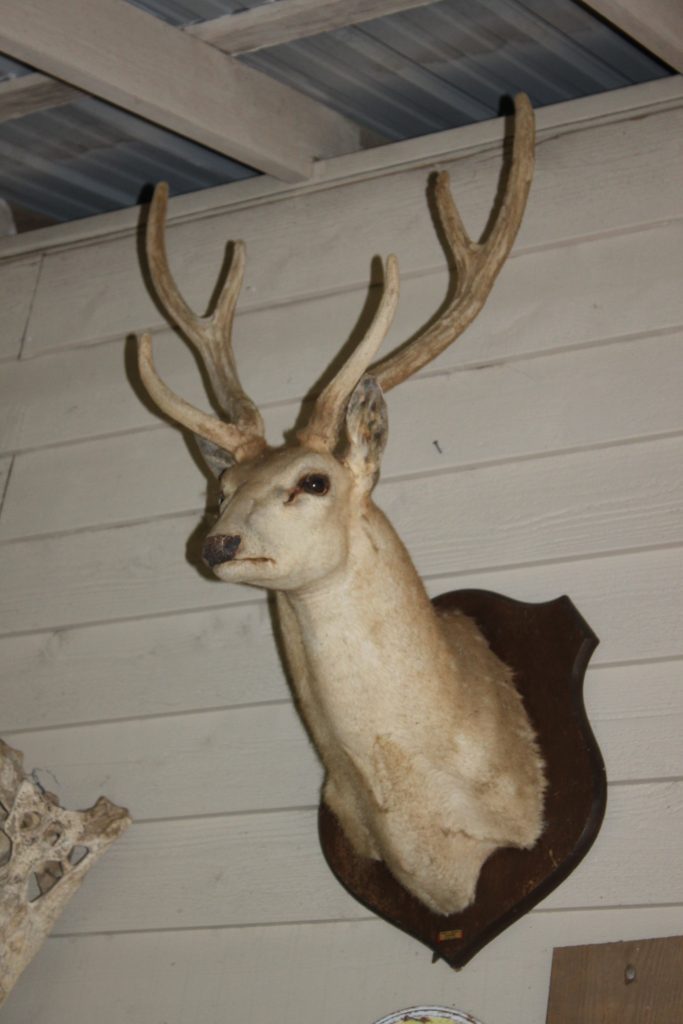





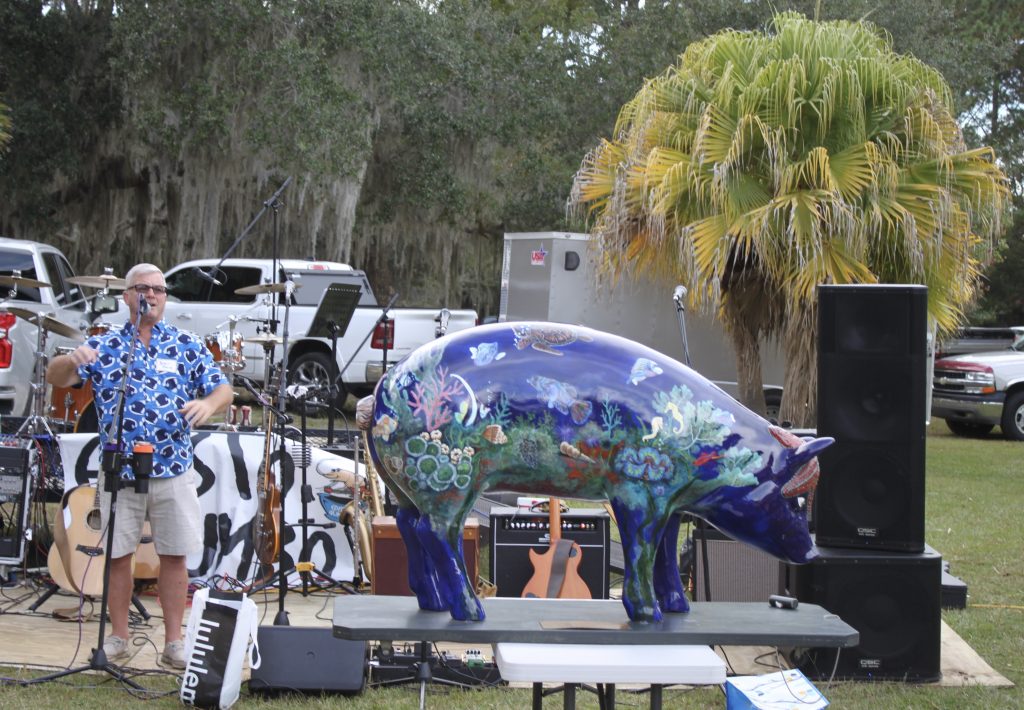
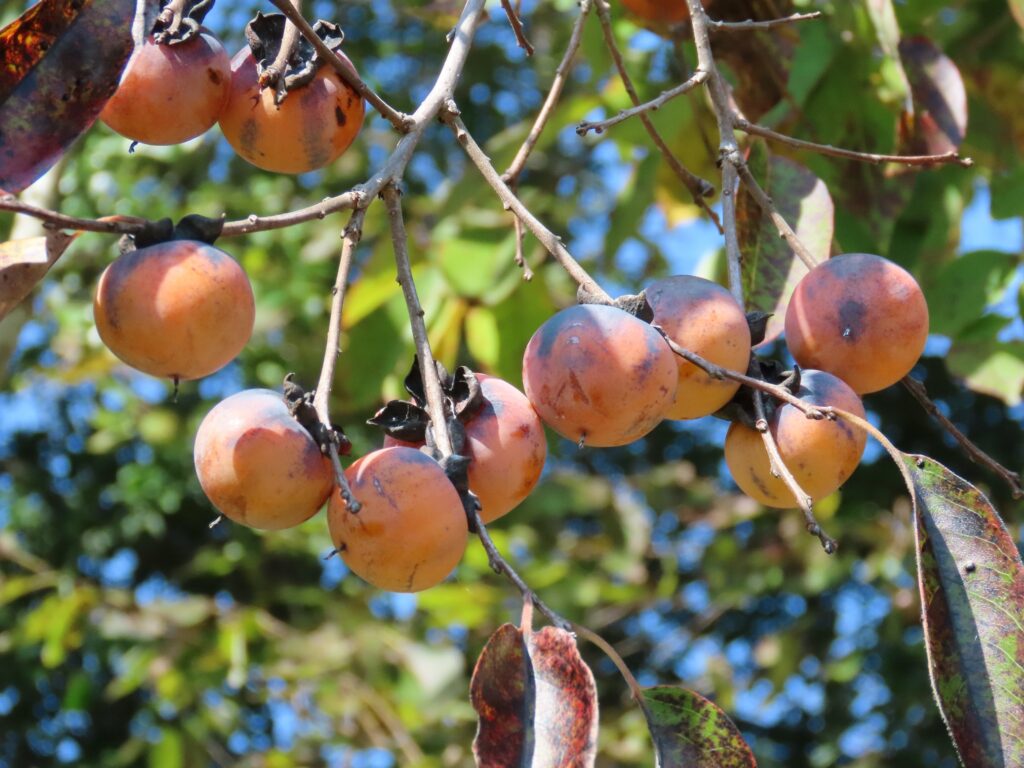
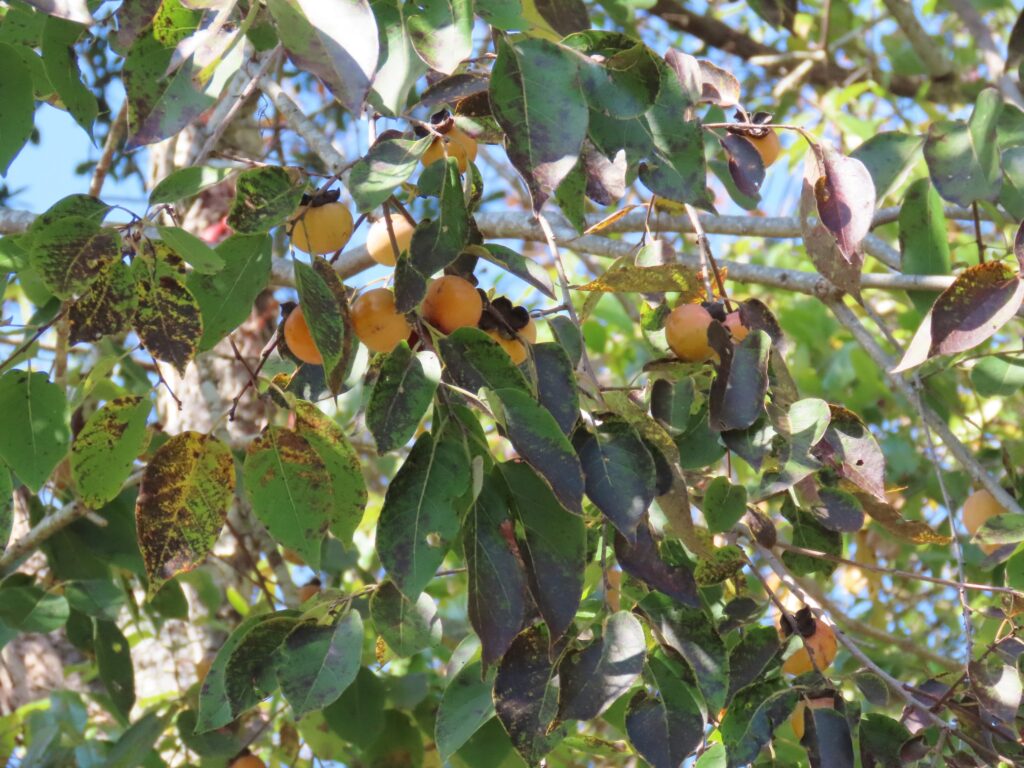
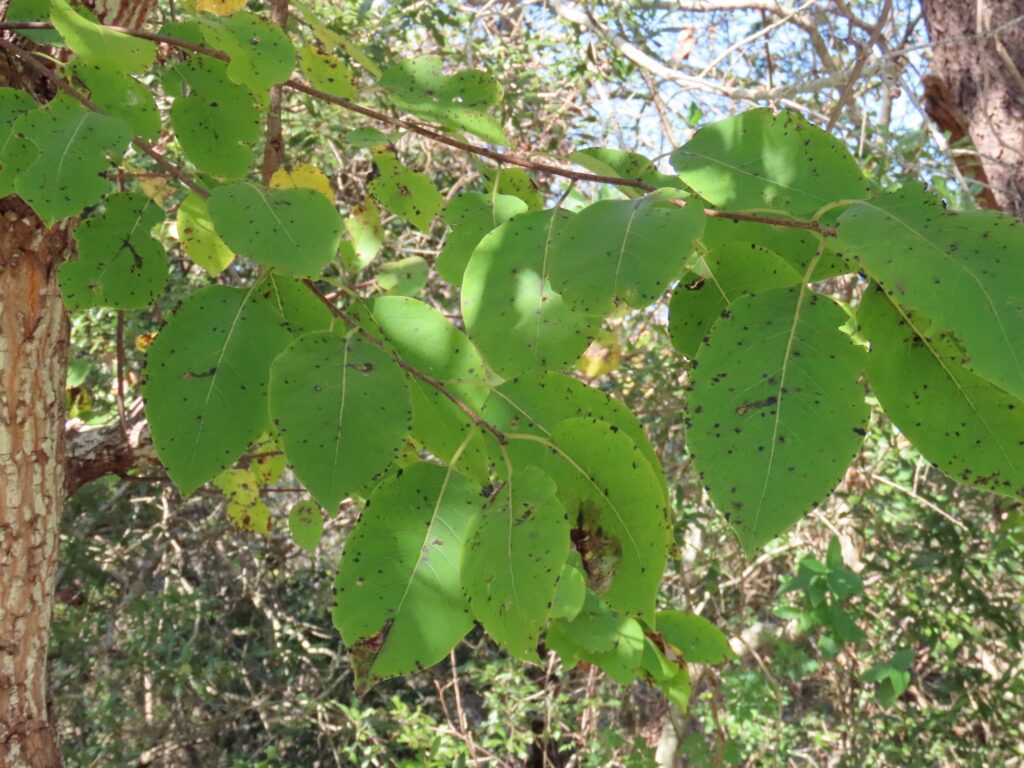
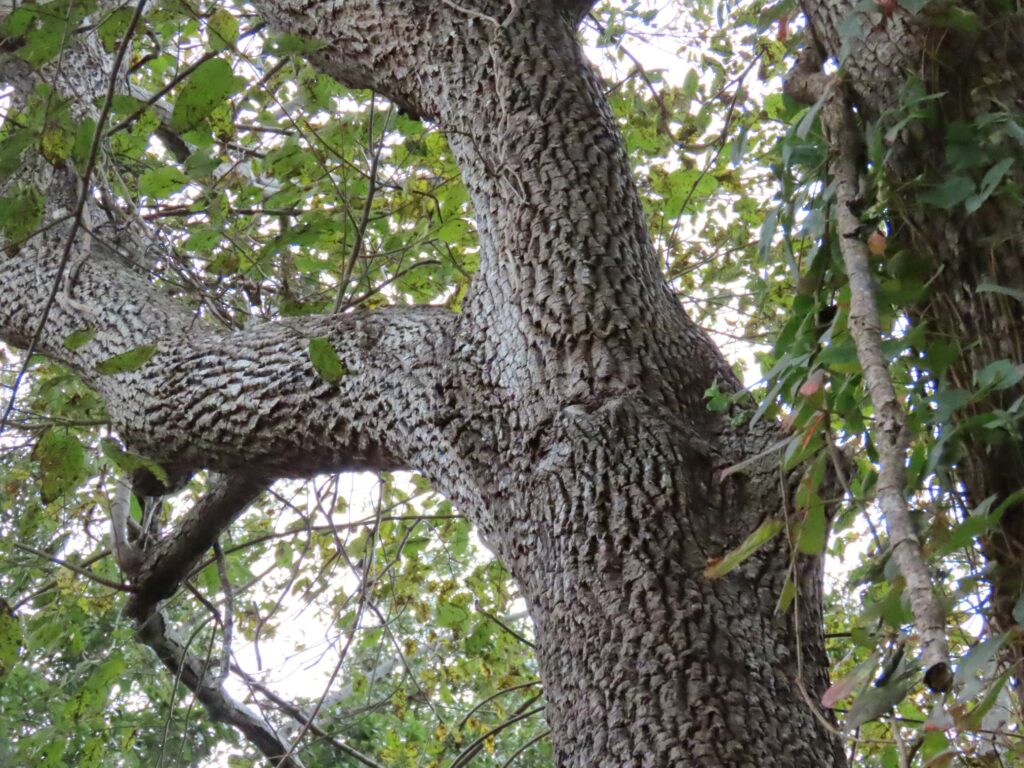
This week for Flora and Fauna Friday we have a sweet treat from the fall forest, American Persimmon (Diospyros virginiana).
American Persimmon is found throughout the southeastern United States. It’s usually a small to medium-sized tree which grows on a wide array of soil types. On Edisto Island, it’s commonly found on field rows, road sides, ditch edges, and coming up in fallow fields. In drier habitats and those with poor soils, it typically grows into a short and sometimes shrubby tree. On fertile soils with ample water, it can grow into a large canopy tree. American Persimmon is a tree that’s easy to identify. Its fairly large, simple, alternate, oval-shaped leaves resemble few other species here in the coastal plain. Persimmons also commonly get a leaf-spot disease here on the coast, which manifests as small black dots all over the tree’s leaves, and this symptom is so ubiquitous that it makes American Persimmon very easy to pick out at a glance. On a quick aside, Persimmon is also one of the host plants for the Luna Moth, whose caterpillar feeds on its leaves. In the winter Persimmon is still an easy one to pick out as it has unique bark, which is dark, almost black, gray-brown and deeply furrowed with a blocky appearance, and distinctive twigs, which are a warm brown, punctuated with little corky bumps, and bear small, black buds.
However, American Persimmon is easiest to identify in fall by its fruits. The fruit of our native Persimmon is a large berry, at about an inch across, and colored a rich blend of soft orange and red, darkening and reddening as it ripens, with a velvety sheen of silver on the skin. Inside this fruit are a handful of persimmon seeds, which are large, flat, and orange-brown in color. American Persimmons are incredibly productive fruit trees. In good years, a small wild Persimmon can be so laden with fruit as to break branches. Persimmon fruits are adored by an almost endless list of wildlife, including deer, foxes, mockingbirds, raccoons, box turtles, orioles, squirrels, cedar waxwings, coyotes, opossums, turkey, black bears, and the list goes on. American Persimmon is also very edible for people! When fully ripe, the fruit has a heavy honey-sweet flavor enrichened with a complex medley of intermingled fruity notes. A ripe persimmon is a uniform rose-red in color and mushy to the touch. However, when NOT fully ripe, the fruit is unbearably astringent due to its high tannin content, like red wine cranked up to eleven, which leaves your mouth feeling like it’s full of sawdust. That extreme astringency is harmless but practically intolerable. Finding a perfectly ripe Persimmon in the wild can be a challenge, given every critter in the woods is looking for one too. To get around this competition with wildlife, one can harvest not-quite-ripe persimmons and ripen them through a process called bletting. This was historically done by exposing the fruits to light frost for a few days. Nowadays and down here where we can’t rely on frost, this is most easily accomplished by placing the persimmons in a paper bag with a banana for a few days until they begin ripening and then, once close to ripe, storing them in the fridge (sans banana) for a week or so to blet them. One additional fact is that American Persimmon is a dioecious plant, meaning that there are both male and female trees. Male trees will never produce fruit and you can’t tell which kind of tree you have until they mature and flower. Female trees won’t produce fruit either unless there are male trees nearby to pollinate them. So if you’re interested in growing your own American Persimmon trees, you’ll need to plant a handful!

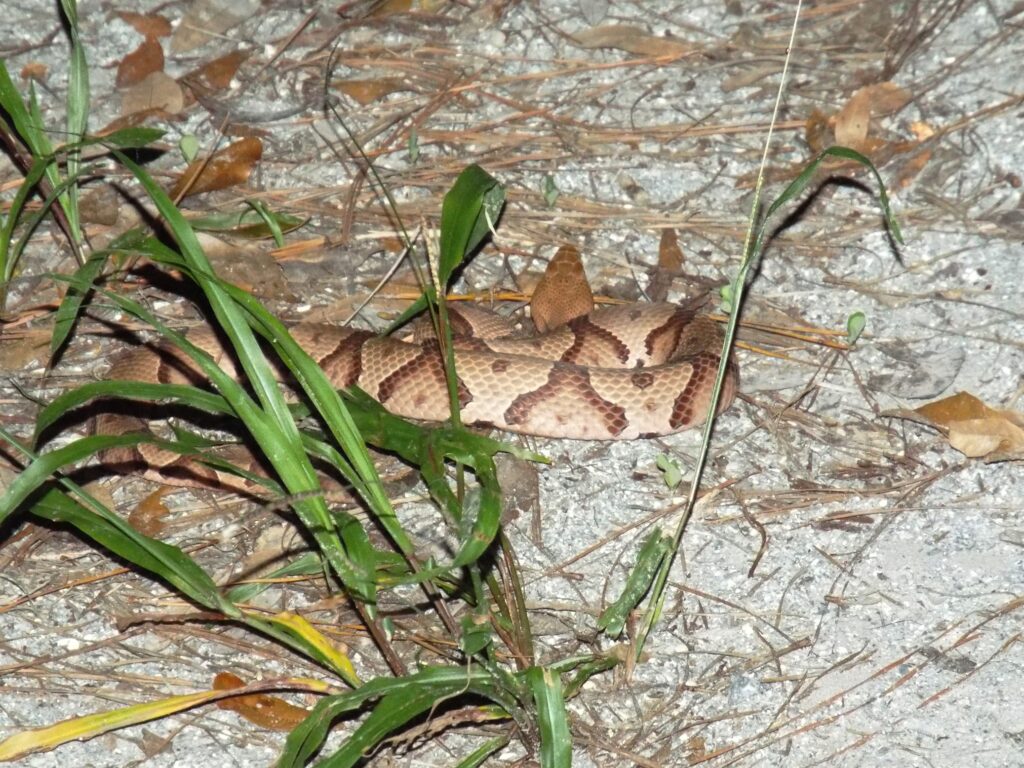
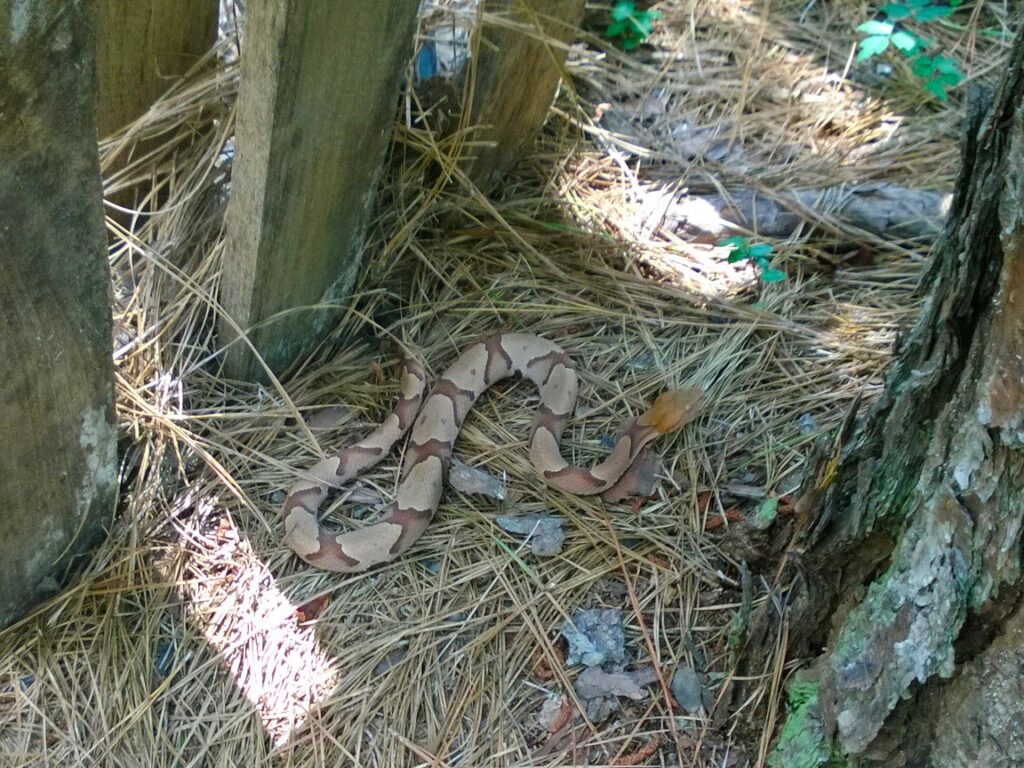
This week for Flora and Fauna Friday is a ruddy reptile with a terrible reputation, the Copperhead (Agkistrodon contortrix).
The Copperhead is our most common Viper on the Island and on the smaller end, averaging two feet in length. Their scales are a tan or copper-orange with dark “X”s down their back. They live in forests where they blend into the leaf litter or nestle under logs to ambush rodents, toads, and insects. Vipers are interesting for reptiles in that they give live birth. Rather than laying eggs, the eggs incubate inside their mother and she gives birth to wide-eyed and scaly-tailed baby snakes.
Copperheads are known for getting into trouble with us humans. Their favorite hidey-holes are underneath something next to a structure and we like to leave somethings lying all around our structures. This is compounded by an instinctual danger reflex unique to Copperheads. When surprised they freeze and let their camouflage hide them, remaining motionless until touched. When touched they assume their cover is blown and go straight to fangs. This preference for getting into our stuff and not letting us know they’re there is the reason why Copperheads account for the vast majority of venomous snake bites in South Carolina. Luckily, Copperheads often dry-bite, injecting no venom, and their venom is the weakest of our Vipers. Healthy adult humans can typically survive their bite without antivenin. However, I wouldn’t roll that dice. One should always seek immediate medical attention if bitten by a venomous snake.